Refraction through a Lens Solutions for Class 10 Physics ICSE Board (Concise - Selina Publishers)
Free download of step by step solutions for class 10 Physics chapter 5 - Refraction through a Lens of ICSE Board (Concise - Selina Publishers). All exercise questions are solved & explained by an expert teacher and as per ICSE board guidelines.
Access ICSE Selina Solutions for Class 10 Science(Physics) Chapter 5 - Refraction through a Lens
1. What is a lens?
Ans: A lens is a piece of transparent substance that is usually of glass and has two opposite surfaces either the surfaces are curved or one surface is curved.
2. Name the two kinds of lens? Draw diagrams to illustrate them.
Ans: There are two types of lenses which are given as follows:
(i) Convex or converging lens
(ii) Concave or diverging lens
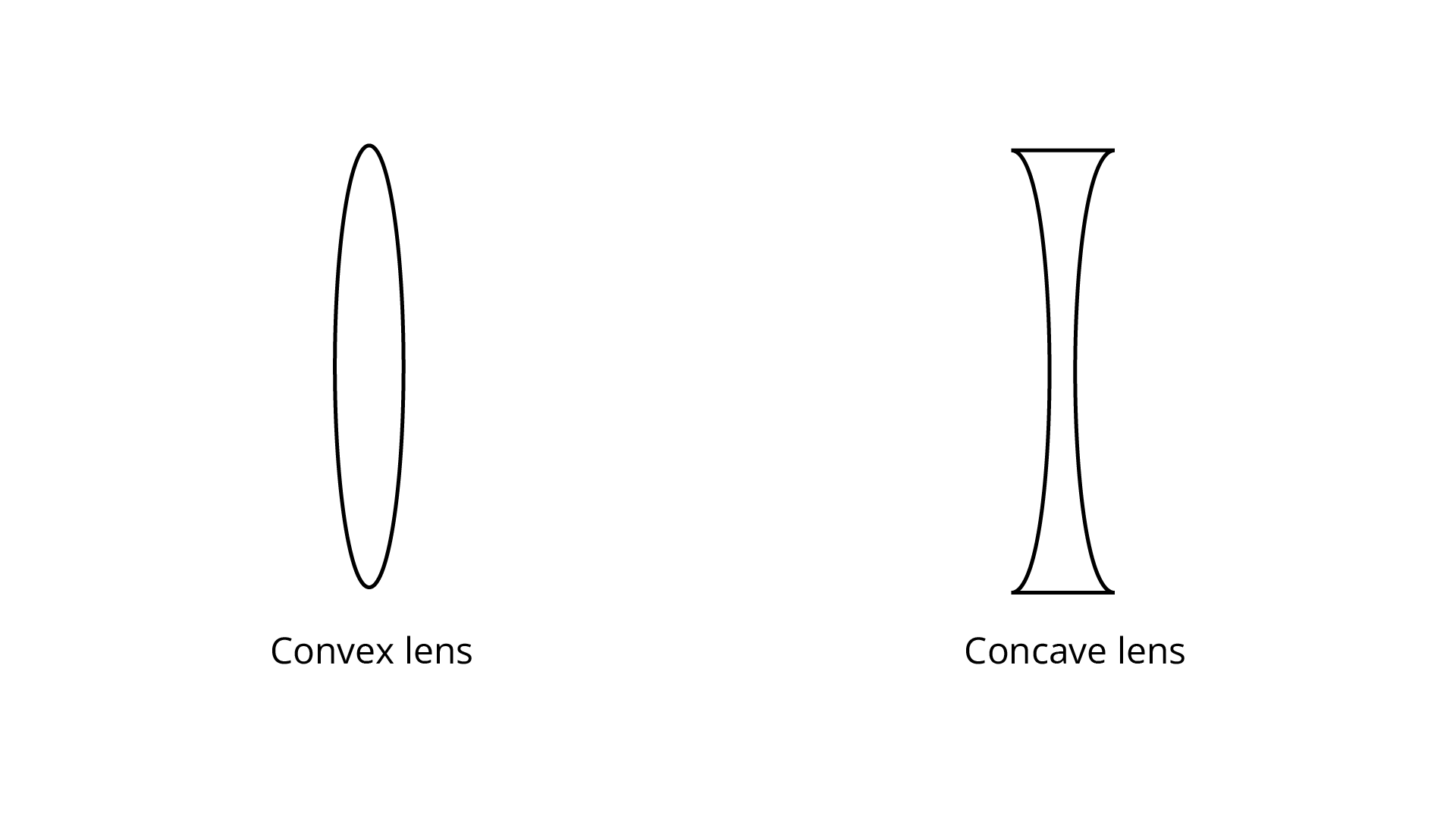
3. Which lens is converging:
i. An equiconvex lens or an equiconvex lens?
Ans: An equiconvex lens is converging.
ii. A concavo-convex lens or a convexo-concave lens?
Ans: A concavo-convex lens is a converging lens.
4. State the difference between a convex and a concave lens in there, appearance, and action on the incident light.
Ans:
The difference is as follows:
Concave Lens | Convex Lens | ||
|---|---|---|---|
1 | This lens is thin in the middle and thick at its periphery. | 1 | This lens is thick in the middle and thin at its periphery. |
2 | This lens diverges the incident rays away from the principal axis. | 2 | This lens converges the incident rays towards the principal axis. |
3 | This lens has virtual focus. | 3 | This lens has real focus. |
5. Out of the two lenses, one concave and the other convex, state which one will show the divergent action on a light beam. Draw a diagram to illustrate your answer.
Ans: The concave lens will show the divergent action on a light beam:
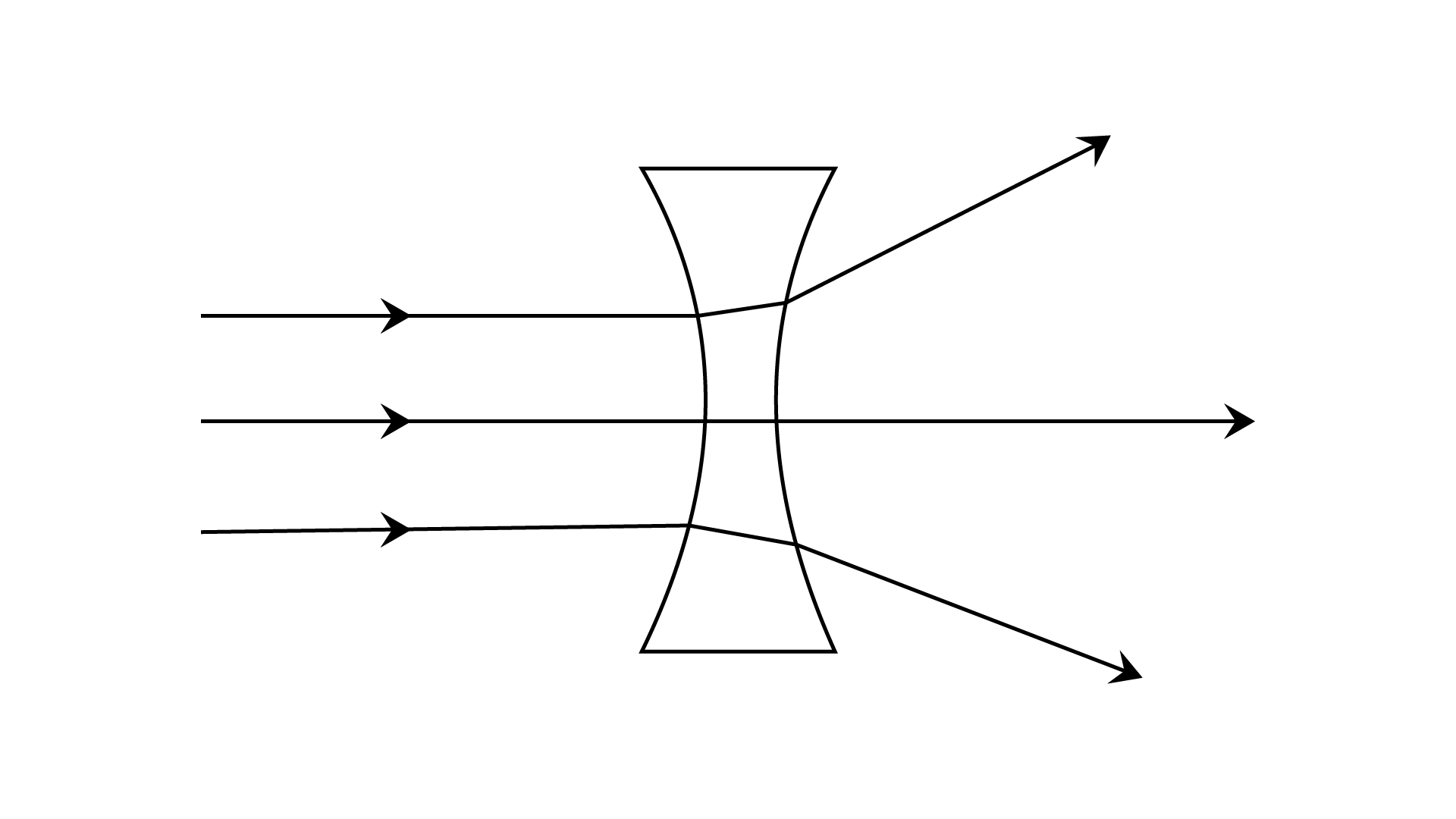
6. Show by a diagram the refraction of two light rays incident parallel to the principal axis on a convex lens by treating it as a combination of a glass slab and two triangular glass prisms.
Ans: The below-mentioned figure shows the convex lens which contains two glass prisms and one glass slab. The one glass prism is situated above the glass slab while the other glass prism is below the glass slab.
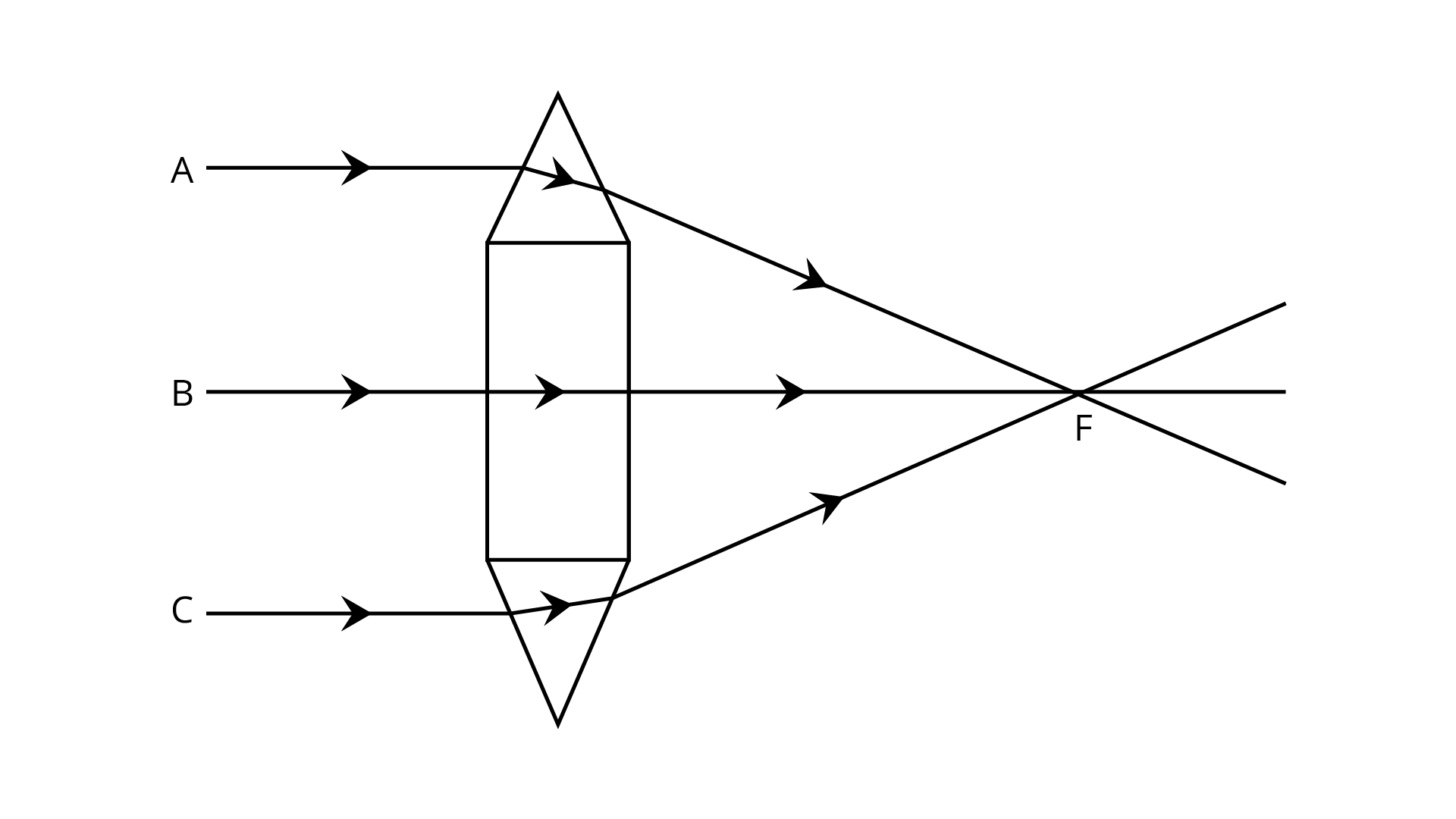
7. How does the action of a convex lens differ from that of a concave lens on a parallel beam of light incident on them? Draw diagrams to illustrate your answer.
Ans: When a parallel beam of light is incident on a convex lens then the prism in the upper part bends the incident ray downwards while the prism in the lower part bends the incident ray upwards. The central part which is parallel to the sided glass slab passes the ray undeviated.
In the concave lens the upper part of the lens bends the incident ray upwards and the lower part bends the incident ray downwards while the central part, which is a parallel to the sided glass slab, passes the ray undeviated.
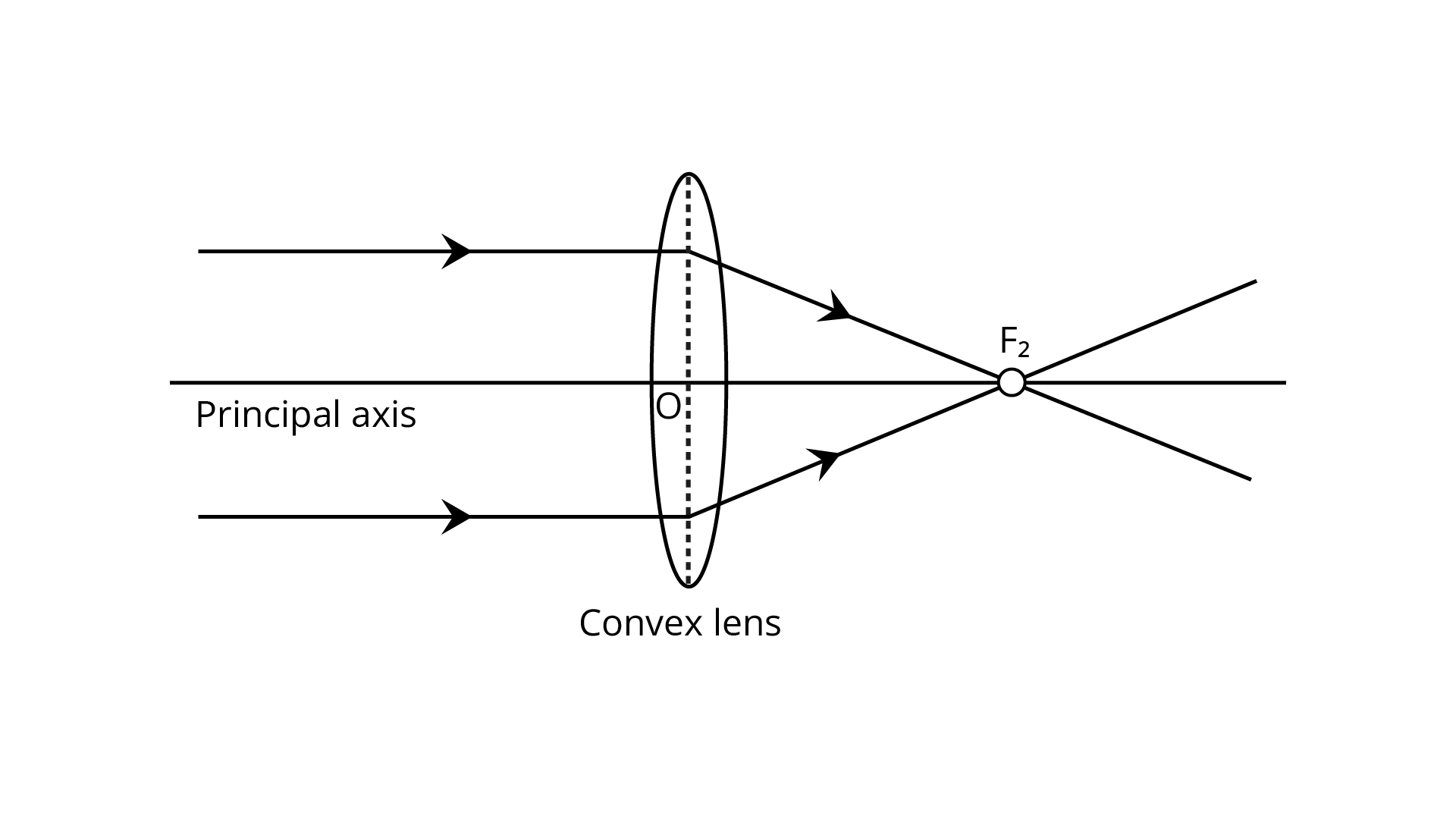
8. Explain the optical center of a lens with the help of proper diagram(s).
Ans: The optical center is a point on the principal axis of the lens such that a ray of light passing through this point emerges parallel to its direction of incidence.
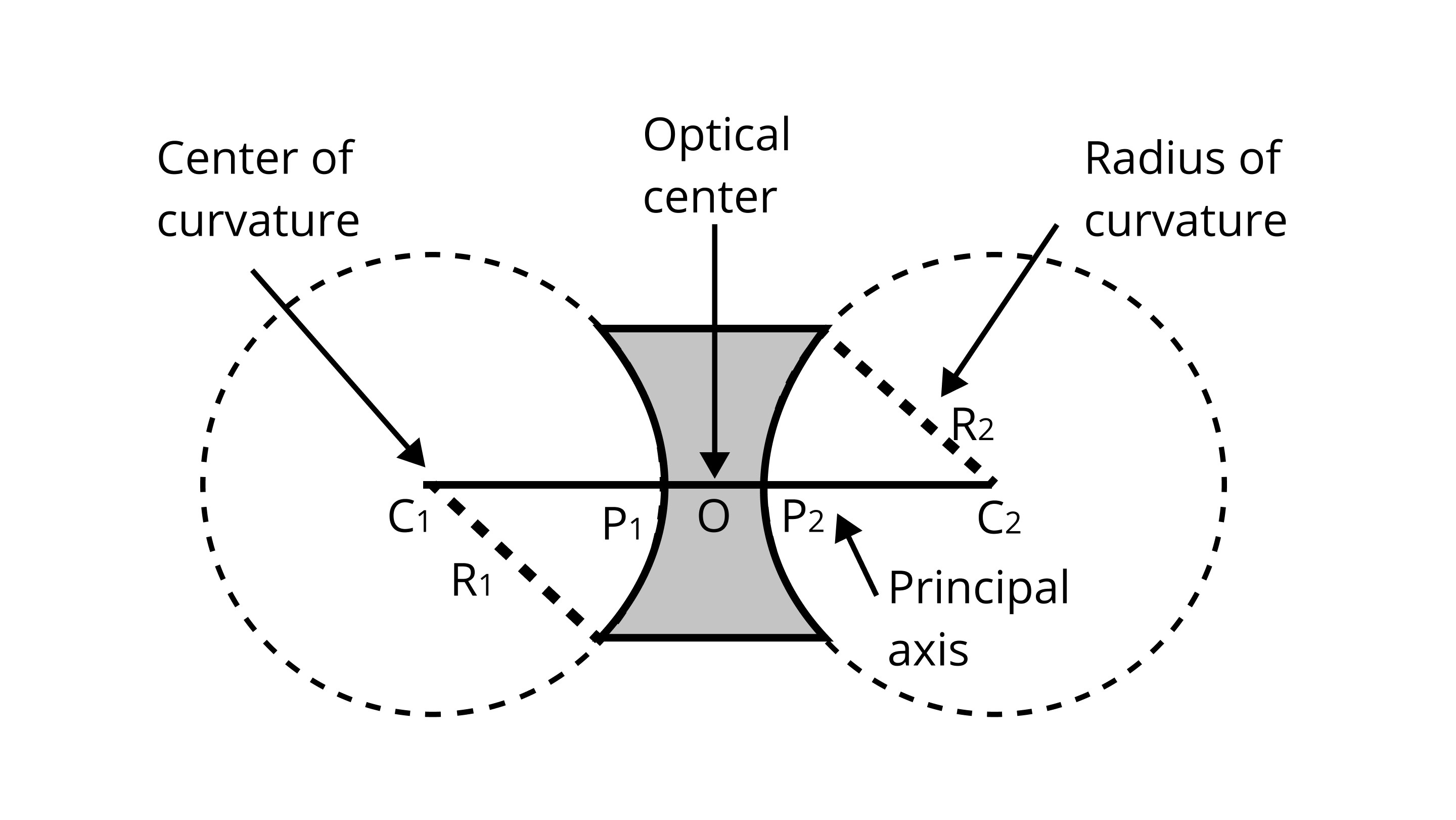
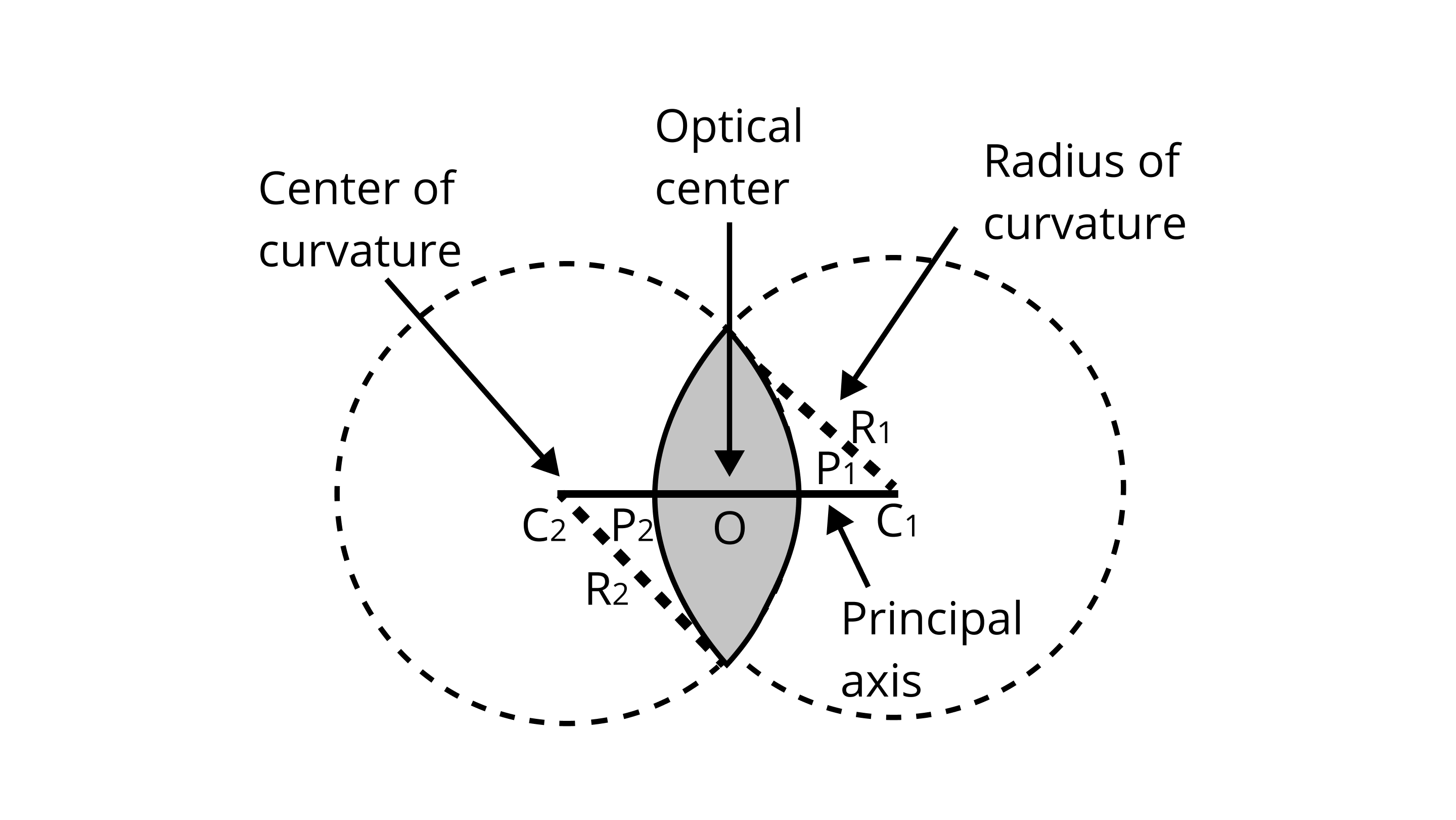
It is marked by the letter O in the above figure. The optical center is therefore the center of the lens.
9. A ray of light after refraction through a lens emerges parallel to the principal axis of the lens. The incident ray either passes through:
(a) its optical center
(b) its first focus
(c) its second focus
(d) its center of curvature of the first surface
Ans: A ray of light after refraction through a lens emerges parallel to the principal axis of the lens. The incident ray passes through its first focus. Hence the correct answer is option b.
10. Show by a diagram the refraction of two light rays incident parallel to the principal axis on a concave lens by treating it as a combination of a glass slab and two triangular glass prisms.
Ans: The below-mentioned figure shows the concave lens which contains two glass prisms and one glass slab. One of the glass prisms is situated above the glass slab while the other is below the glass slab.
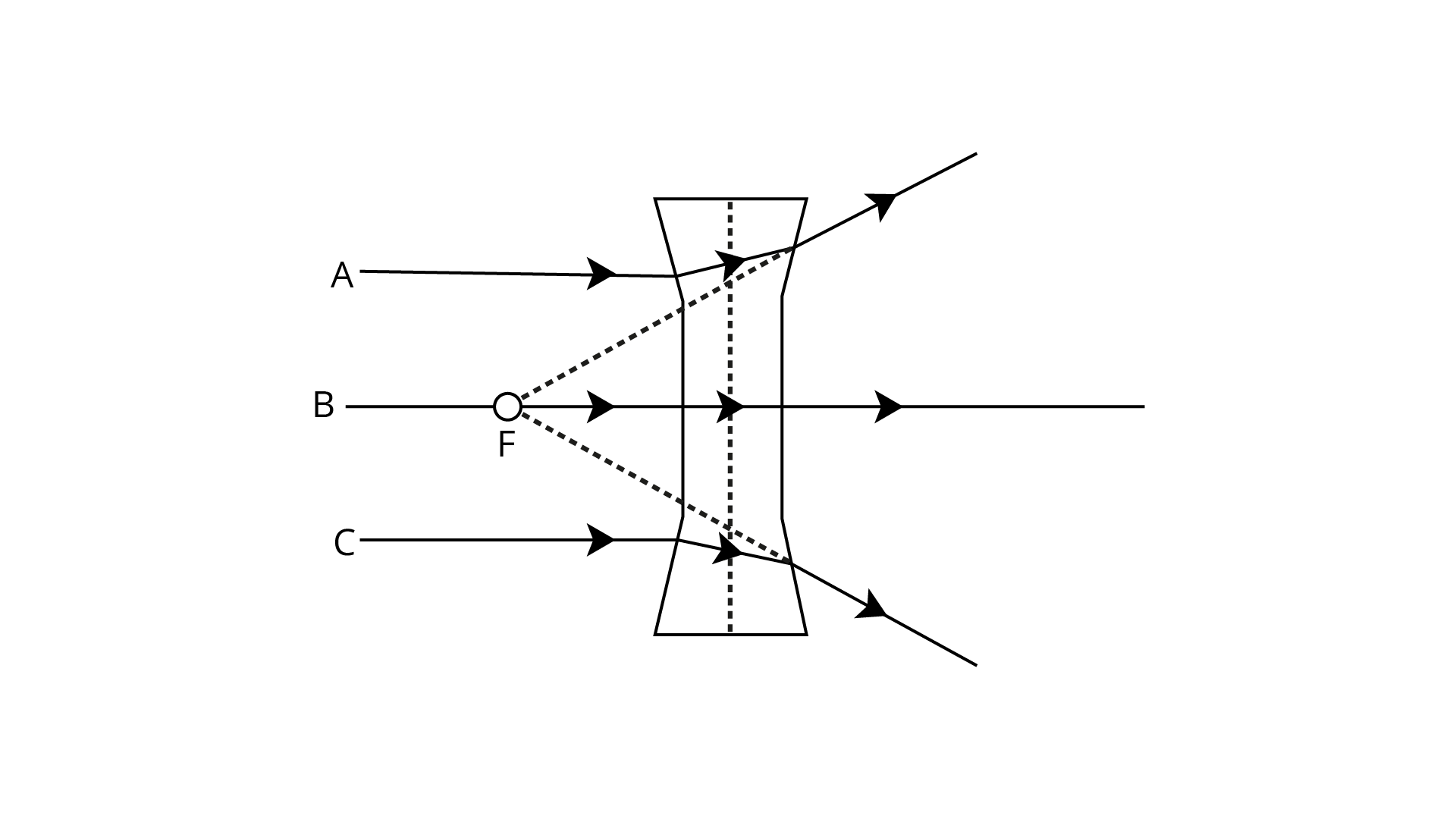
11. A ray of light incident at a point on the principal axis of a convex lens passes undeviated through the lens.
(a) What special name is given to this point on the principal axis?
Ans: This point on the principal axis is called the optical center.
(b) Draw a labeled diagram to support the answer in part (a).
Ans:
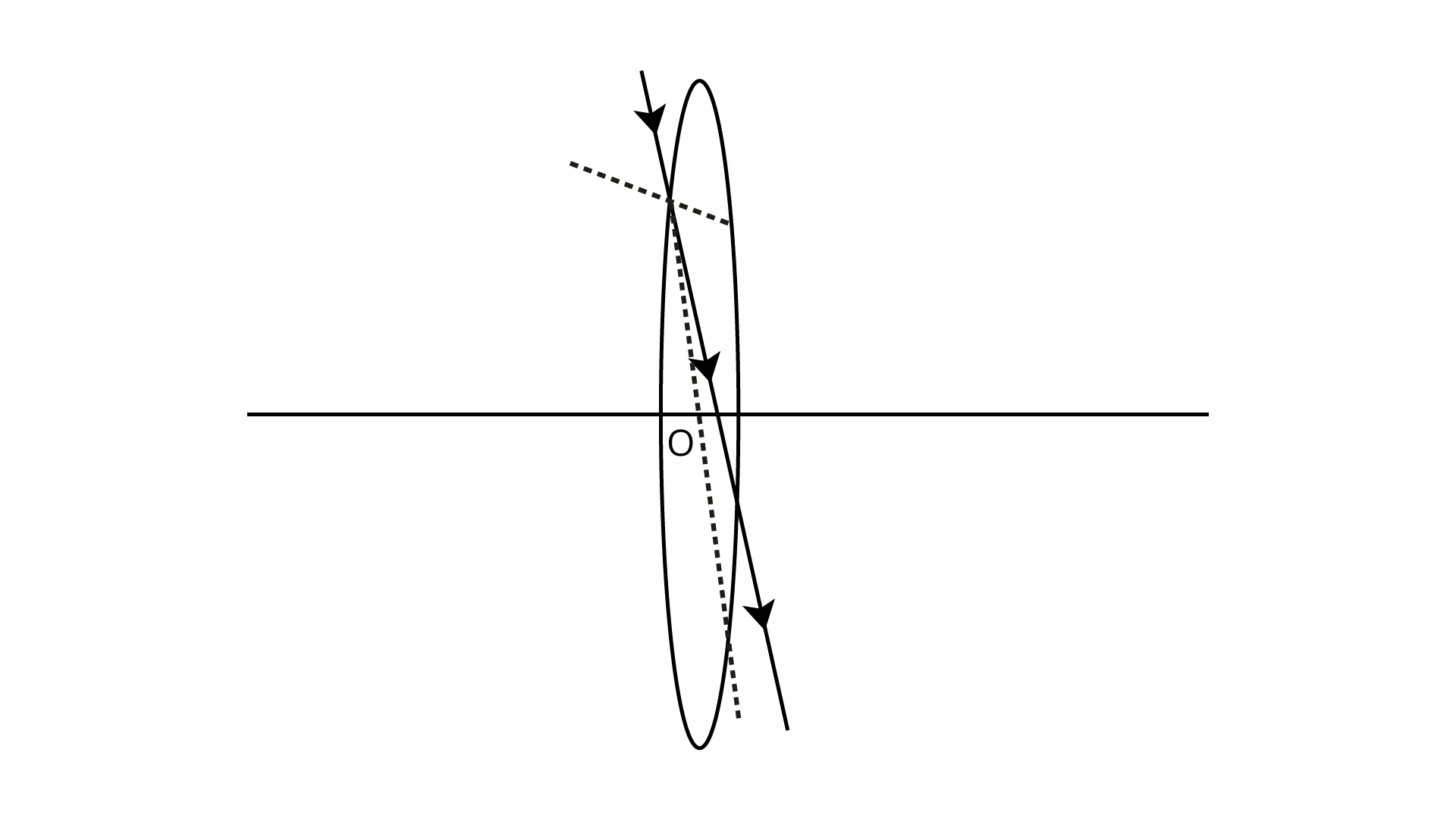
12. Define the term focal length of a lens.
Ans: The distance of the focus from the optical center of the lens, is called as its focal length.
13. Define the term principal foci of a convex lens and illustrate your answer with the aid of proper diagrams.
Ans: The light ray can pass through a lens from either side. Therefore a lens has two principal foci, one on either side of the lens. For a convex lens, the first focal point is a point F1 on the principal axis of the lens such that the rays of light coming from it, after the refraction through the lens, become parallel to the principal axis of the lens.
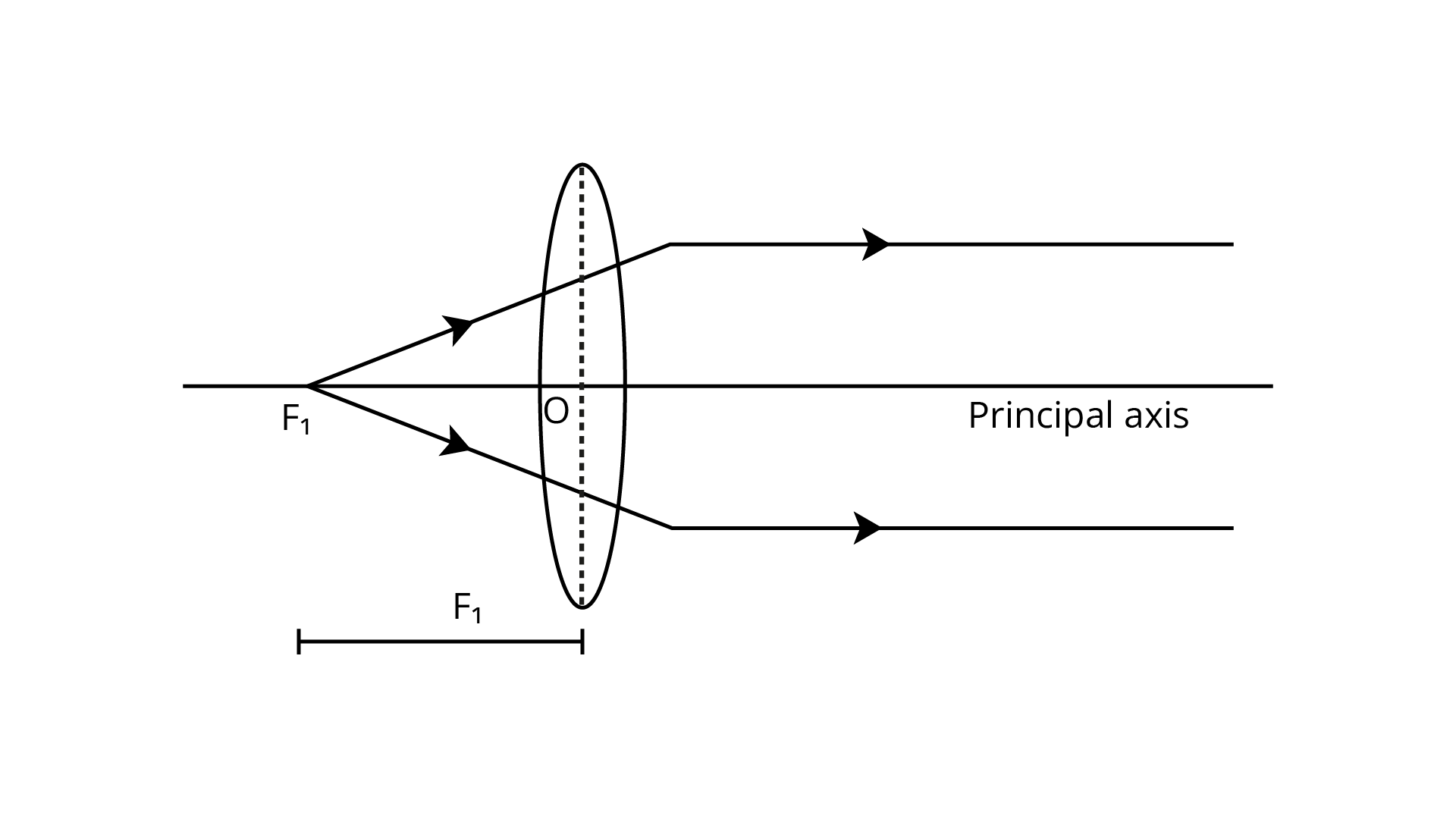
14. Define the term principal foci of a concave lens and show them with the help of proper diagrams.
Ans: The light ray can pass through a lens from either side. Therefore a lens has two principal foci. For a concave lens, the first focal point is a point F1 on the principal axis of a lens such that the incident rays of the light appear to meet at it, after the refraction from the lens become parallel to the principal axis of the lens.
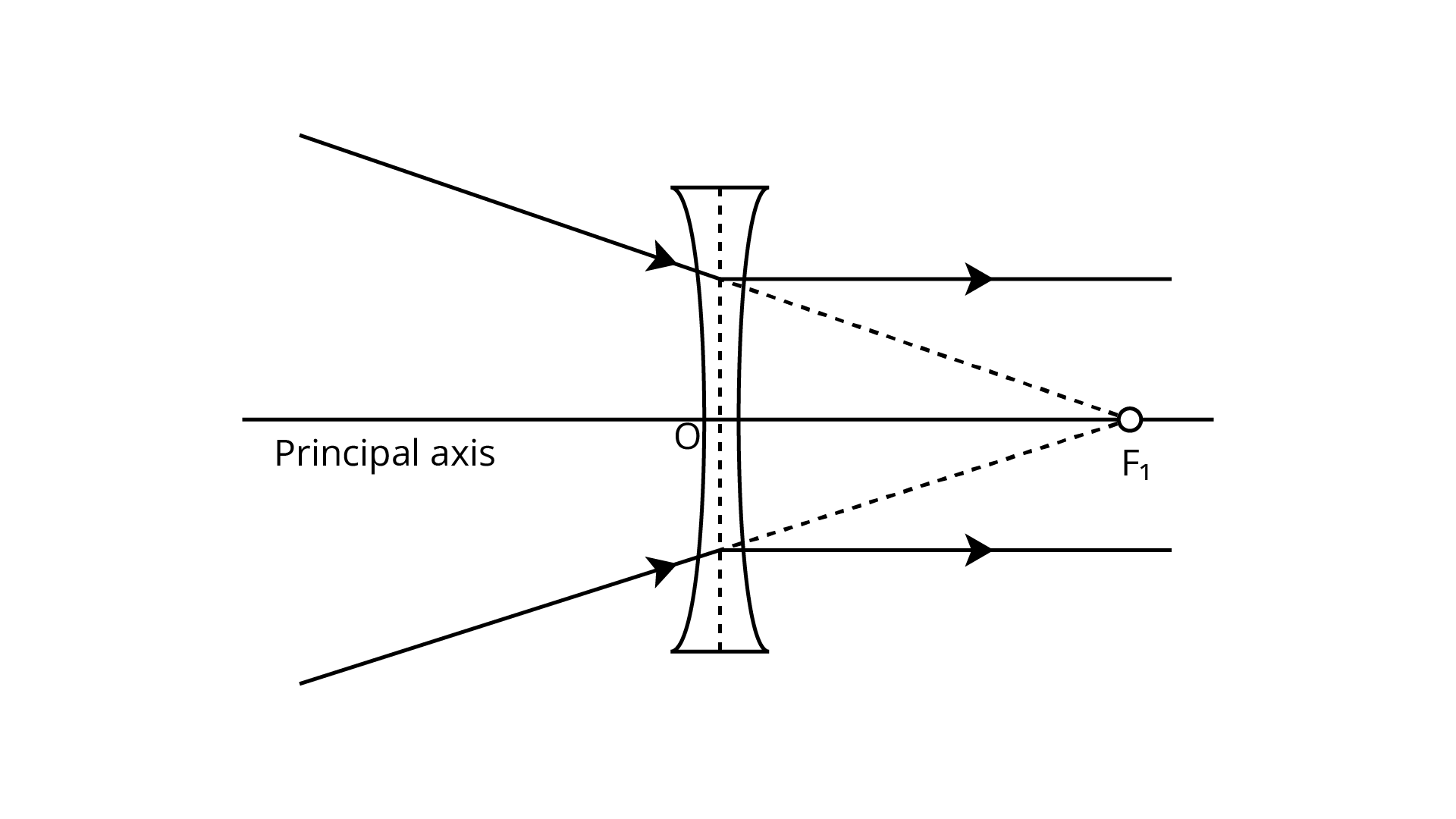
15. Draw a diagram to represent the second focus of a concave lens.
Ans:
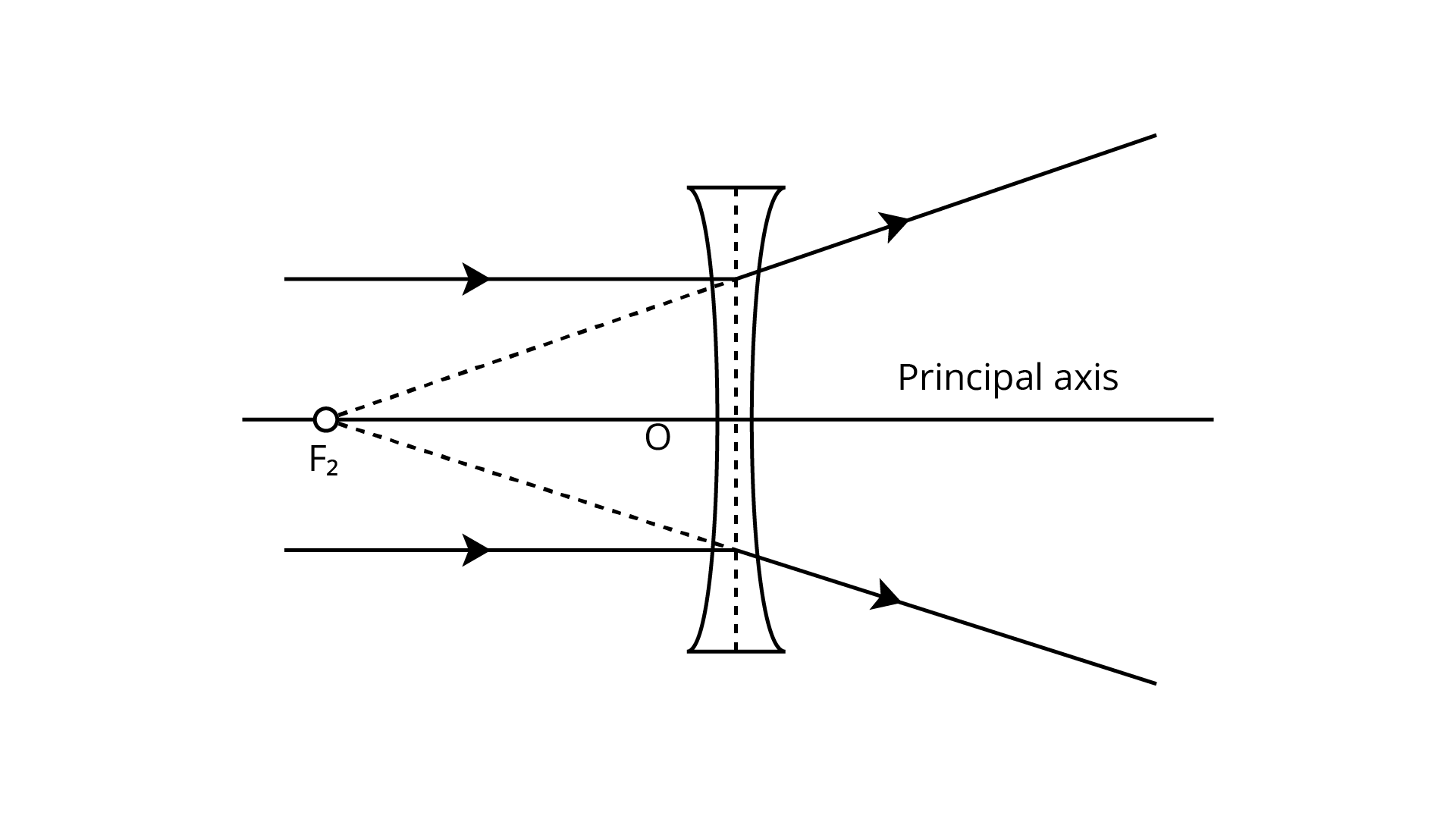
16. Draw a diagram to represent the second focus of a convex lens.
Ans:
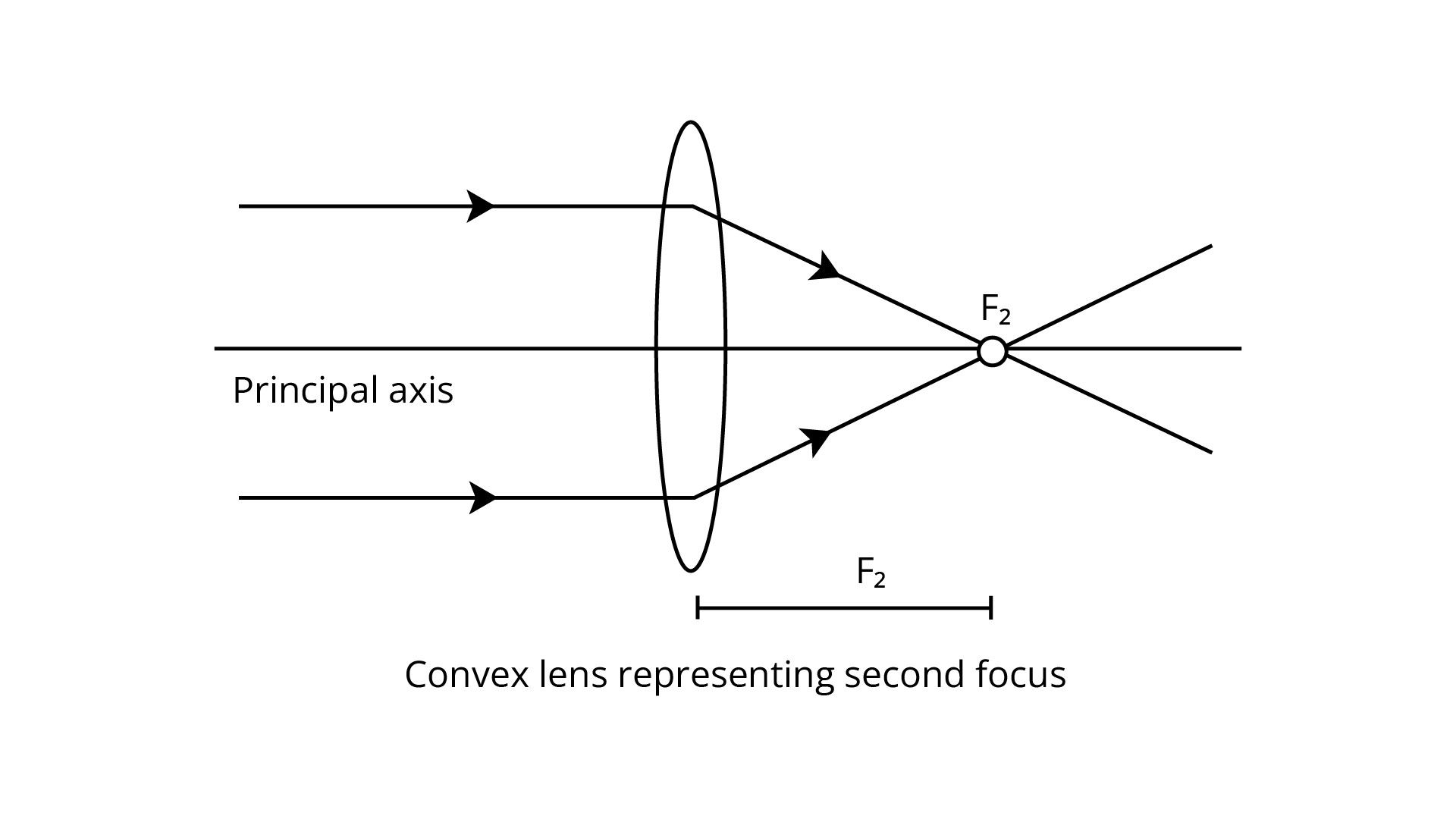
17. A ray of light, after refraction through a concave lens emerges parallel to the principal axis.
(a) Draw a ray diagram to show the incident ray and its corresponding emergent ray.
Ans:

(b) The incident ray when produced meets the principal axis at a point F. Name the point F.
Ans: The point F is the first focus when the produced incident ray meets the principal axis at a point F.
18. A beam of light incident on a convex lens parallel to its principal axis converges at a point F on the principal axis. Name the point F. Draw a ray diagram to show it.
Ans: Point F is called as the second focus.
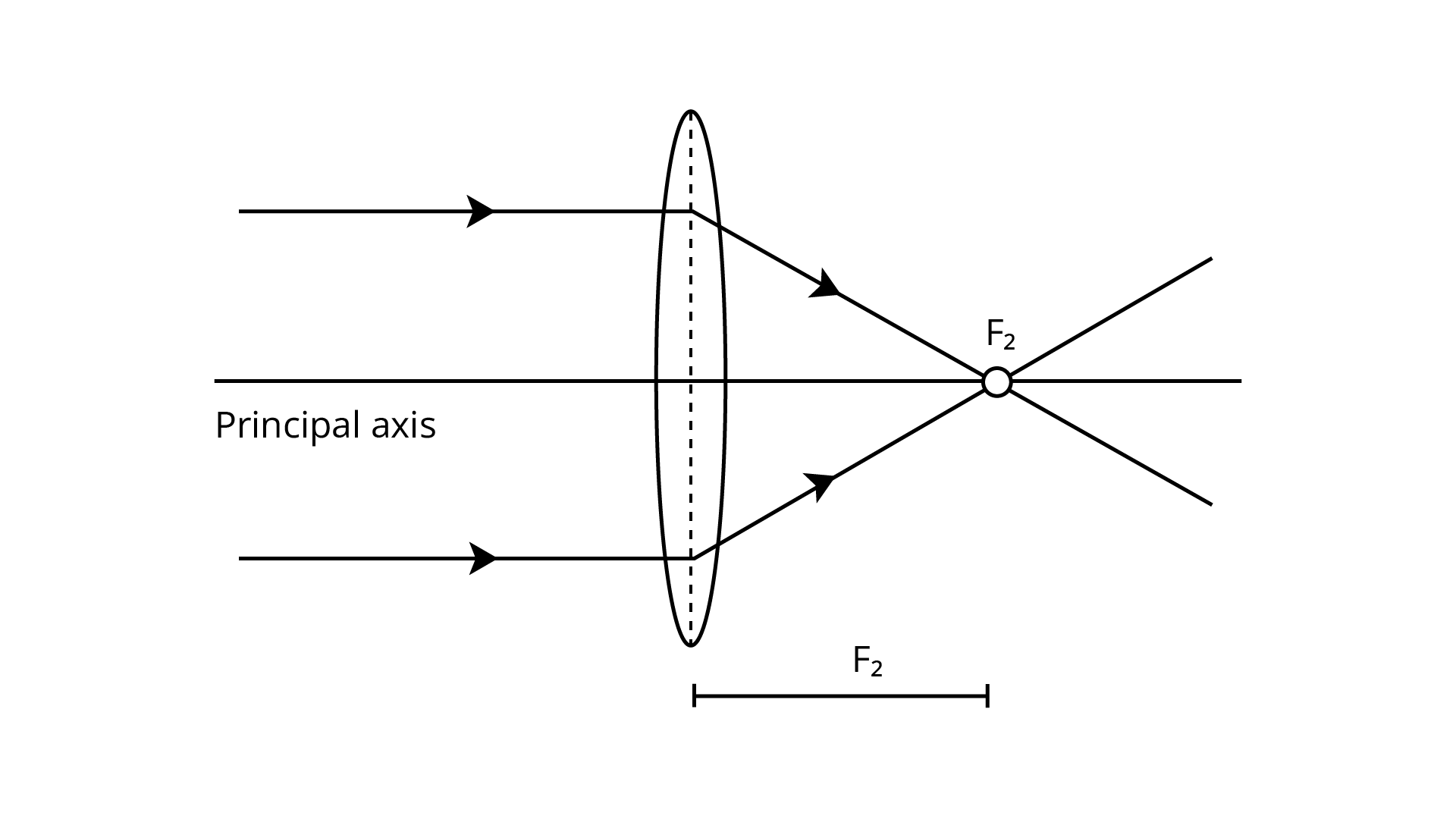
19. A beam of light incident on a thin concave lens parallel to its principal axis diverges and appears to come from a point F on the principal axis. Name the point F. Draw a ray diagram to show it.
Ans: Point F appears to come from the second focus:
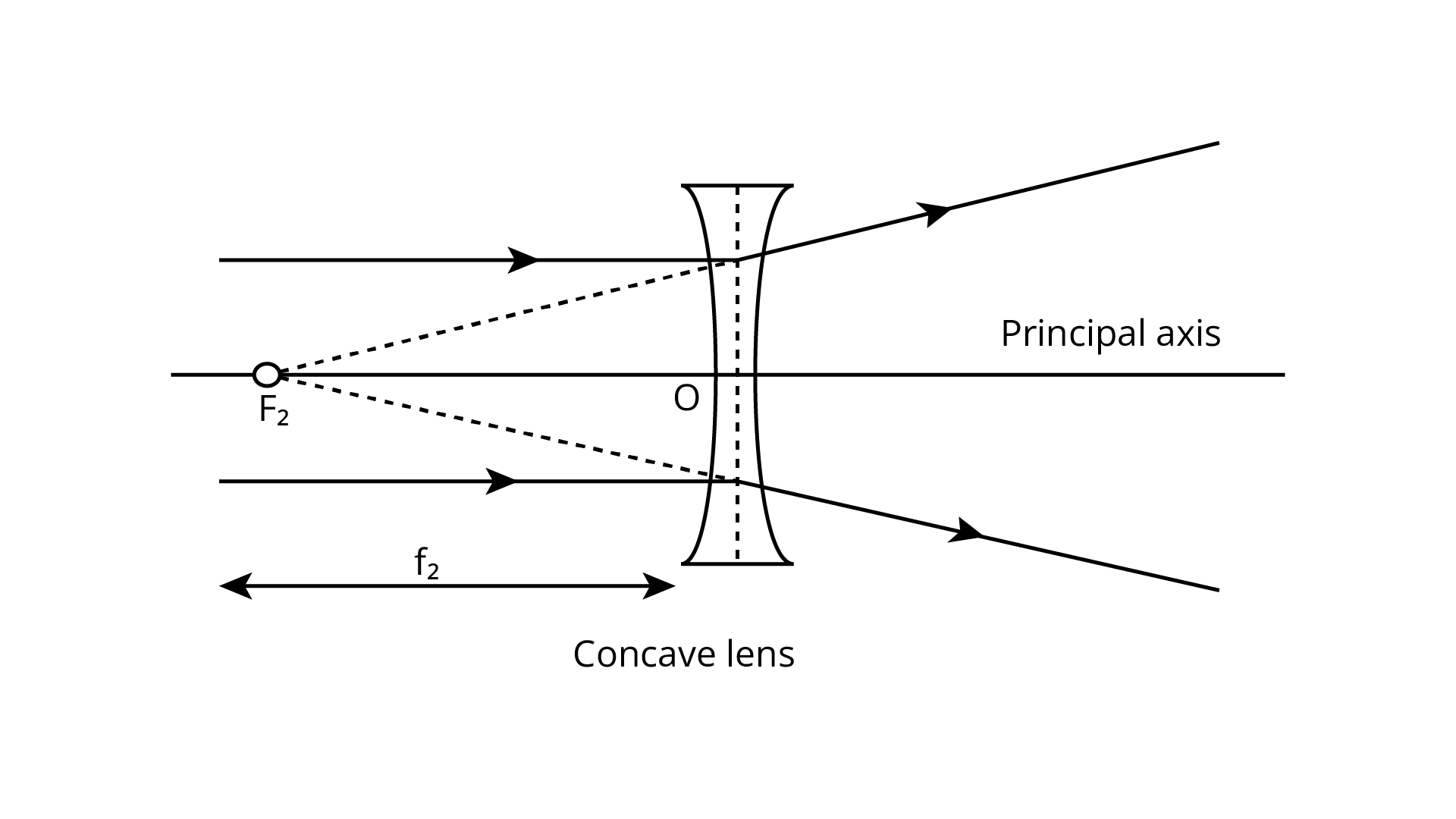
20. State the condition when a lens is called an equiconvex or equi-concave.
Ans: The lens is an equiconvex or equi-concave lens when the radii of the curvature of both the surfaces are equal.
21. What do you mean by the focal plane of a lens?
Ans: If a plane is normal to the principal axis and passes through the focus then this plane is called the focal plane of a lens.
22. State the condition for each of the following:
(i) A lens has both its focal lengths equal.
Ans: A lens has both its focal lengths equal when the medium is the same on either side of the lens.
(ii) A ray passes undeviated through the lens.
Ans: A ray passes undeviated through the lens when the ray is the incident at the optical center of the lens.
23. The parallel oblique beam of light falls on an (i) convex lens, (ii) concave lens. Draw a diagram in each case to show the refraction of light through the lens.
Ans: The refraction of an oblique parallel beam by a convex lens is as follows:
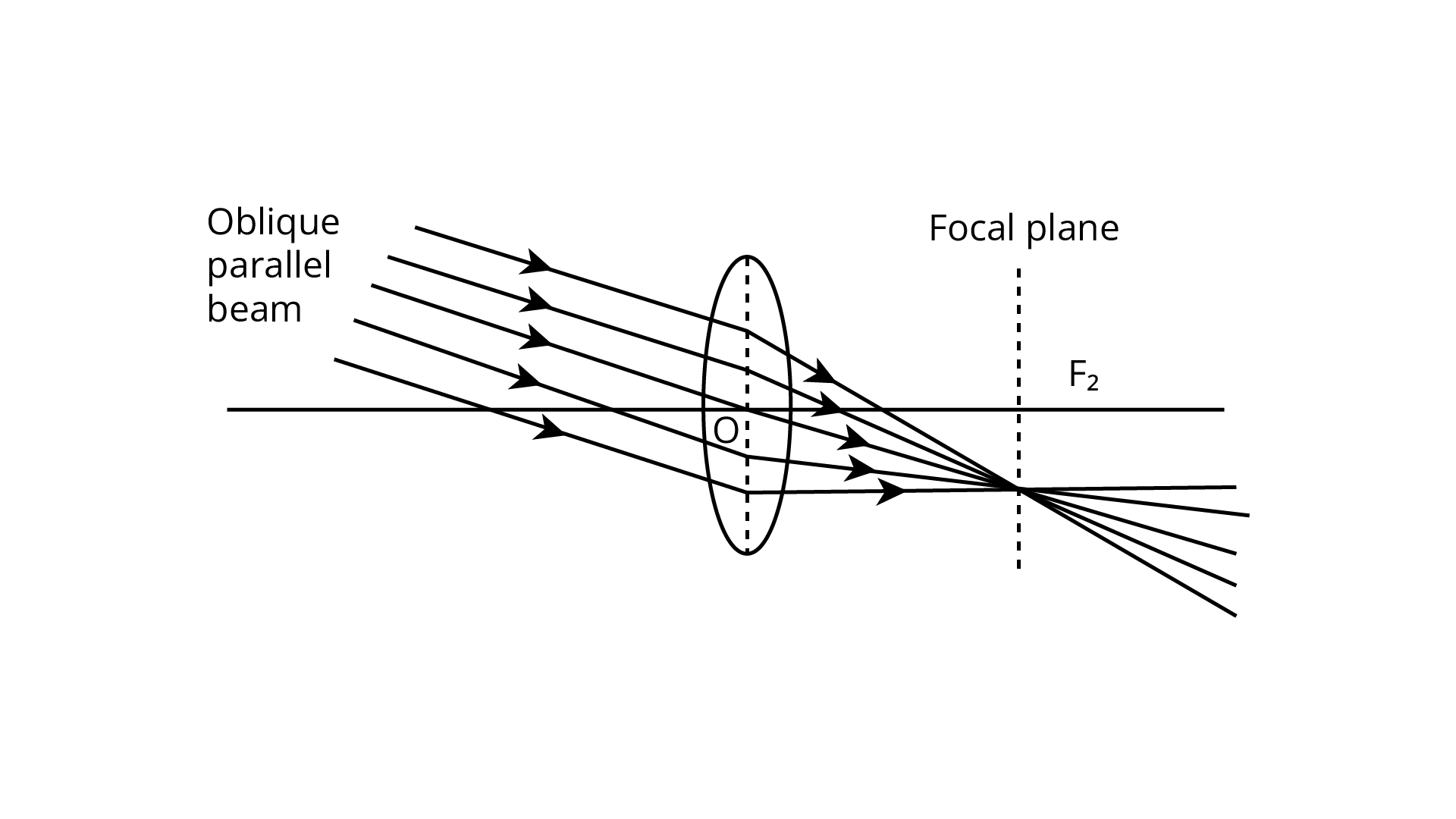
The refraction of an oblique parallel beam by a concave lens is as follows:
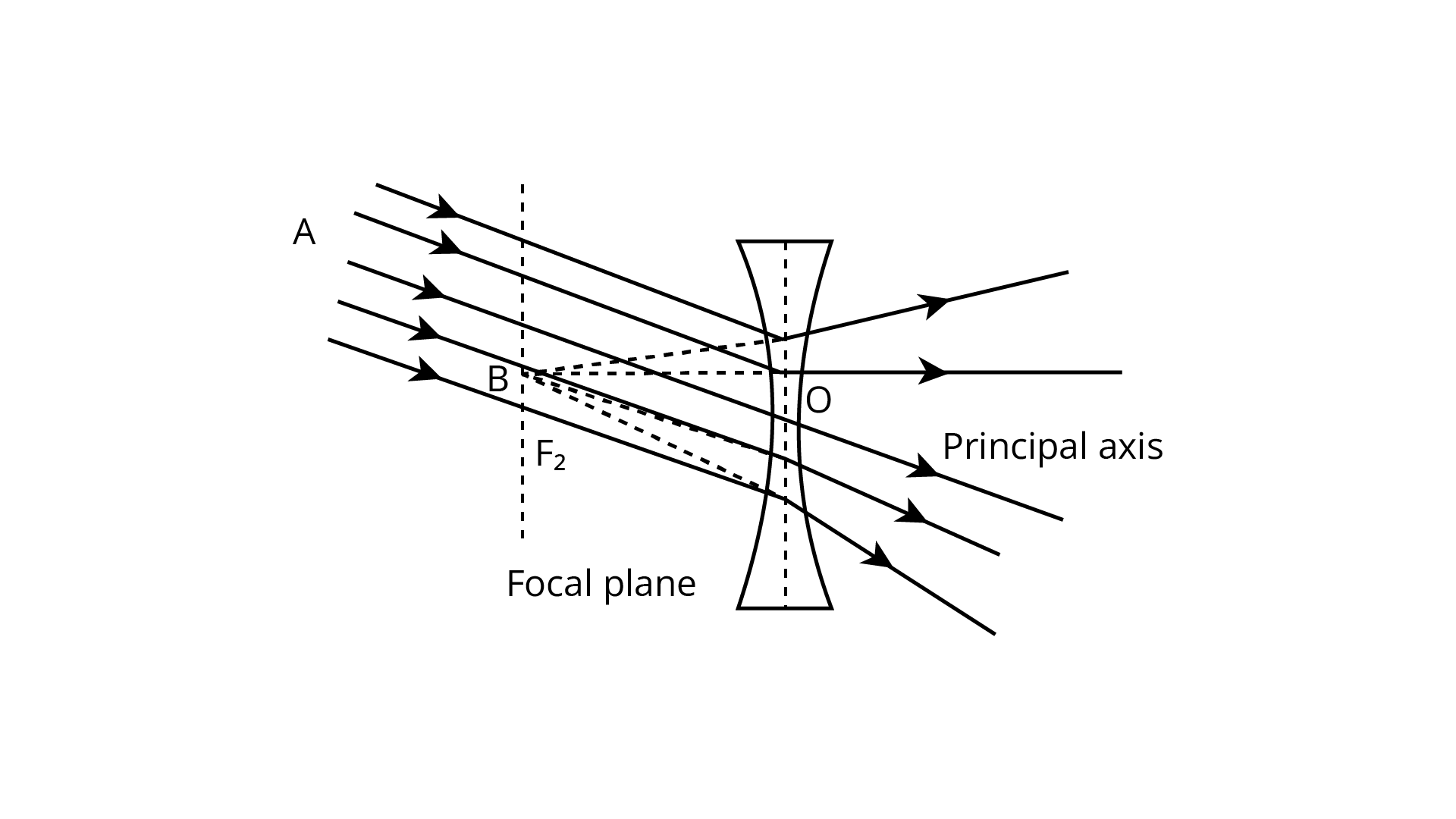
24. The diagram below shows a lens as a combination of a glass block and two prisms.
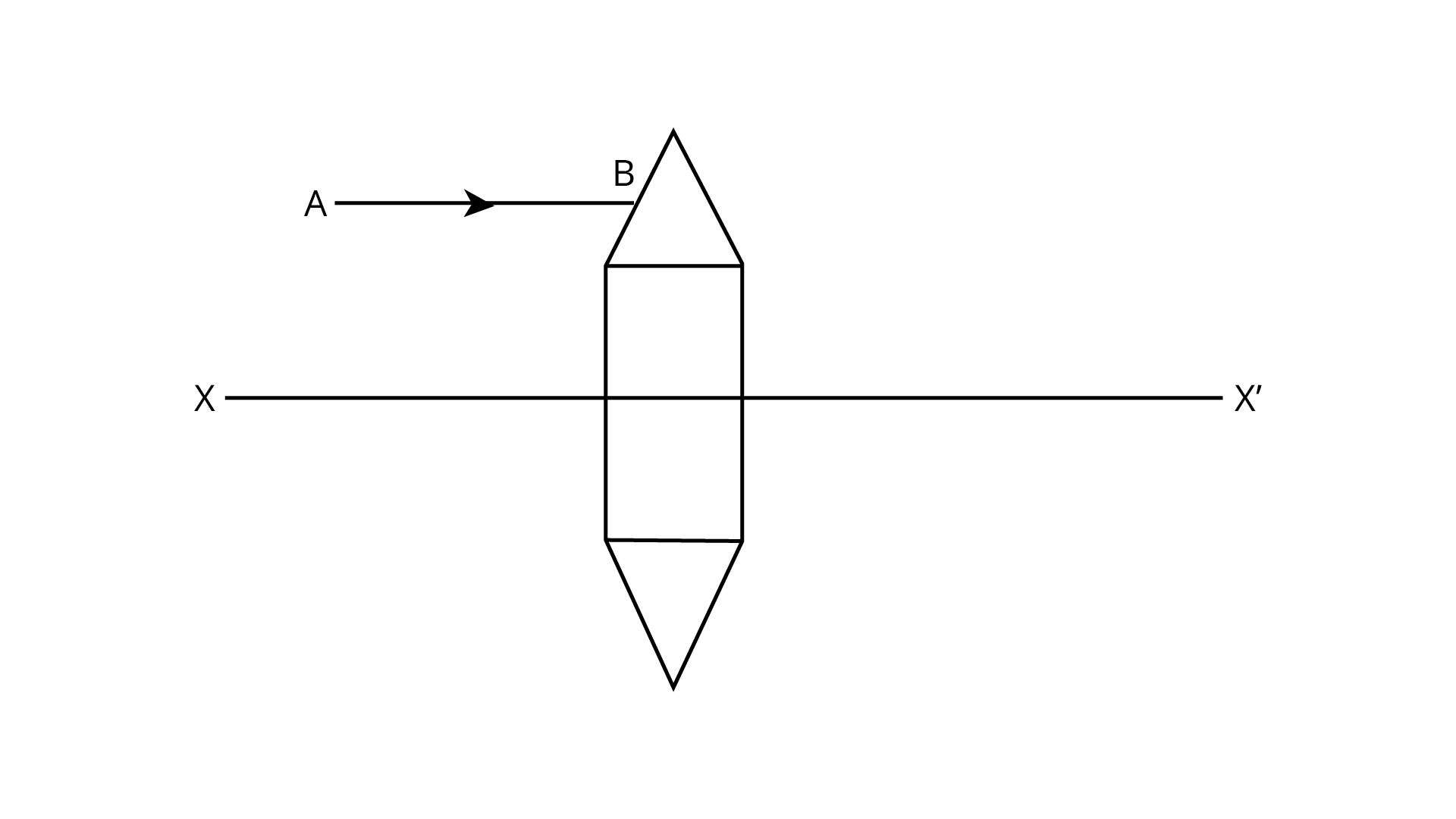
(i) Name the lens formed by the combination.
Ans: The lens formed by the combination is the convex lens.
(ii) What is the line XX' called?
Ans: The line XX' is the principal axis.
(iii) Complete the ray diagram and show the path of the incident ray AB after passing through the lens.
Ans: The complete ray diagram is shown below:
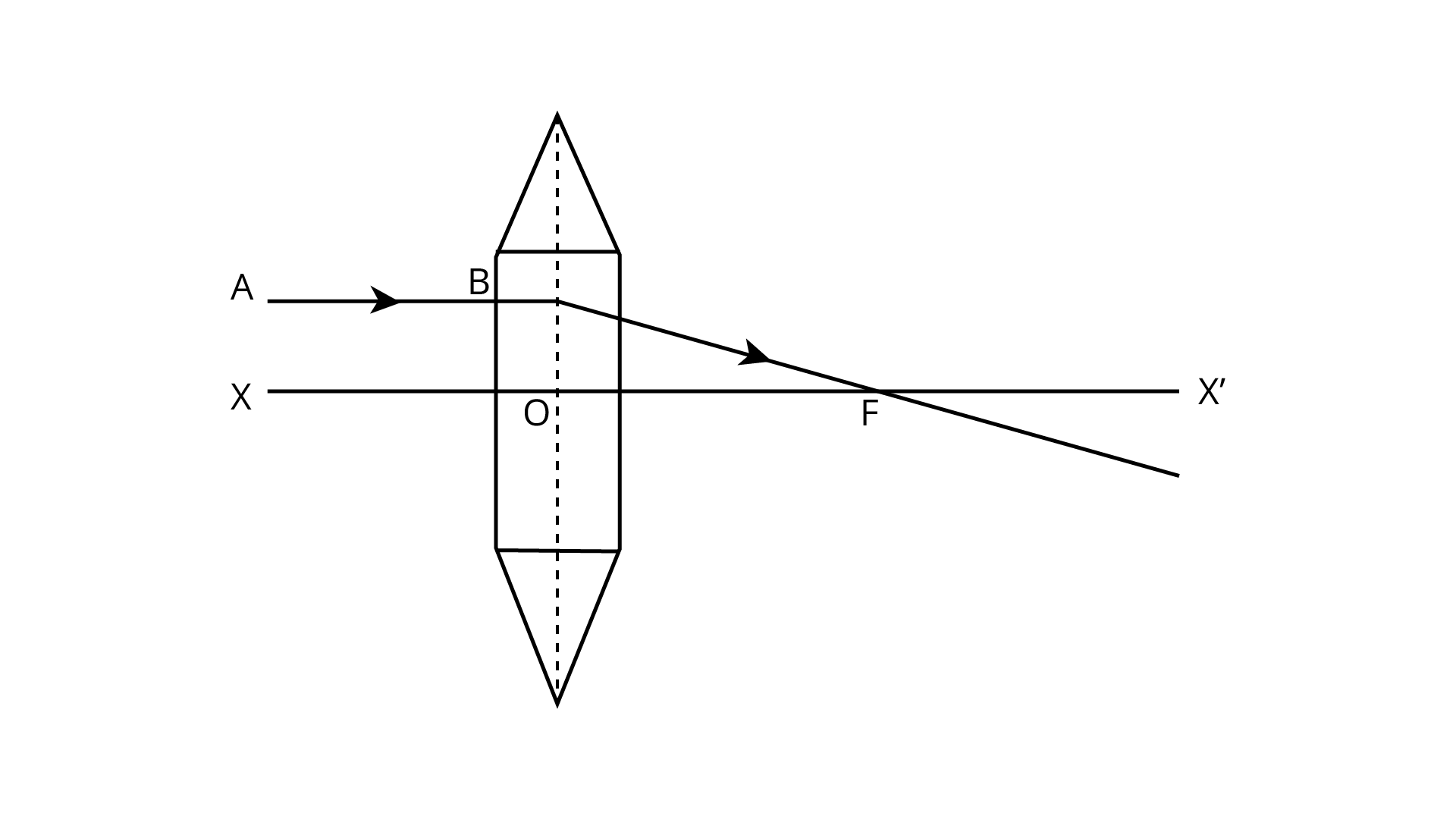
(iv) The final emergent ray will either meet XX' at a point or appear to come from a point on XX'. Label the point as F. What is this point called?
Ans: This point F is called the focal point or focus.
25. The diagram below shows a lens as a combination of a glass slab and two prisms.
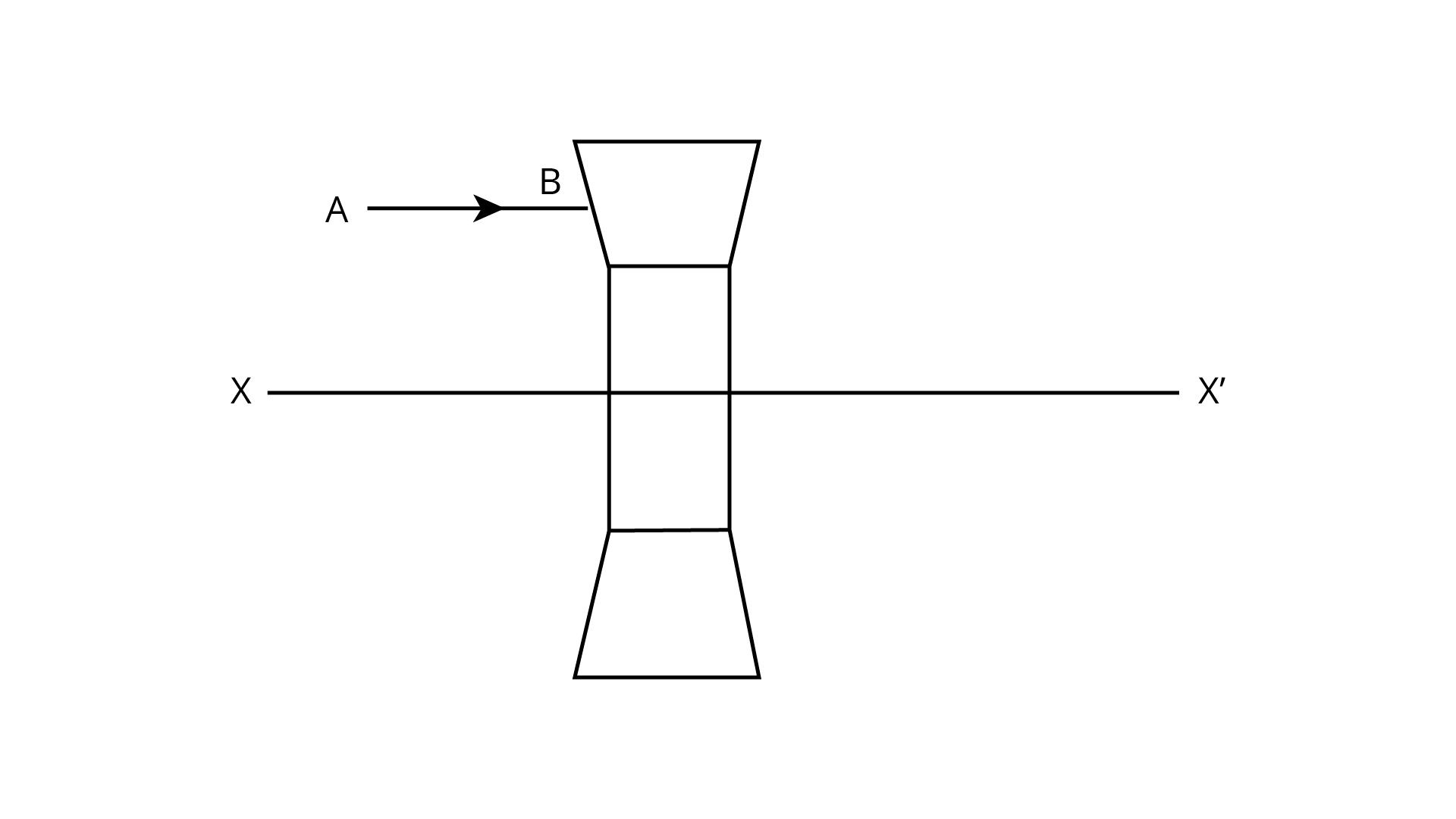
(i) Name the lens formed by the combination.
Ans: The lens formed by the combination is the concave lens.
(ii) What is the line XX' called?
Ans: The line XX' is called the principal axis.
(iii) Complete the path of the incident ray AB after passing through the lens.
Ans: Complete diagram is shown below:
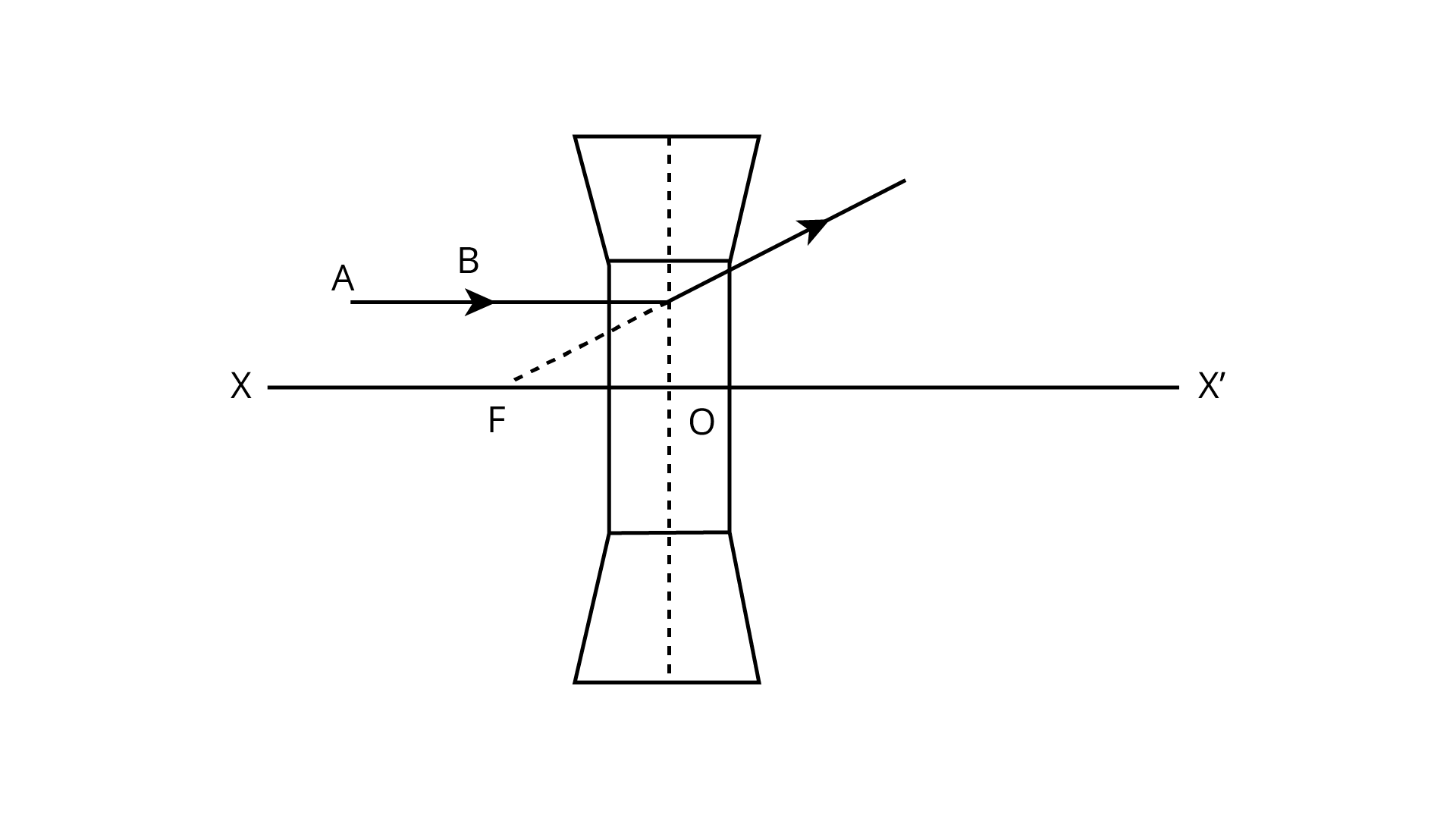
(iv) The final emergent ray either meets XX' at a point or appears to come from a point on XX'. Label it as F. What is this point called?
Ans: Point F is the focal point of focus.
26. In Fig. (a) and (b), F1 and F2 are the positions of the two foci of the thin lenses. Draw the path taken by the light ray AB after it emerges from each lens.
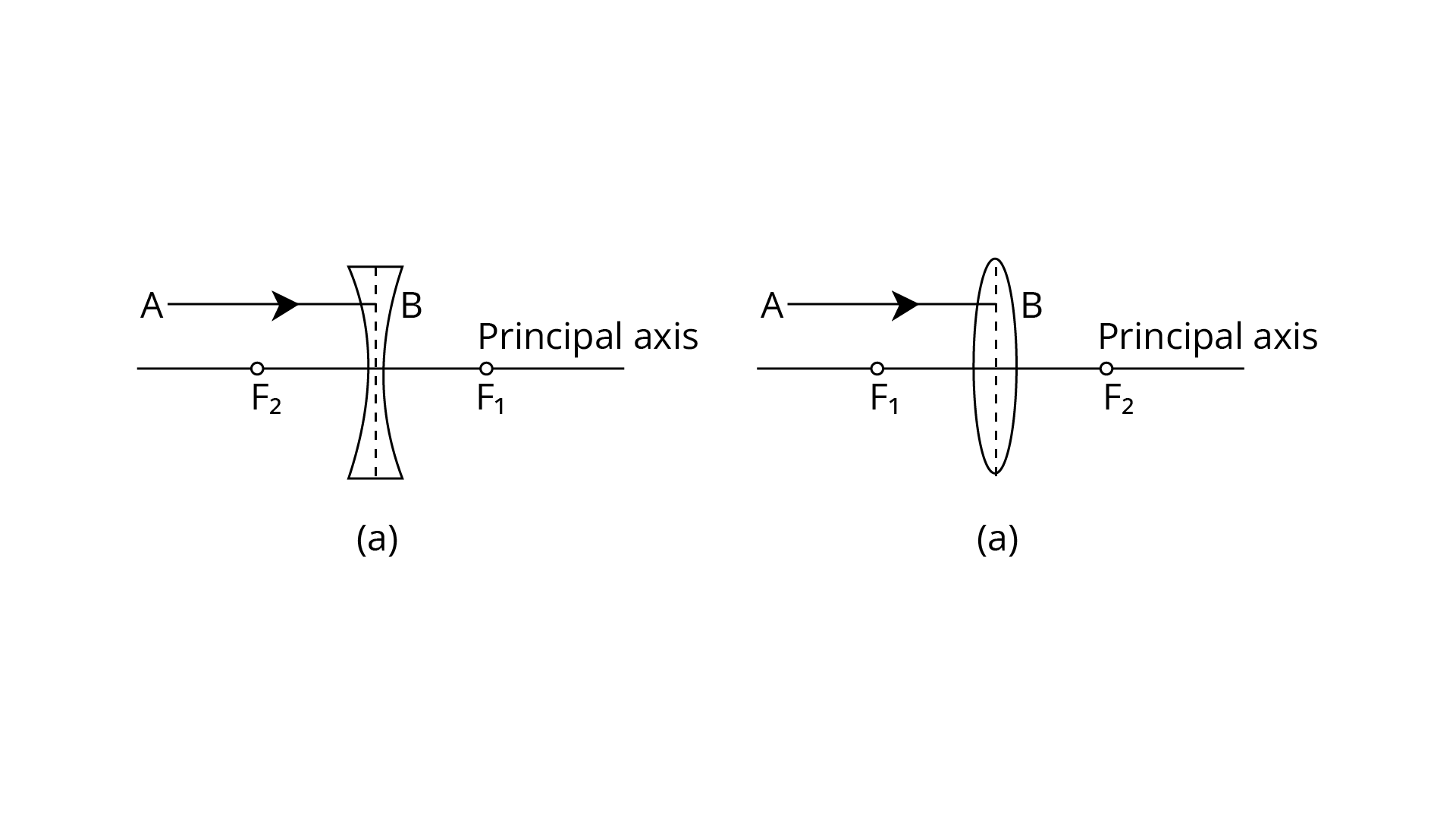
Ans: (a)
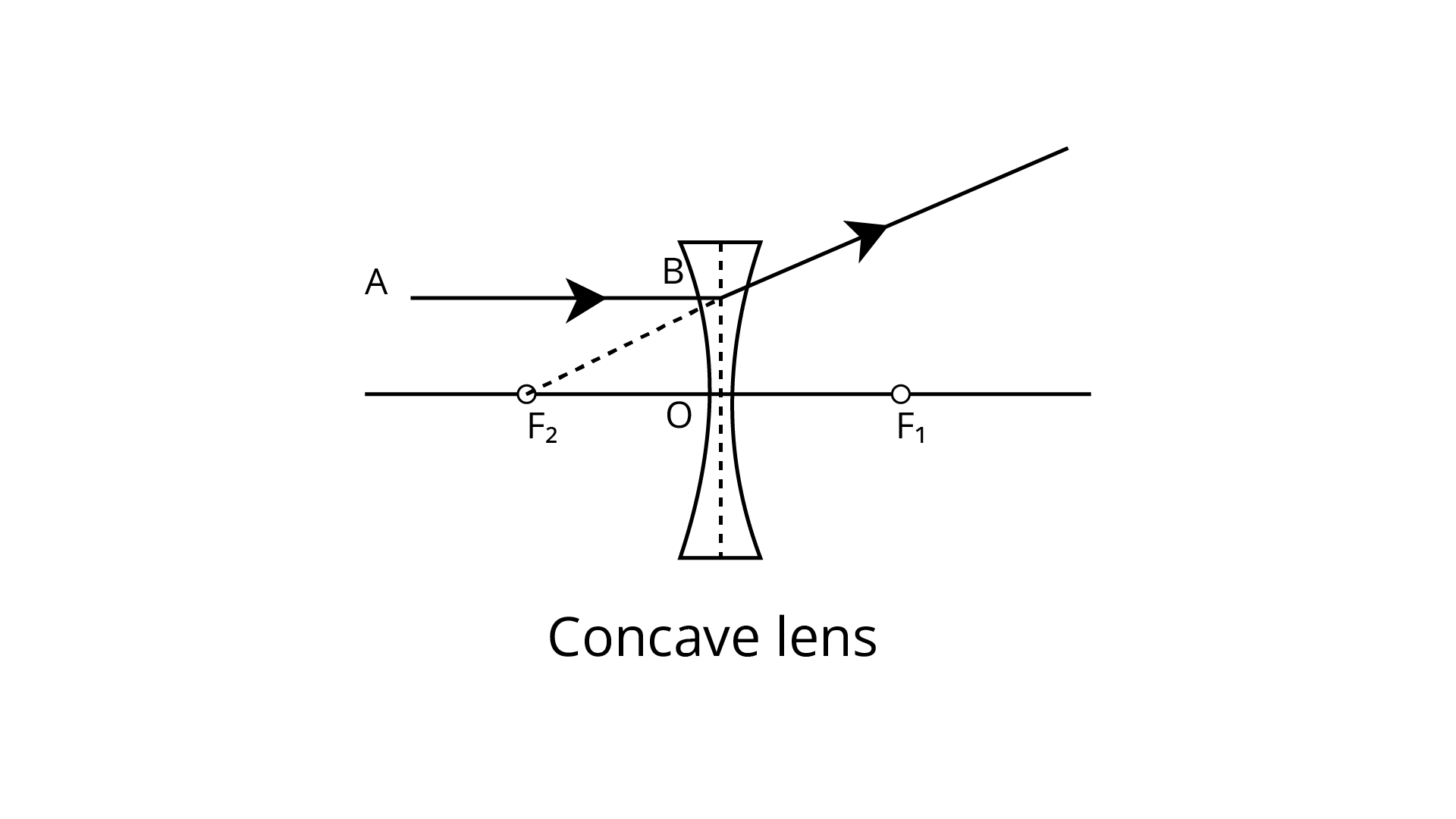
(b)
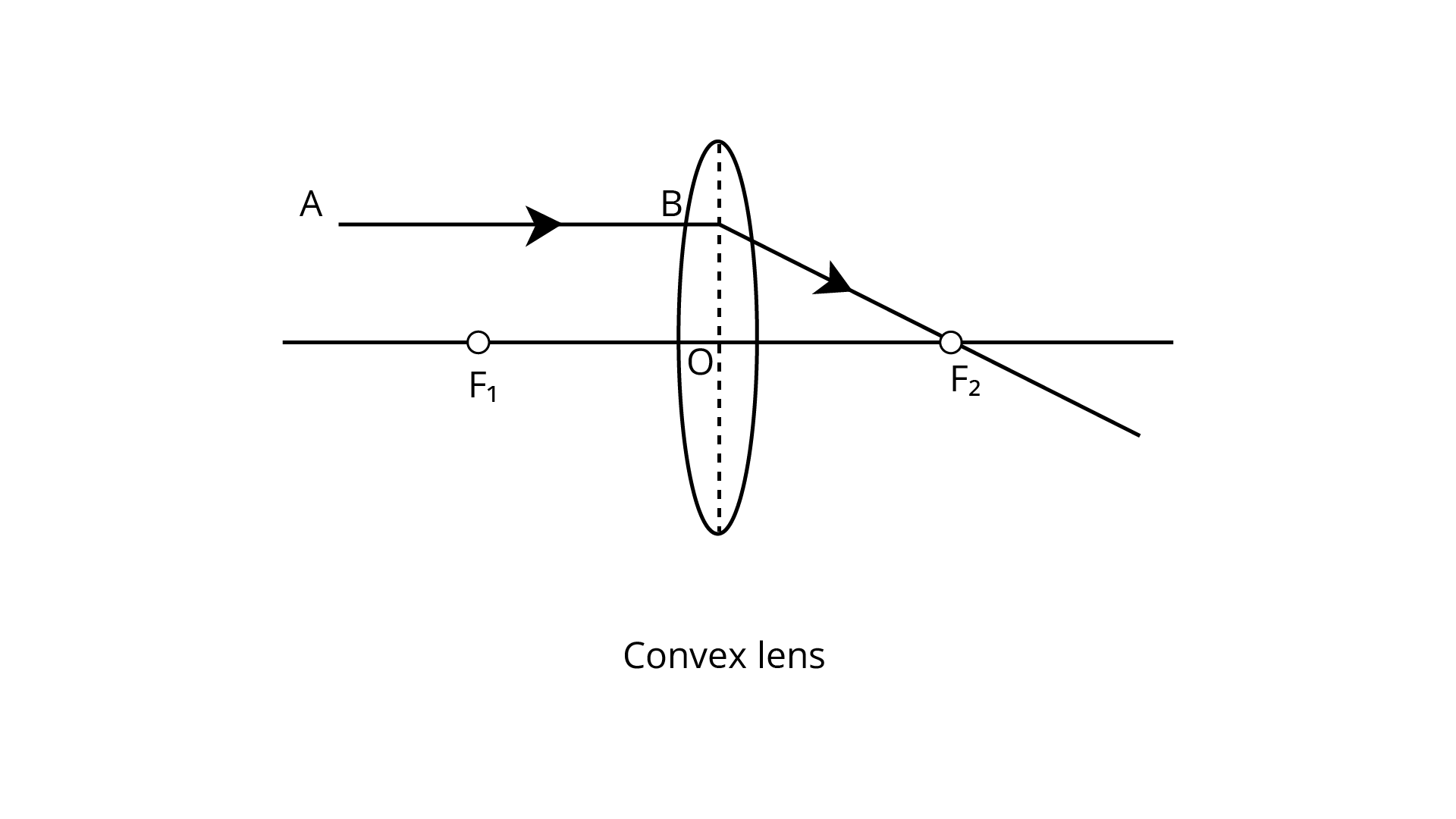
27. In Fig. (a) and (b), F1 and F2 are the two foci of the thin lenses and AB is the incident ray. Complete the diagram to show the path of the ray AB after refraction through the lens.
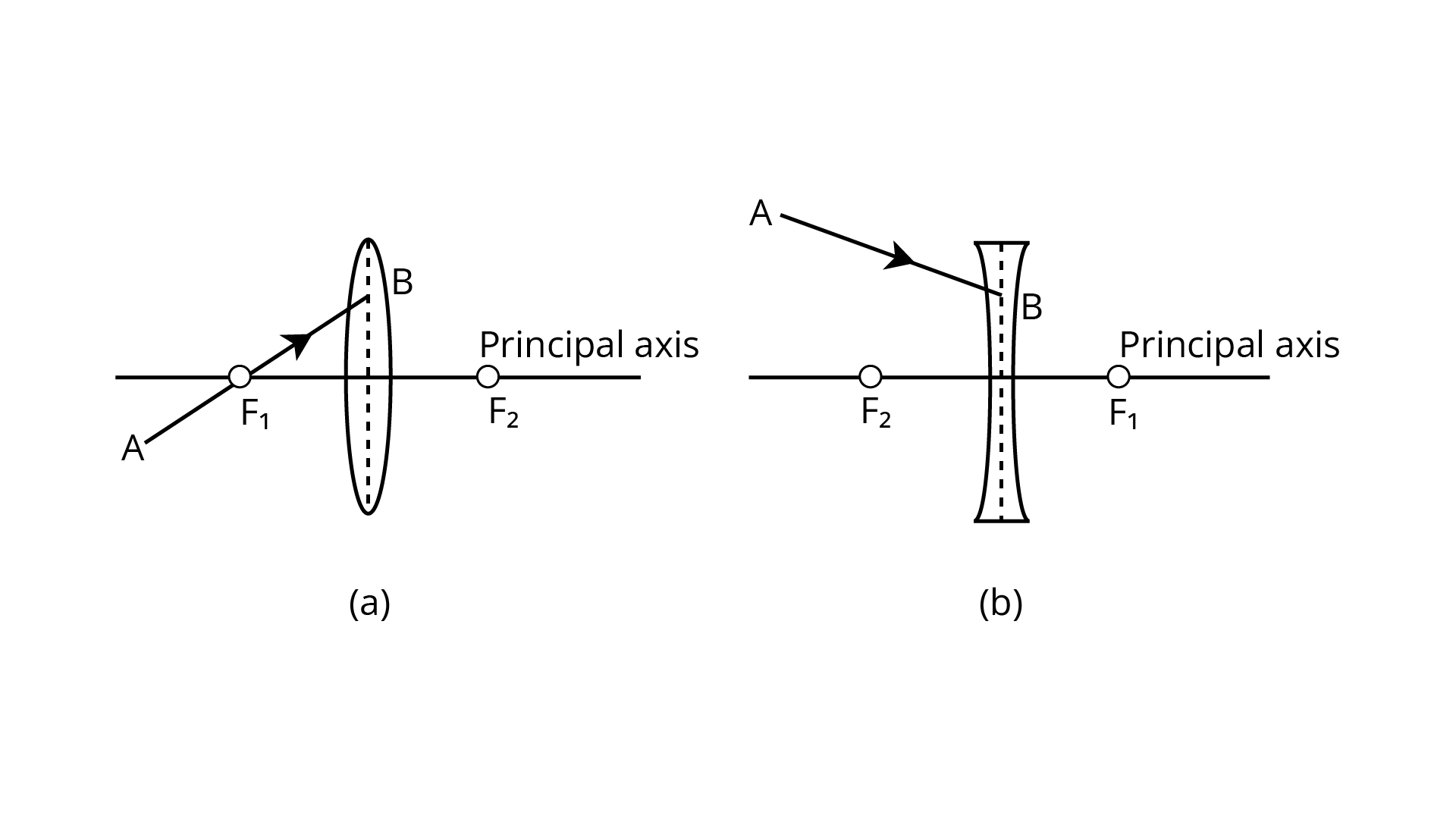
Ans: (a)
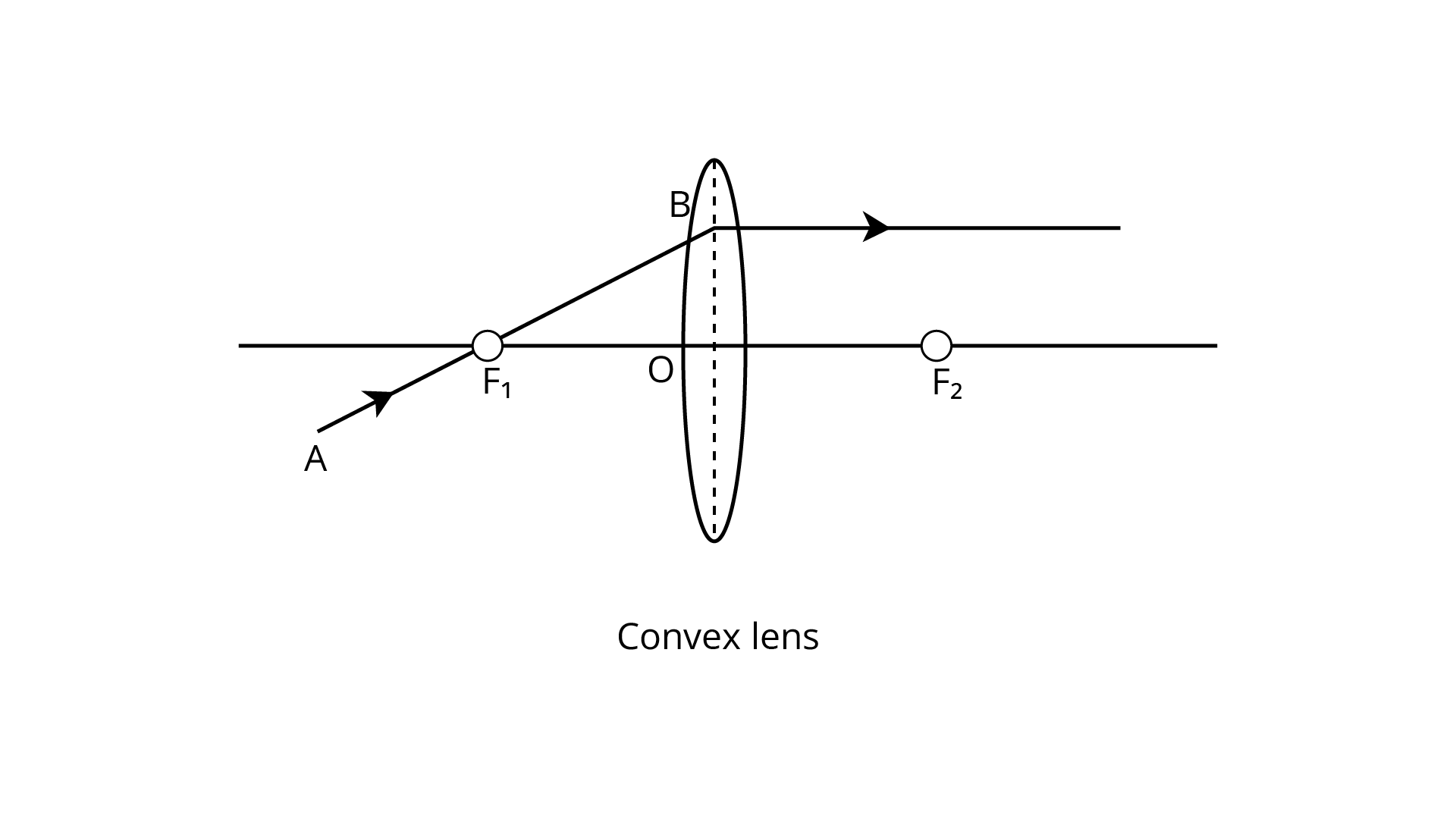
(b)
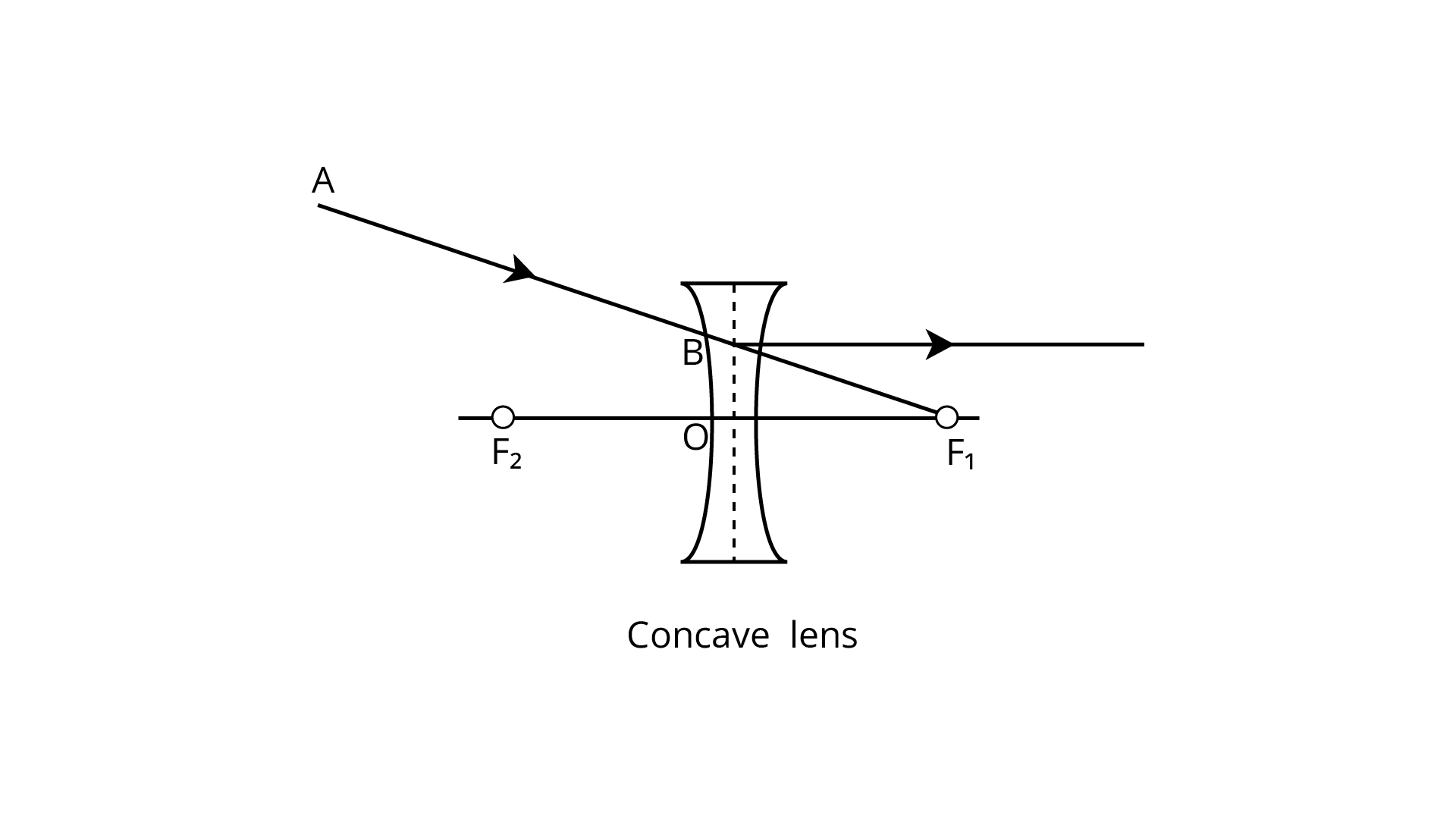
28. Complete the following sentences :
(a) If half part of a convex lens is covered, the focal length __________ changes, but the intensity of image _________.
Ans: If half part of a convex lens is covered, the focal length does not change, but the intensity of the image decreases.
(b) A convex lens is placed in water. Its focal length will ________.
Ans: A convex lens is placed in water. Its focal length will increase.
(c) The focal length of a thin convex lens is _________ than that of a thick convex lens.
Ans: The focal length of a thin convex lens is more than that of a thick convex lens.
29. Define the term principal axis of a lens.
Ans: The principal axis is the line joining the centers of the curvature of the two surfaces of the lens.
30. A ray of light incident on a lens parallels to its principal axis after refraction passes through or appears to come from
(a) Its first focus
(b) Its optical entre
(c) Its second focus
(d) The center of curvature of its second surface
Ans: A ray of light incident on a lens parallel to its principal axis after refraction passes through or appears to come from its second focus. Hence the correct answer is option c.
31. What are the three principal rays that are drawn to construct the ray diagram for the image formed by a lens? Draw diagrams to support your answer.
Ans: The three principles are as follows:
a) A ray of the light incident at the optical center O of the lens passes undeviated through the lens.
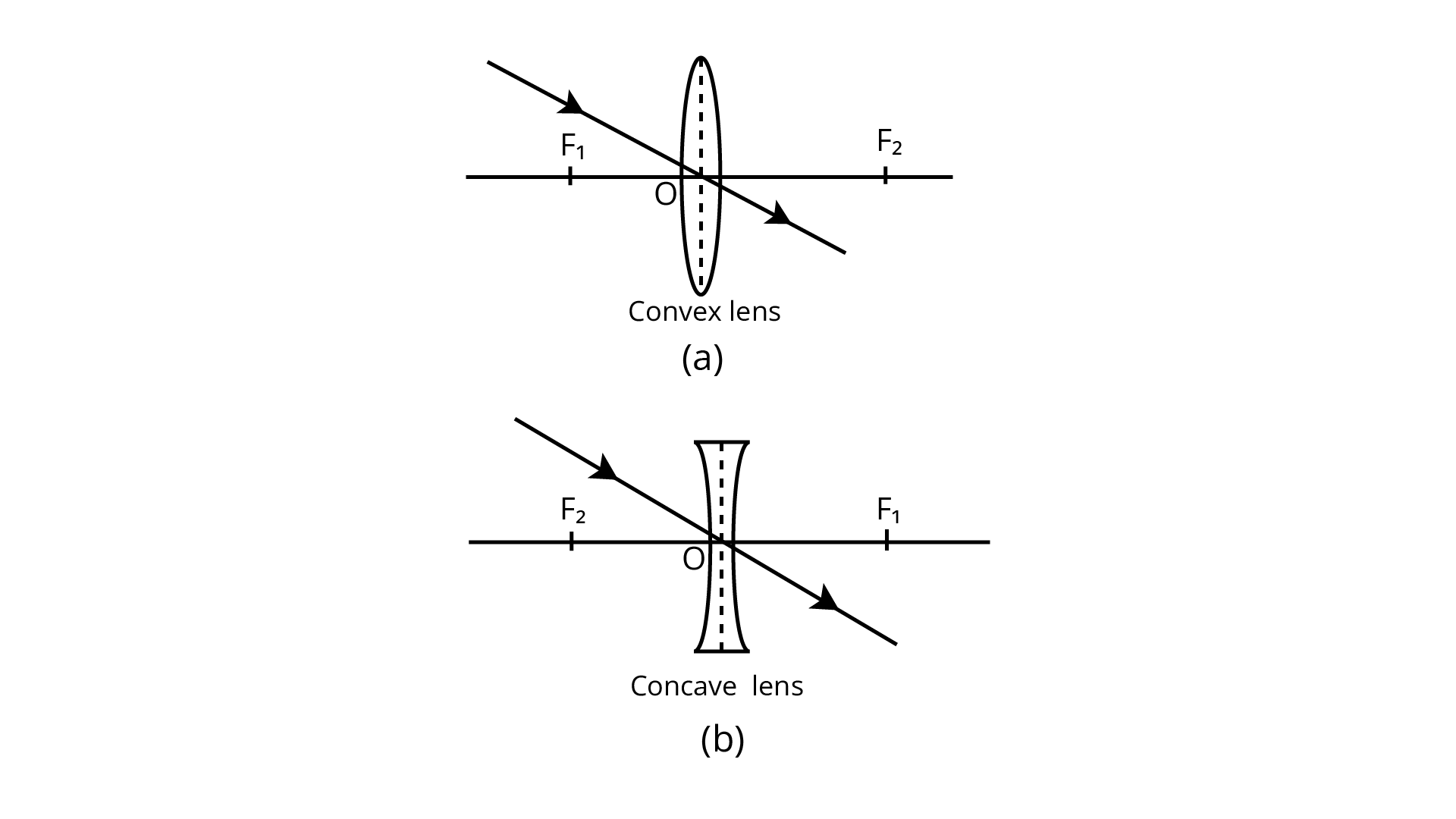
b) A ray of the light incident parallel to the principal axis of the lens, after the refraction passes through the second focus F2 (in a convex lens) or appears to come from the second focus F2 (in a concave lens)
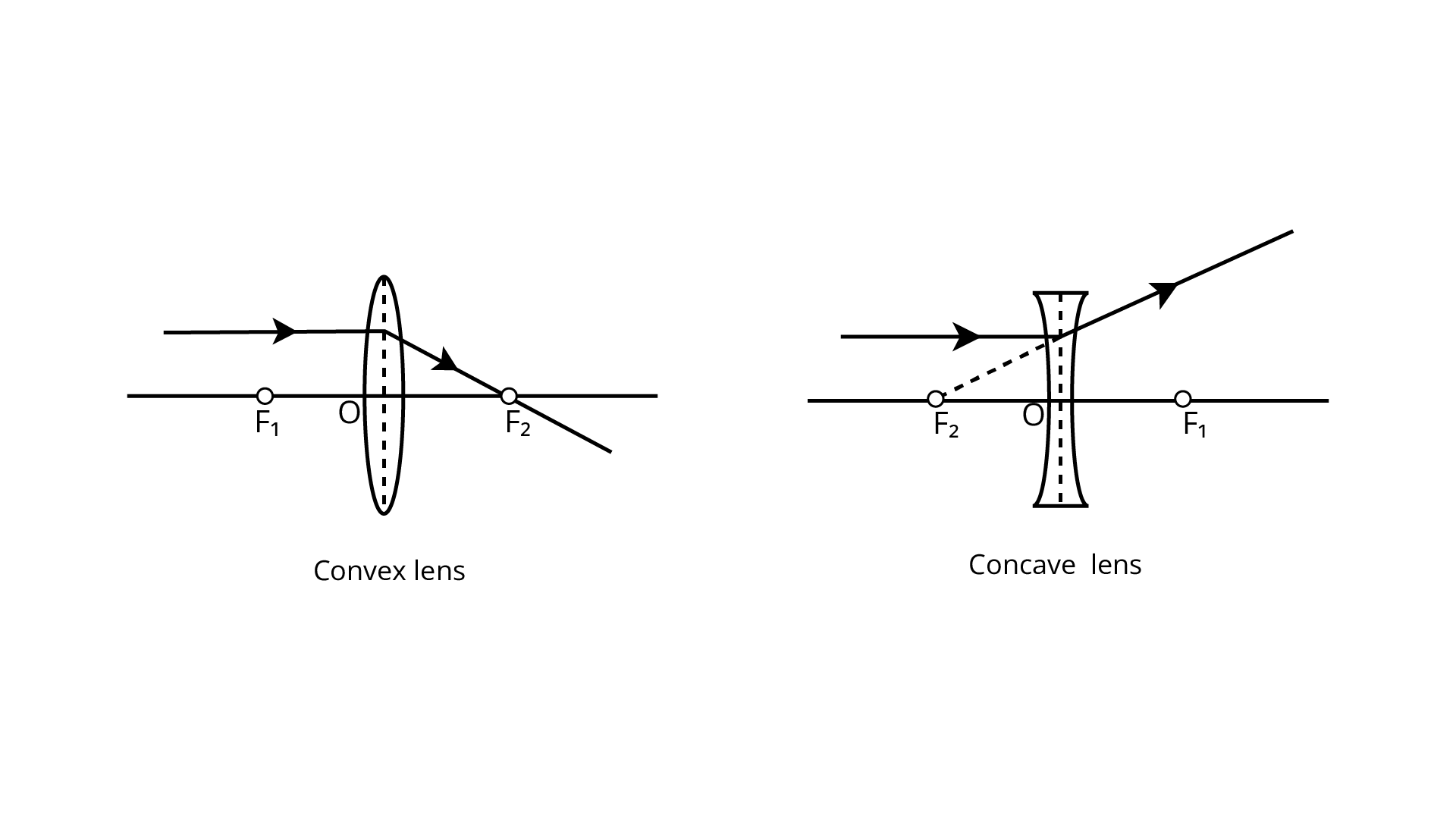
c) A ray of the light passing through the first focus F1 (in a convex lens) or directed towards the first focus F1 (in a concave lens), emerges parallel to the principal axis after the refraction.
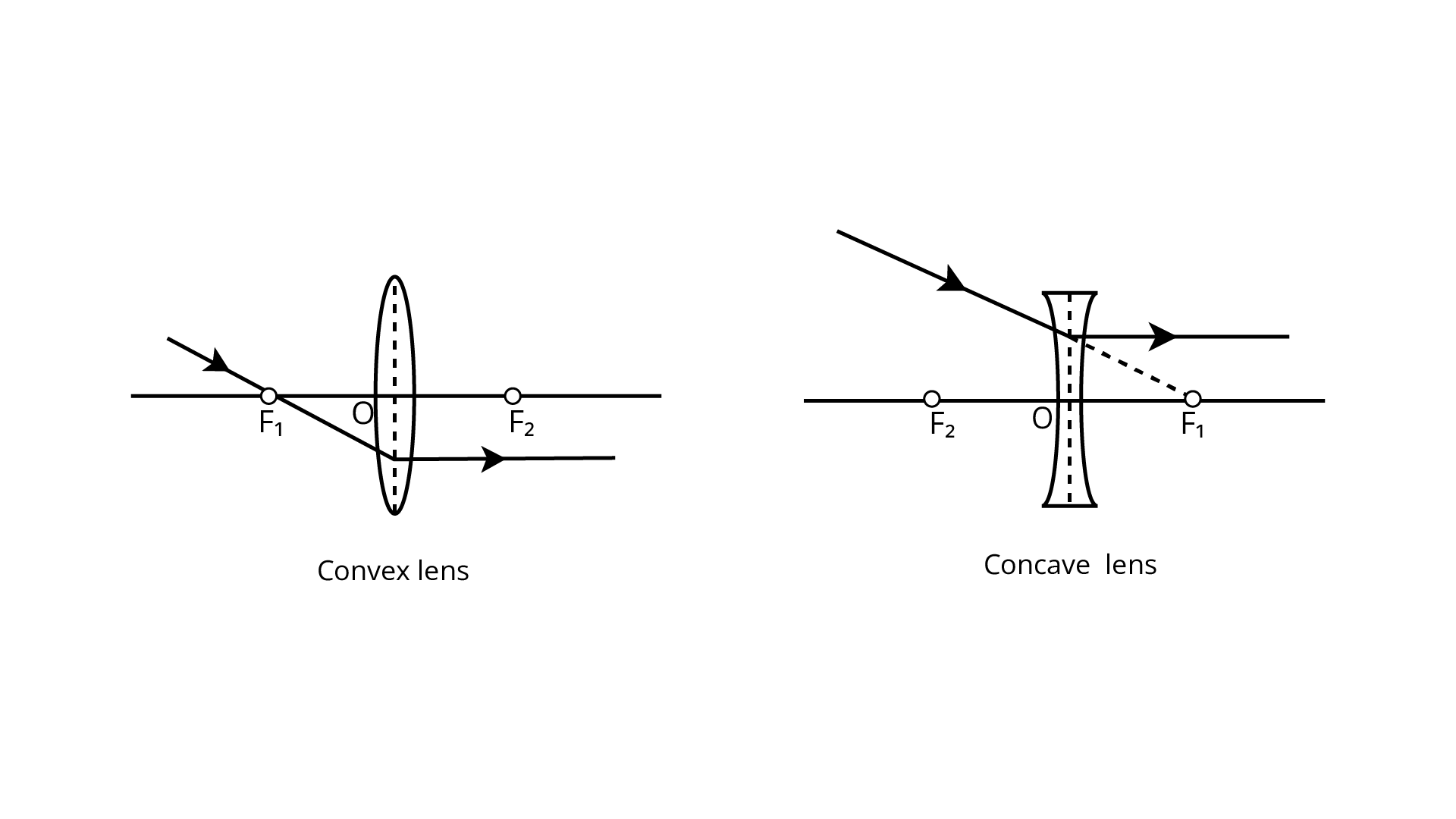
32. In the diagrams below, XX' represents the principal axis, O the optical center and F the focus of the lens. Complete the path of the rays A and B as they emerge out of the lens.
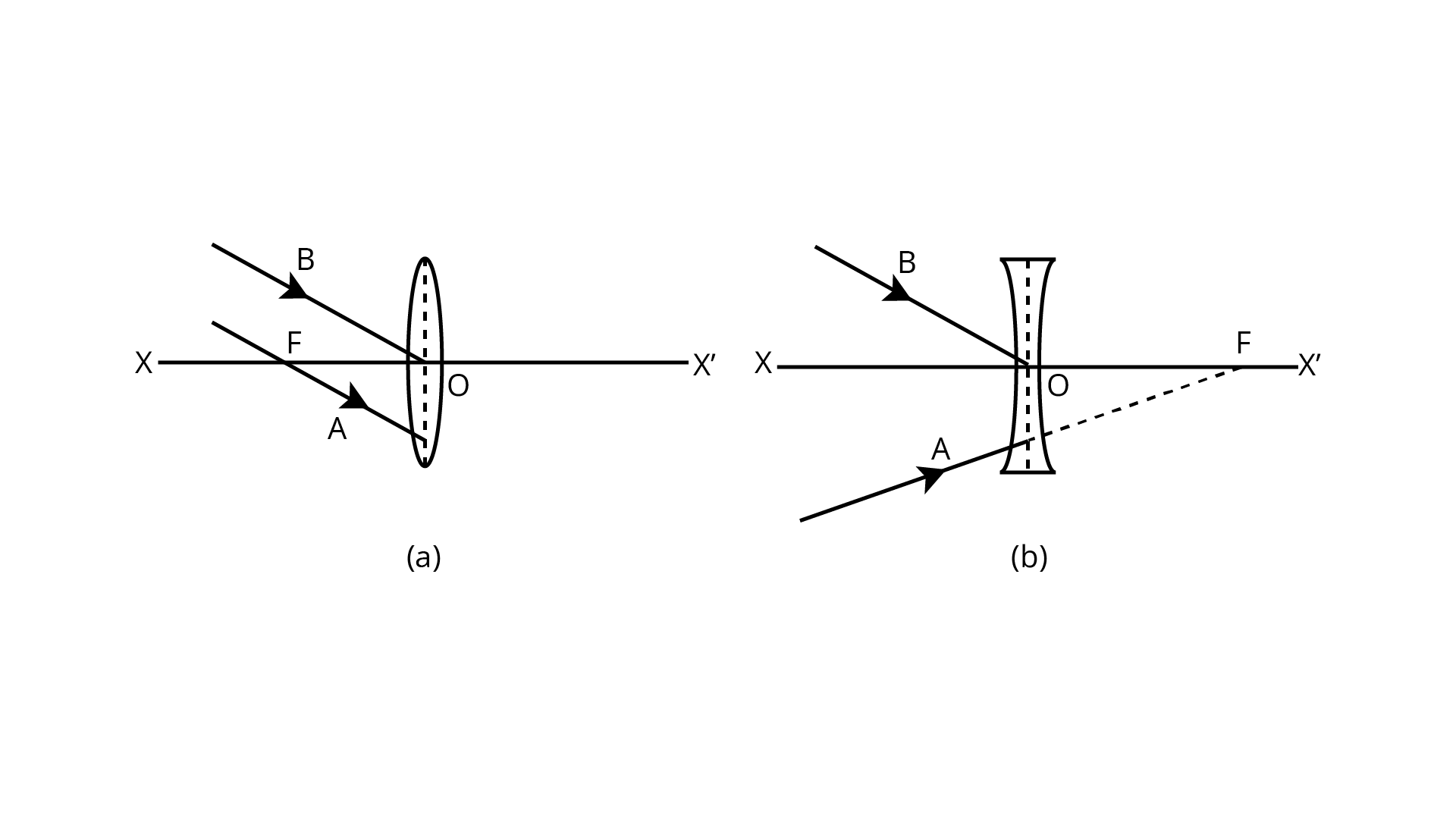
Ans:
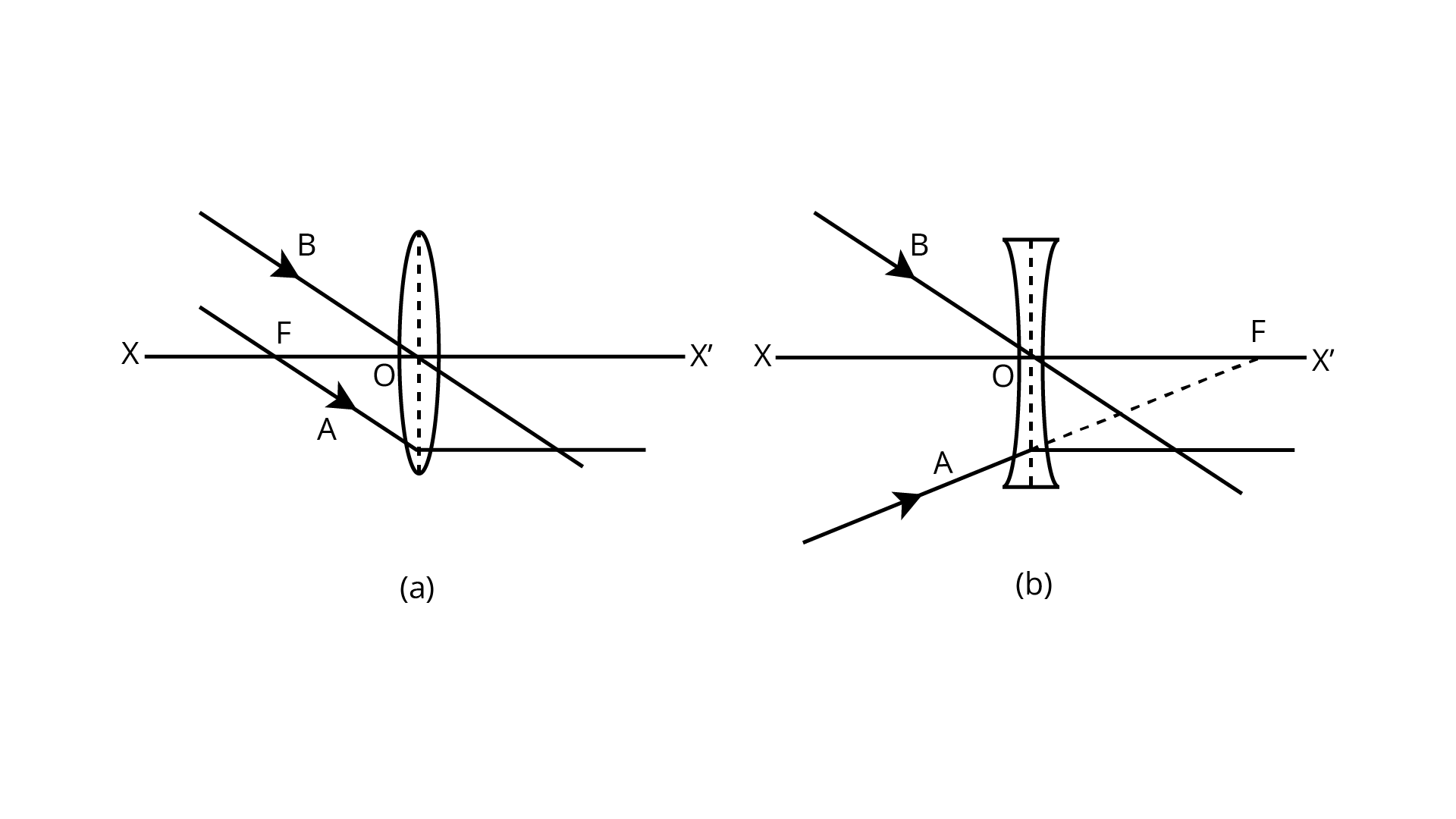
33. Where must a point source of light be placed in front of a convex lens so as to obtain a parallel beam of light?
Ans: A point source of light be placed at the first focal point which means that the focal point on the left of the optical center of the convex lens is in front of a convex lens so as to obtain a parallel beam of light.
34. Distinguish between a real and a virtual image.
Ans: The difference is as follows:
Sr. No | Virtual Image | Real Image |
1 | This image is formed when the rays refracted by the lens appear to meet if they are produced backward. | This image is formed due to the actual intersection of the rays refracted by the lens. |
2 | This image cannot be obtained on a screen. | This image can be obtained on a screen. |
3 | This image is erect with respect to the object. | This image is inverted with respect to the object. |
35. Study the diagram given below.
(a) Name the lens LL'.
Ans: LL' is a convex lens.
(b) What are the points P and O' called?
Ans: O and O' are the first and second focal points respectively.
(c) Complete the diagram to form the image of the object AB.
Ans: The complete diagram is shown below:
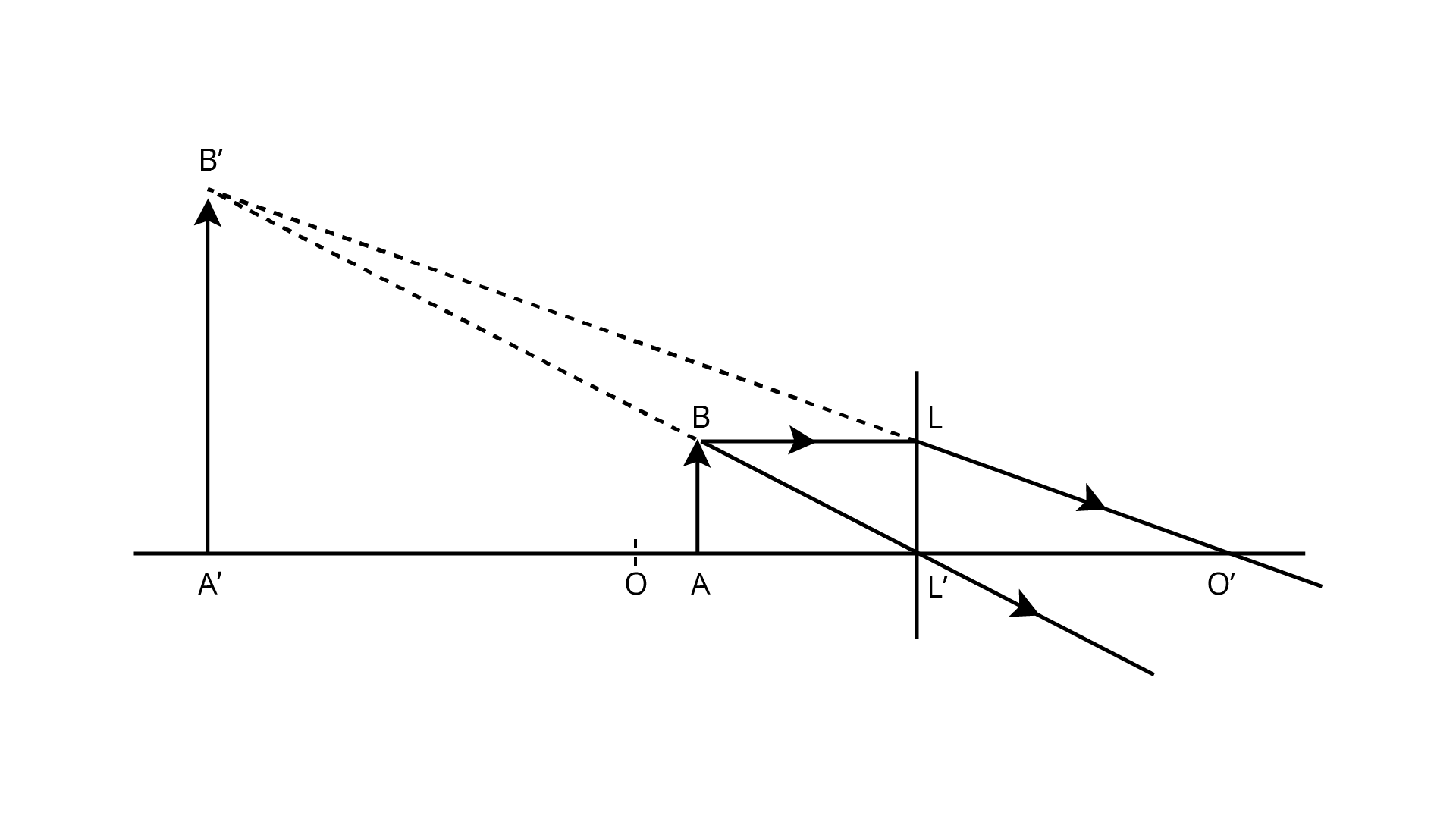
(d) State the three characteristics of the image.
Ans: The magnified, virtual and upright are the three characteristics of the image.
(e) Name a device in which this action of the lens is used.
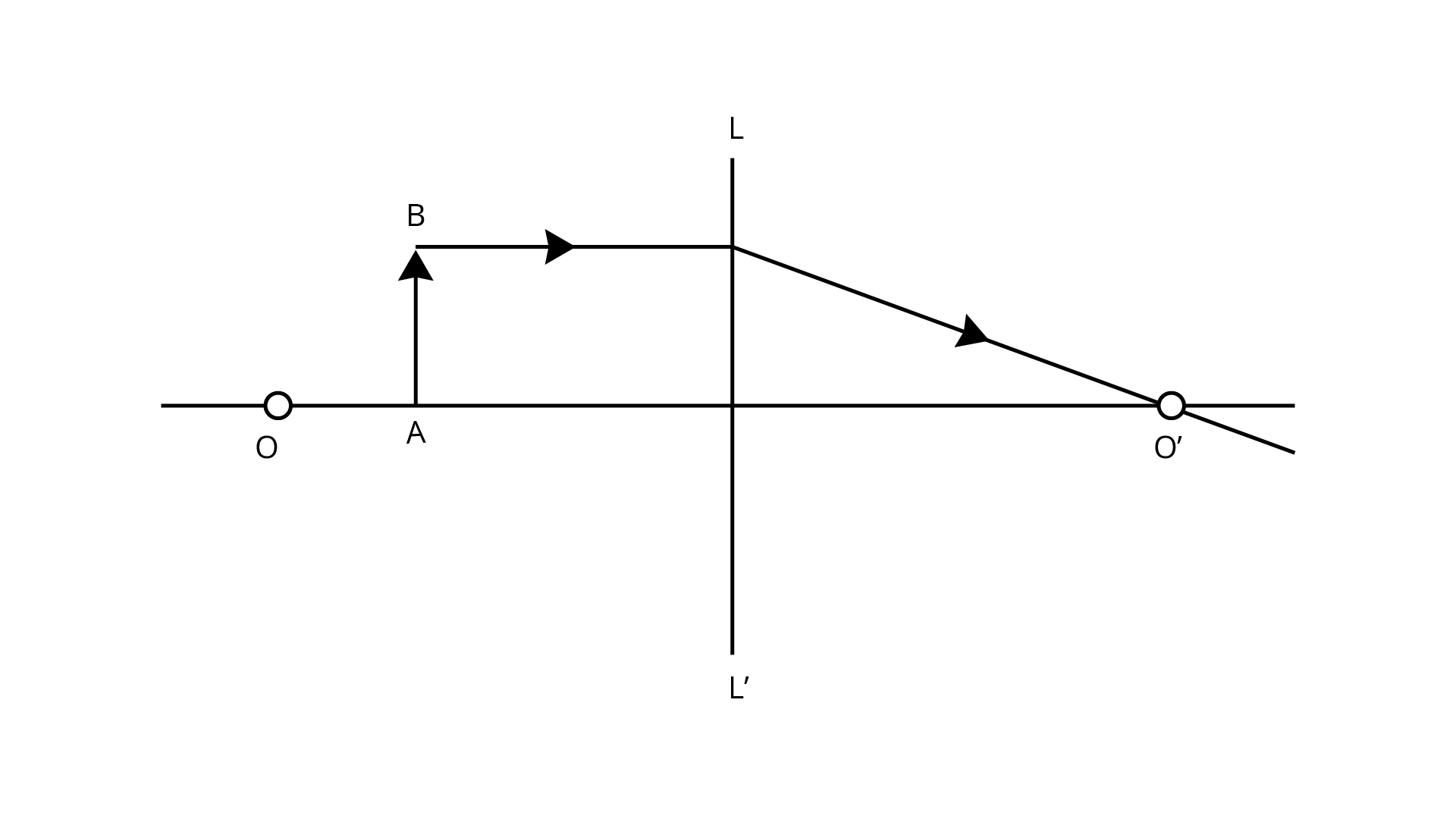
Ans: This action of the lens is used in a magnifying glass.
36. Study the diagram below.
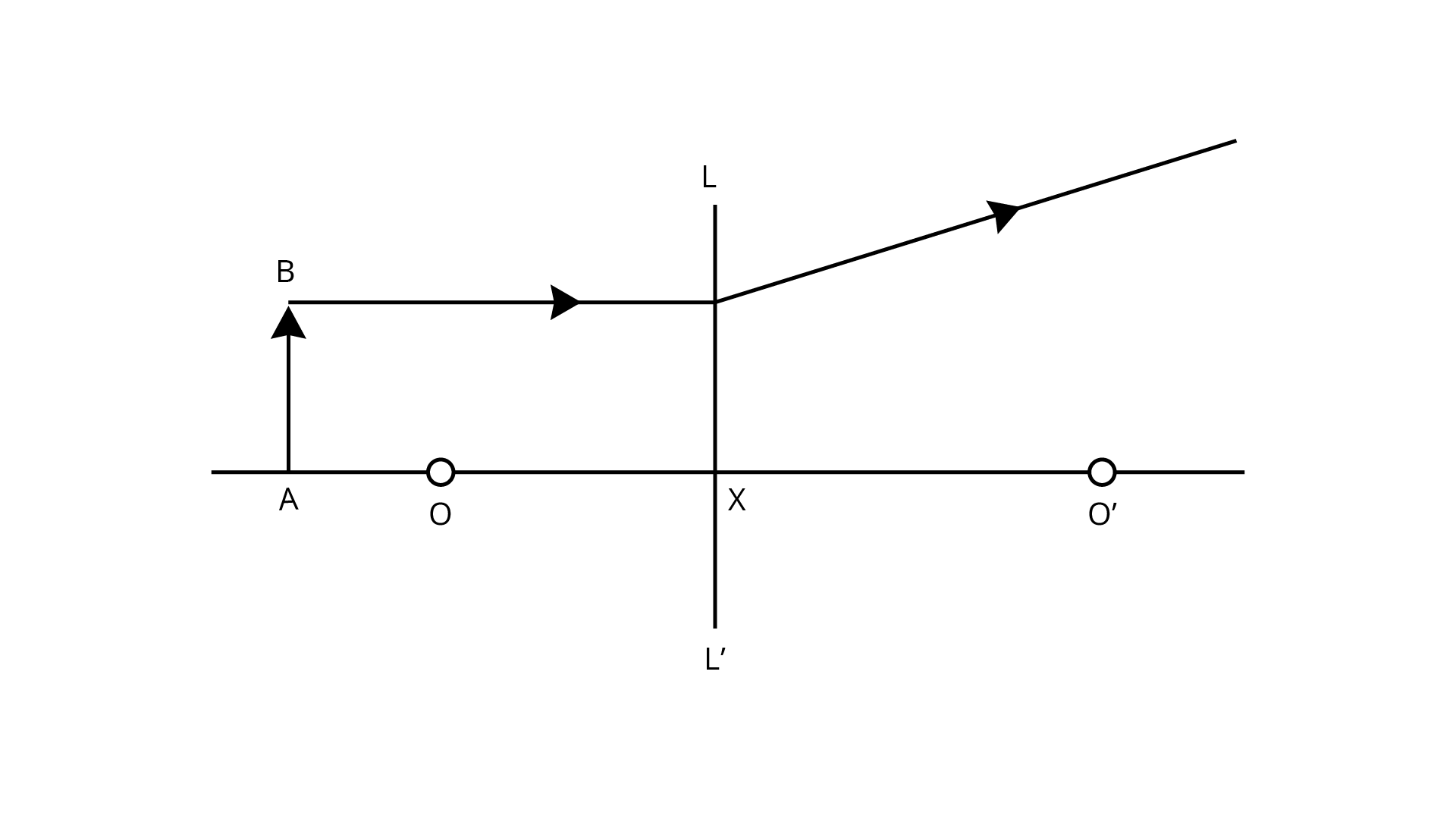
(i) Name the lens LL'.
Ans: LL' is a concave lens
(ii) What are the points P and O' called?
Ans: The points P and O' are the second and first focal points respectively.
(iii) Complete the diagram to form the image of the object AB.
Ans: The diagram is as follows:
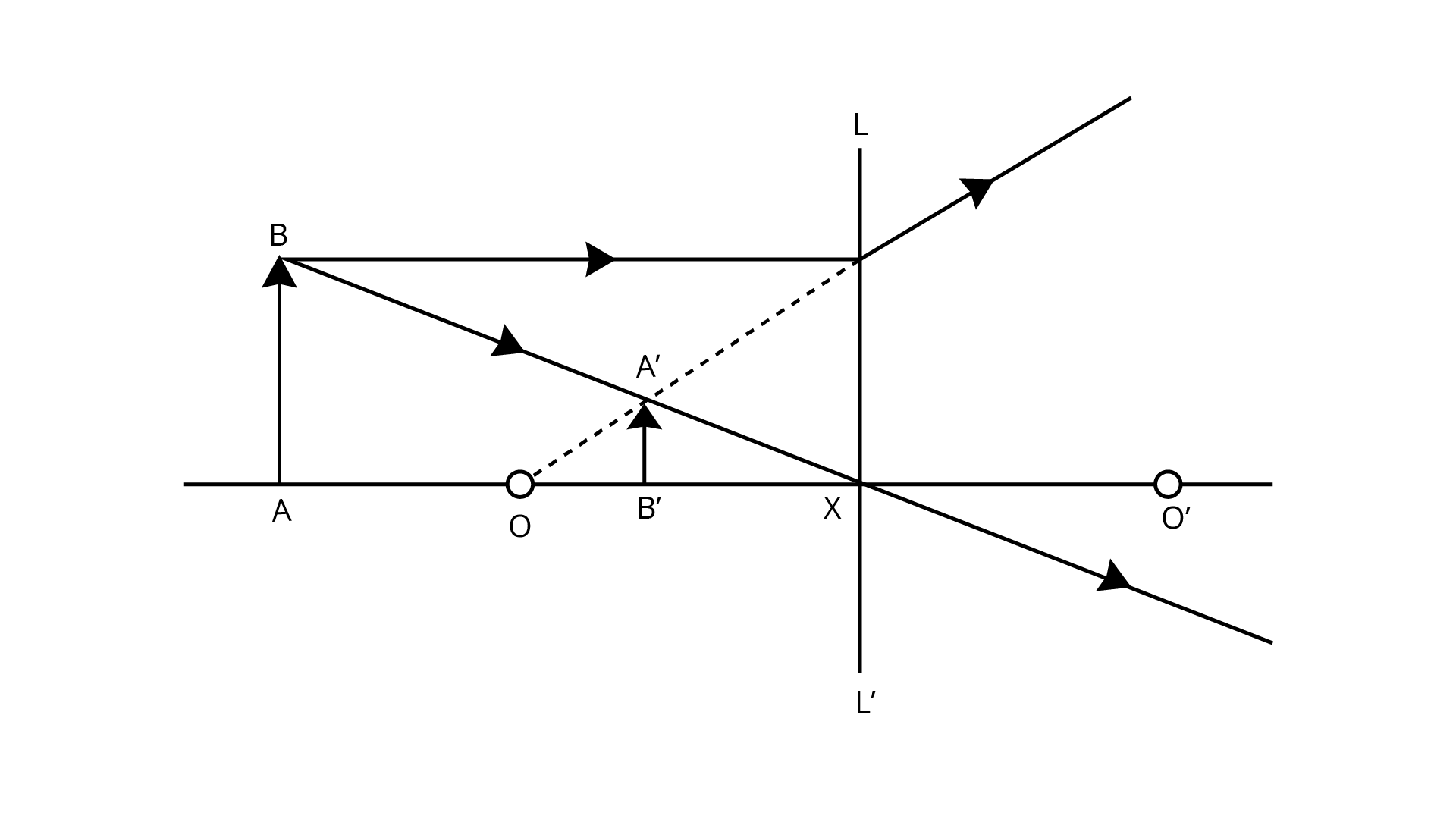
(iv) State three characteristics of the image.
Ans: The virtual, erect, and diminished are the three characteristics of the image.
37. The following diagram in Fig. shows an object AB and a converging lens L with foci F1 and F2.
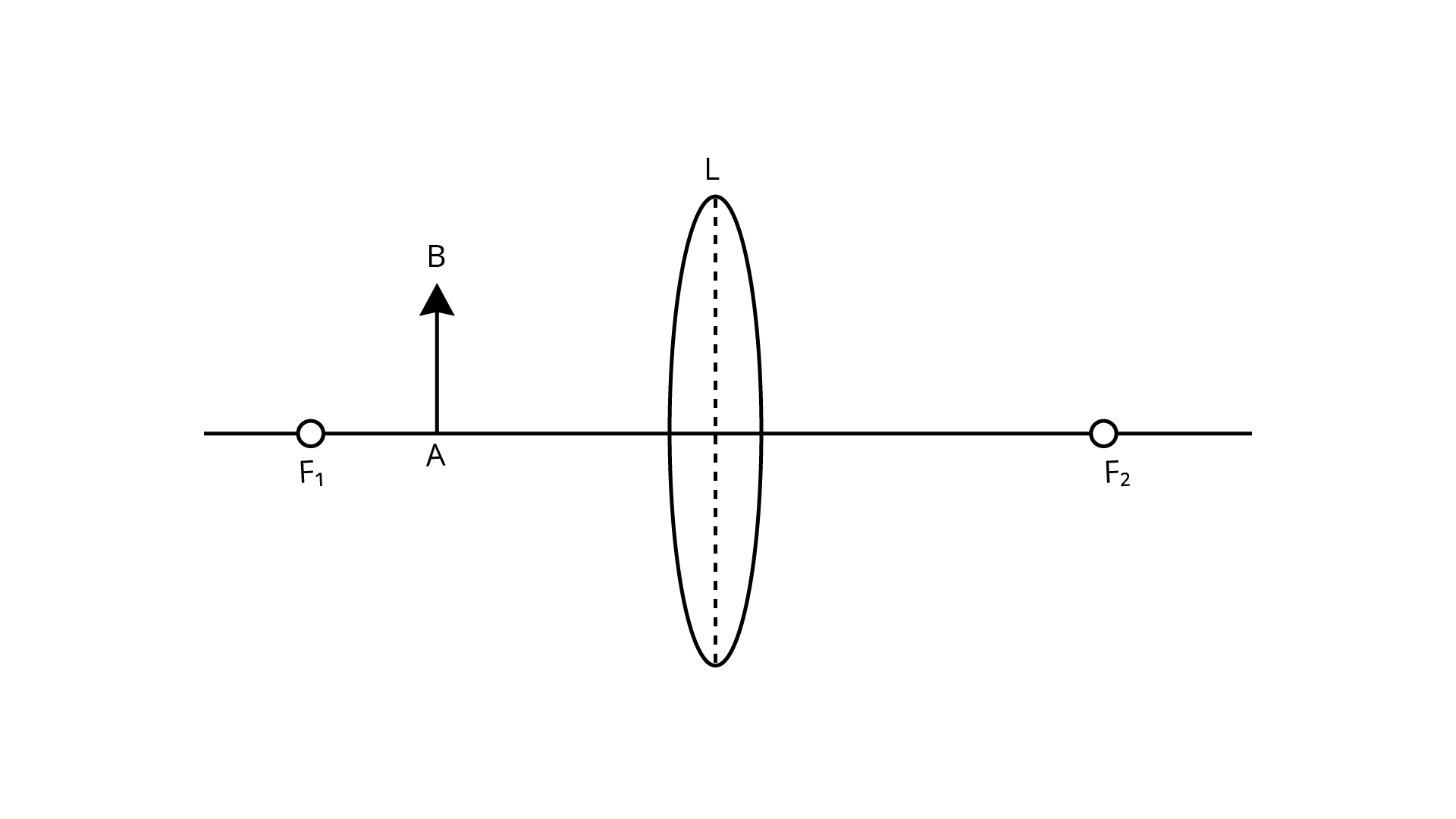
(a) Draw two rays from the object AB and complete the diagram to locate the position of the image CD. Also mark on the diagram the position of the eye from where the image can be viewed.
Ans: The complete diagram is as follows:
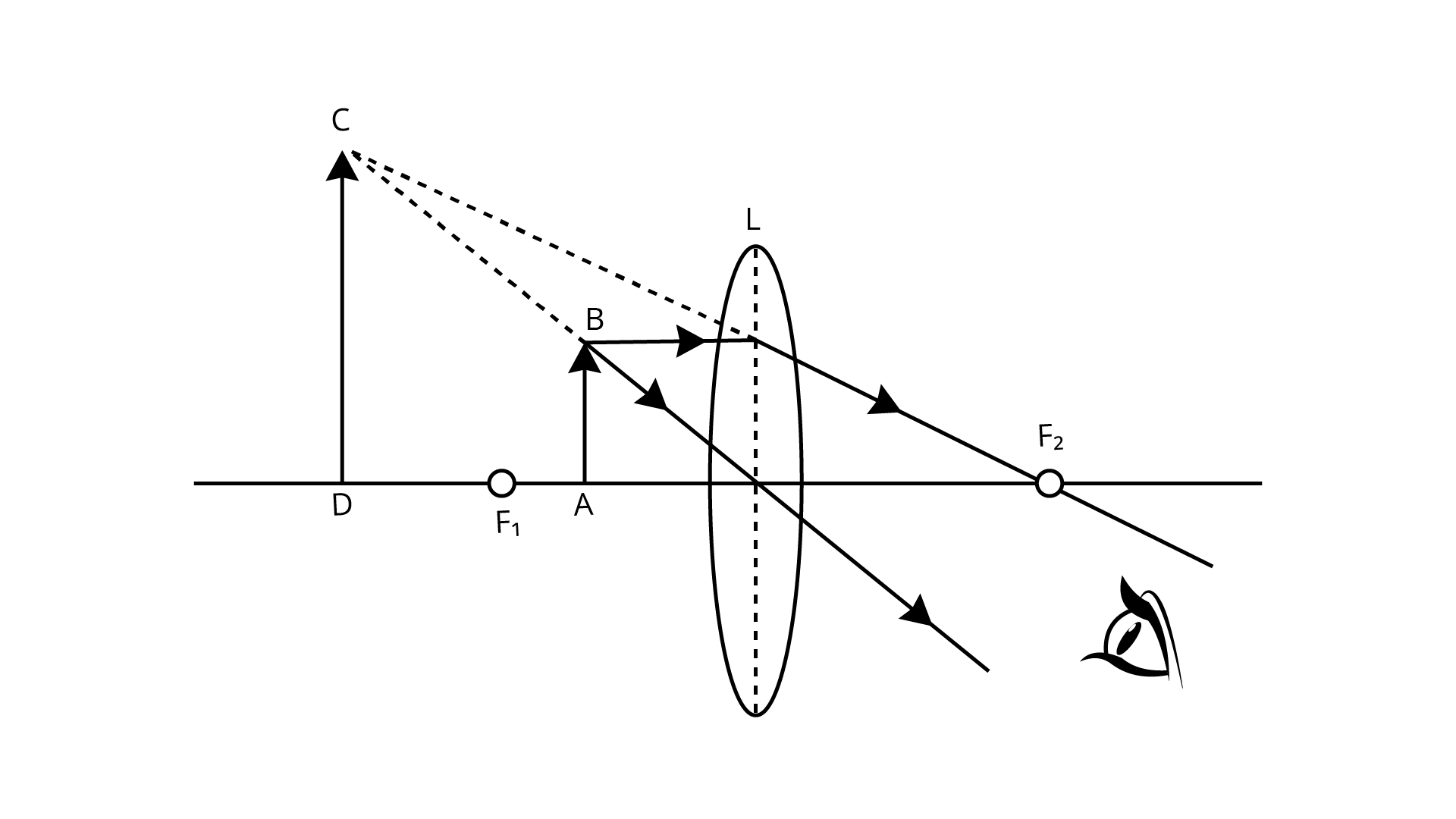
(b) State three characteristics of the image in relation to the object.
Ans: The magnified, virtual and upright are the three characteristics of the image.
38. The diagram given below in fig. shows the position of an object OA in relation to a converging lens L whose foci are at F1 and F2.
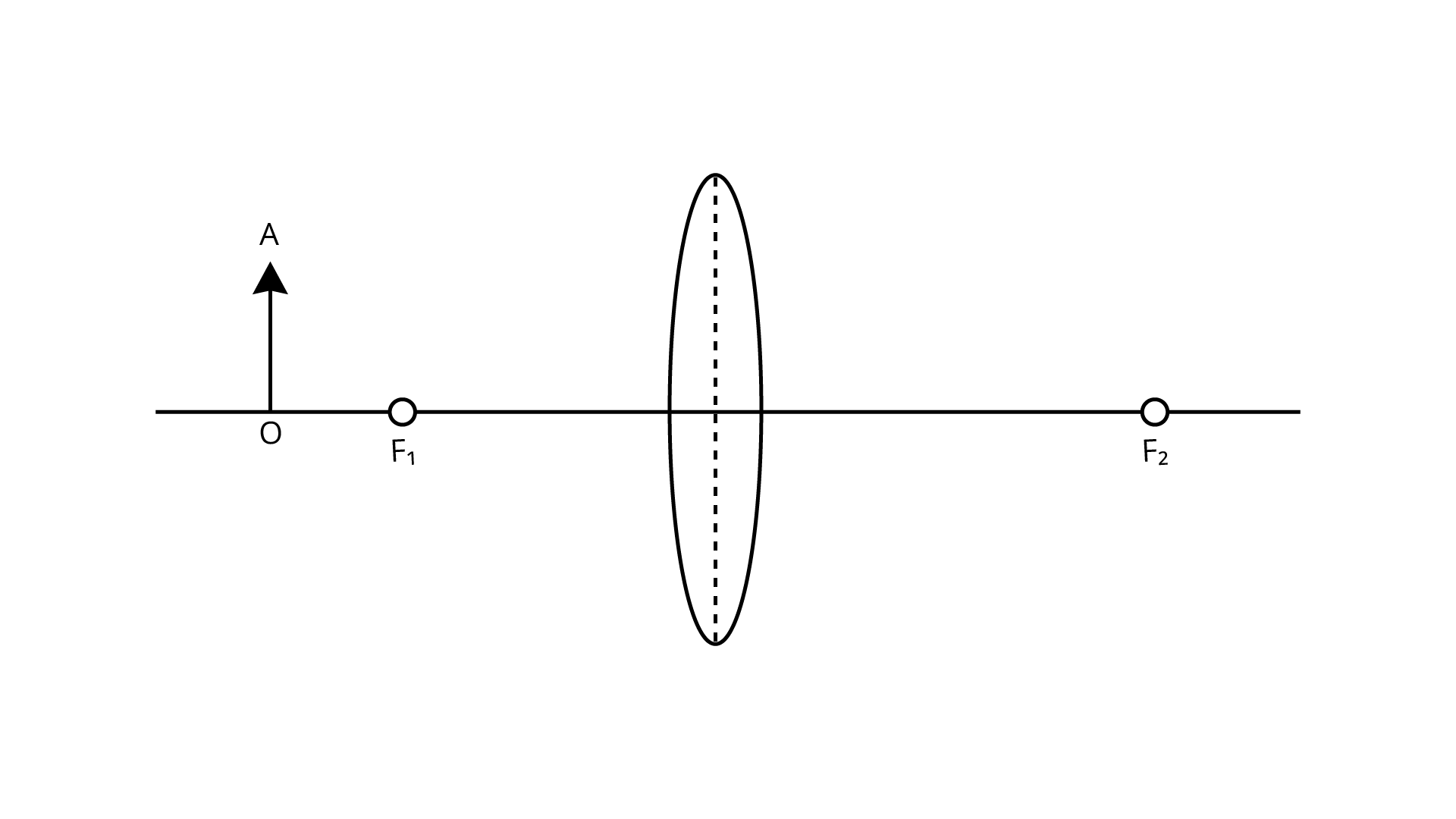
(i) Draw two rays to locate the position of the image.
Ans:
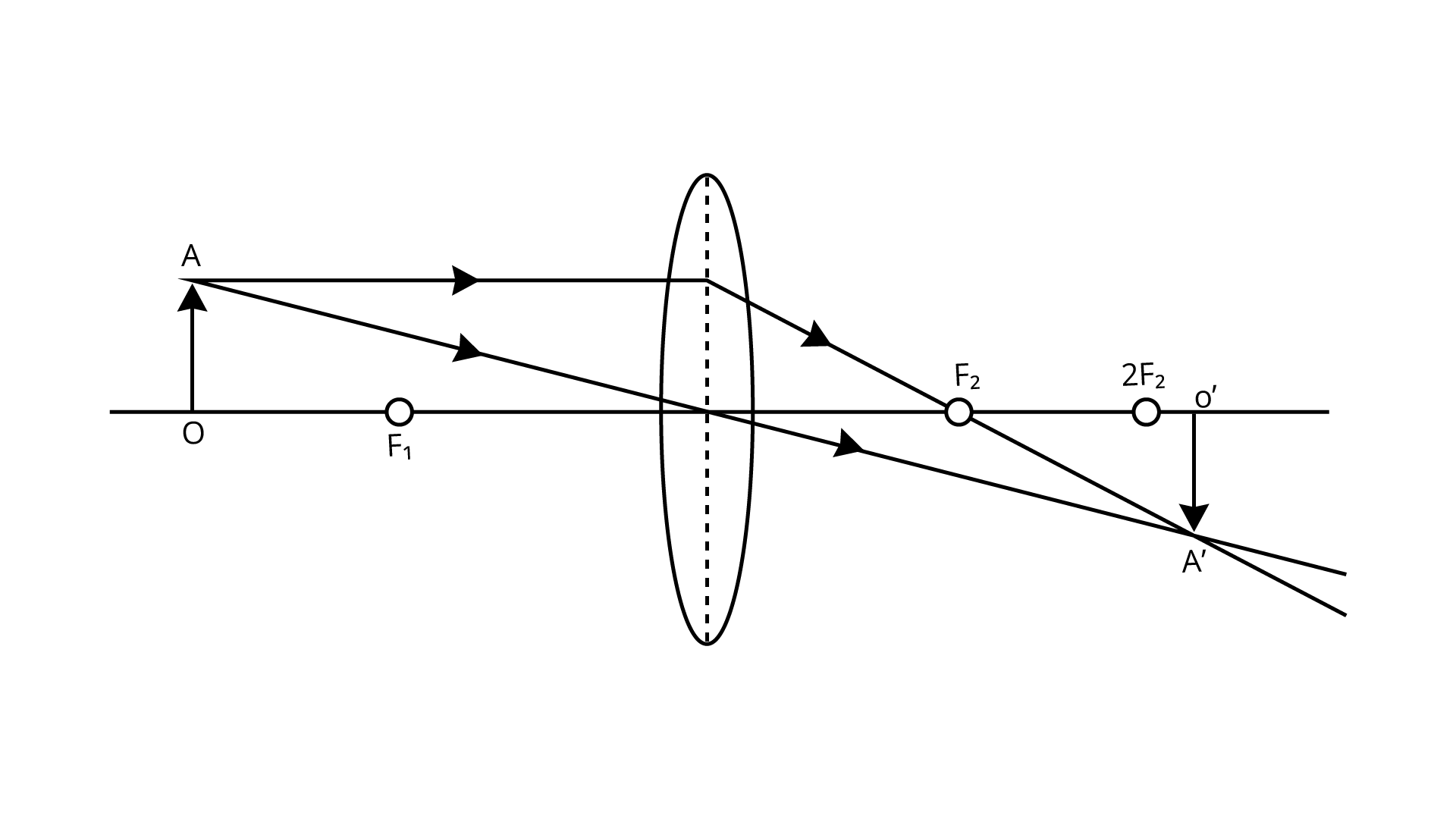
(ii) State the position of the image with reference to the lens.
Ans: Images position will be more than that of twice the focal length of the lens.
(iii) Describe the three characteristics of the image.
Ans: The magnified, real and inverted are the three characteristics of this image.
(iv) Describe how the distance of the image from the lens and the size of the image change as the object moves towards F1.
Ans: The image will shift away from F2 as the object moves towards F1 and it is magnified.
The image will form at infinity and it is highly magnified at F1. Between F1 and the optical center, the image will form on the same side of the object and will be magnified.
39. A converging lens forms the image of an object placed in front of it, beyond 2F2 of the lens.
(a) Where is the object placed?
Ans: The object is placed beyond the 2F1.
(b) Draw a ray diagram to show the formation of the image.
Ans: The image is formed beyond the 2F2.
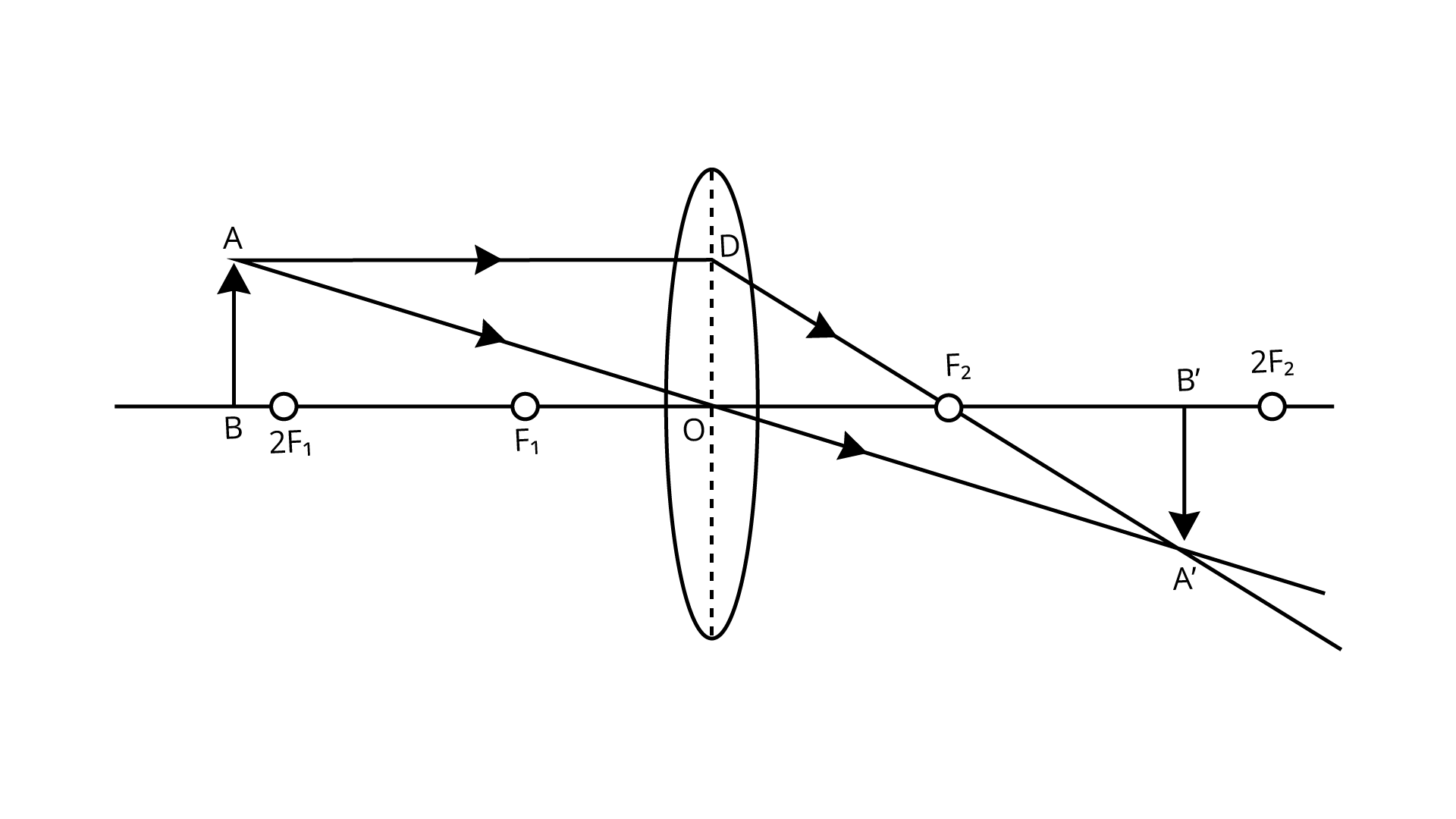
(c) State the three characteristics of the image.
Ans: The real, inverted and diminished are the three characteristics of the image.
40. A convex lens forms an image of an object equal to the size of the object.
(a) Where is the object placed in front of the lens?
Ans: The object is placed at a distance equal to twice the focal length of the lens.
(b) Draw a diagram to illustrate it.
Ans:
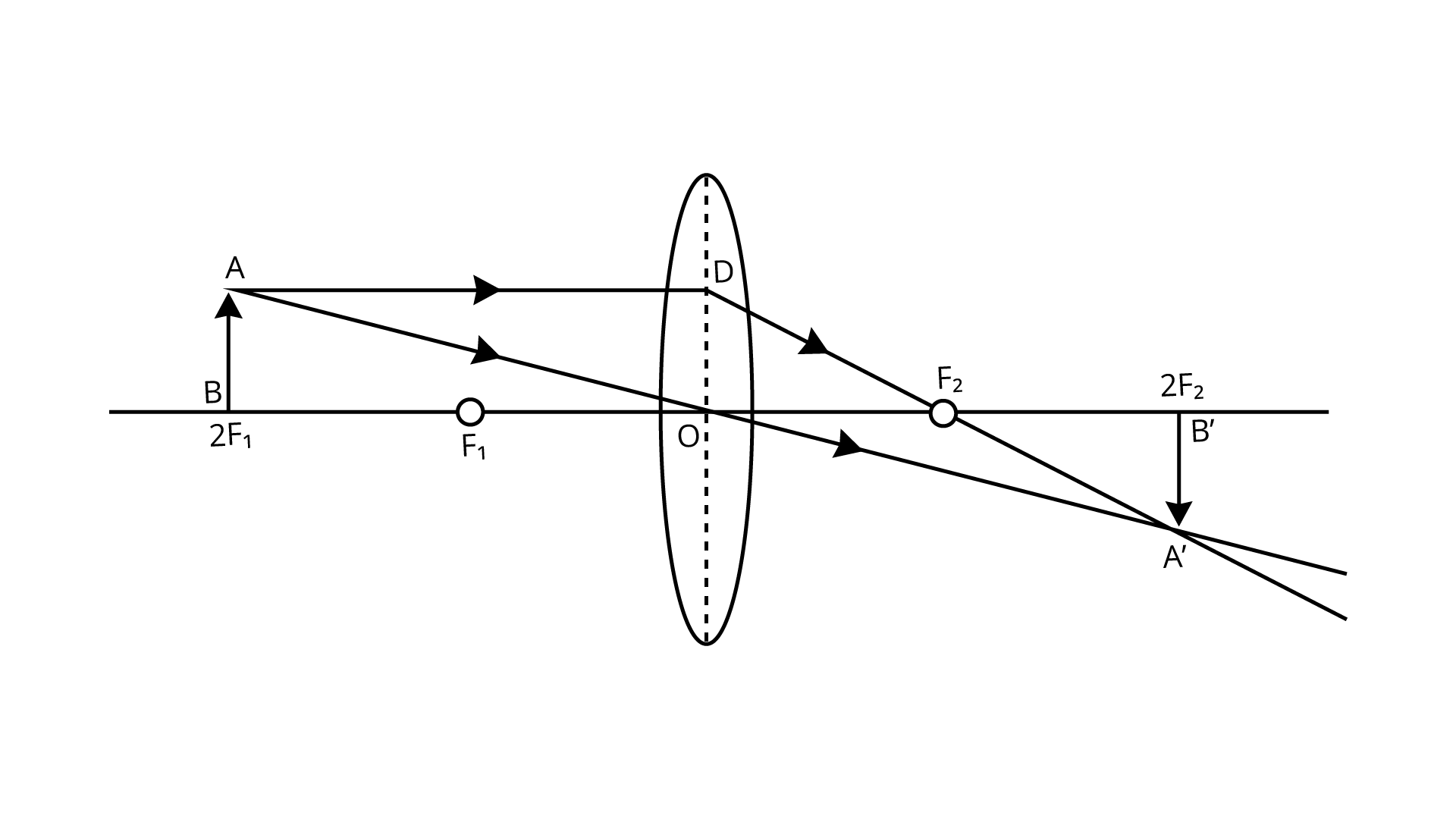
(c) State two more characteristics of the image.
Ans: The image formed is real and inverted.
41. A lens forms an erect, magnified and virtual image of an object.
(a) Name the kind of lens.
Ans: Convex lens.
(b) Where is the object placed in relation to the lens?
Ans: The object is placed between the lens and focus (F1).
(c) Draw a ray diagram to show the formation of the image.
Ans:
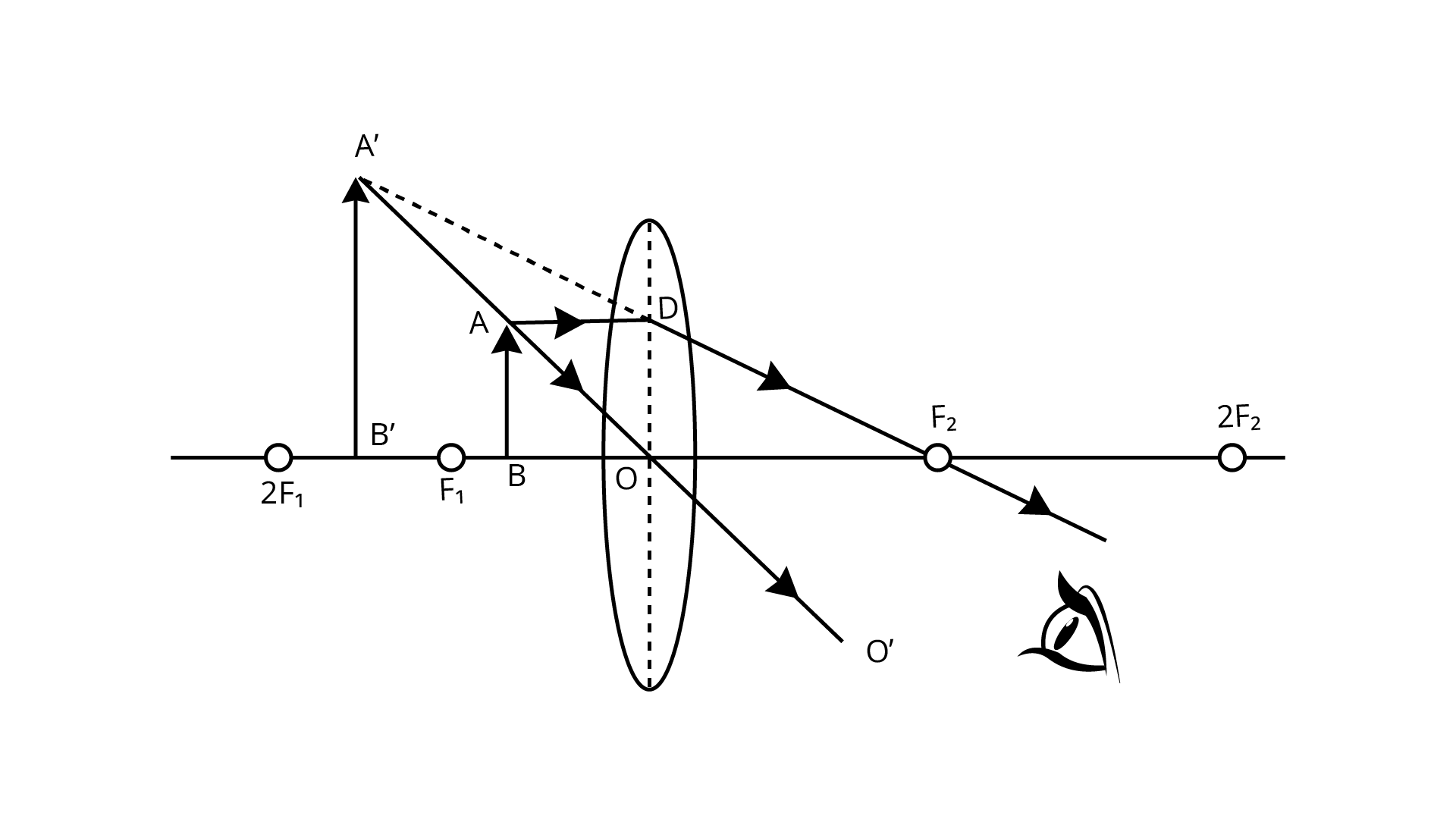
(d) Name the device which uses this principle.
Ans: The device which uses this principle is the magnifying glass.
42. A lens always forms an image between the object and the lens.
(a) Name the lens.
Ans: The lens that forms the image between the object and itself is a concave lens.
(b) Draw a ray diagram to show the formation of such an image.
Ans: The ray diagram is shown below:
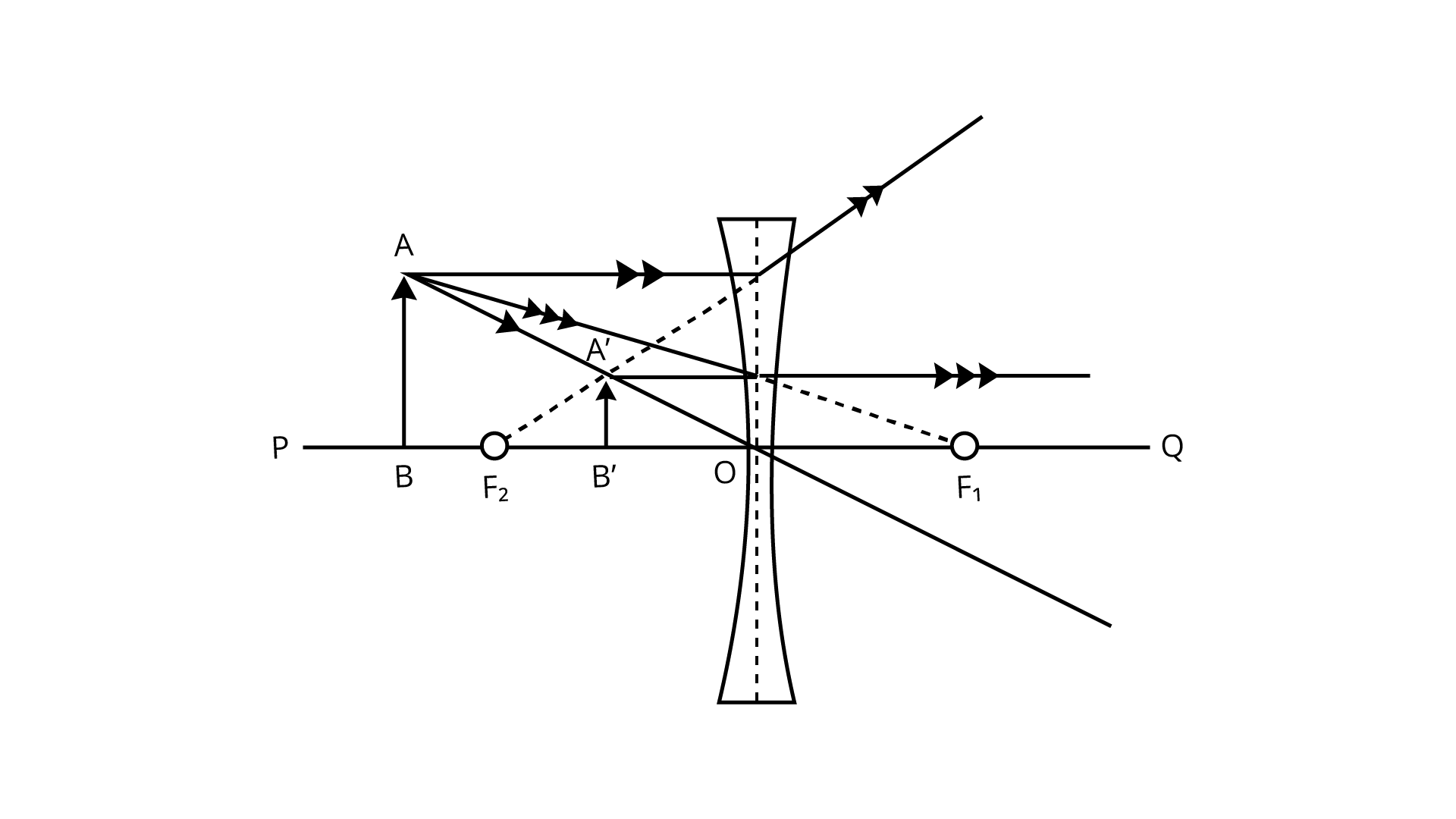
(c) State three characteristics of the image.
Ans: The virtual, erect and diminished are the three characteristics of the image.
43. Classify as real or virtual, the image of a candle flame formed on a screen by a convex lens. Draw a ray diagram to illustrate how the image is formed.
Ans: Let the object be placed beyond 2F1 and its diminished image formed between F2 and 2F2 which is real and inverted. In the figure given below the object is AB and its real and inverted image which is formed between F2 and 2F2.
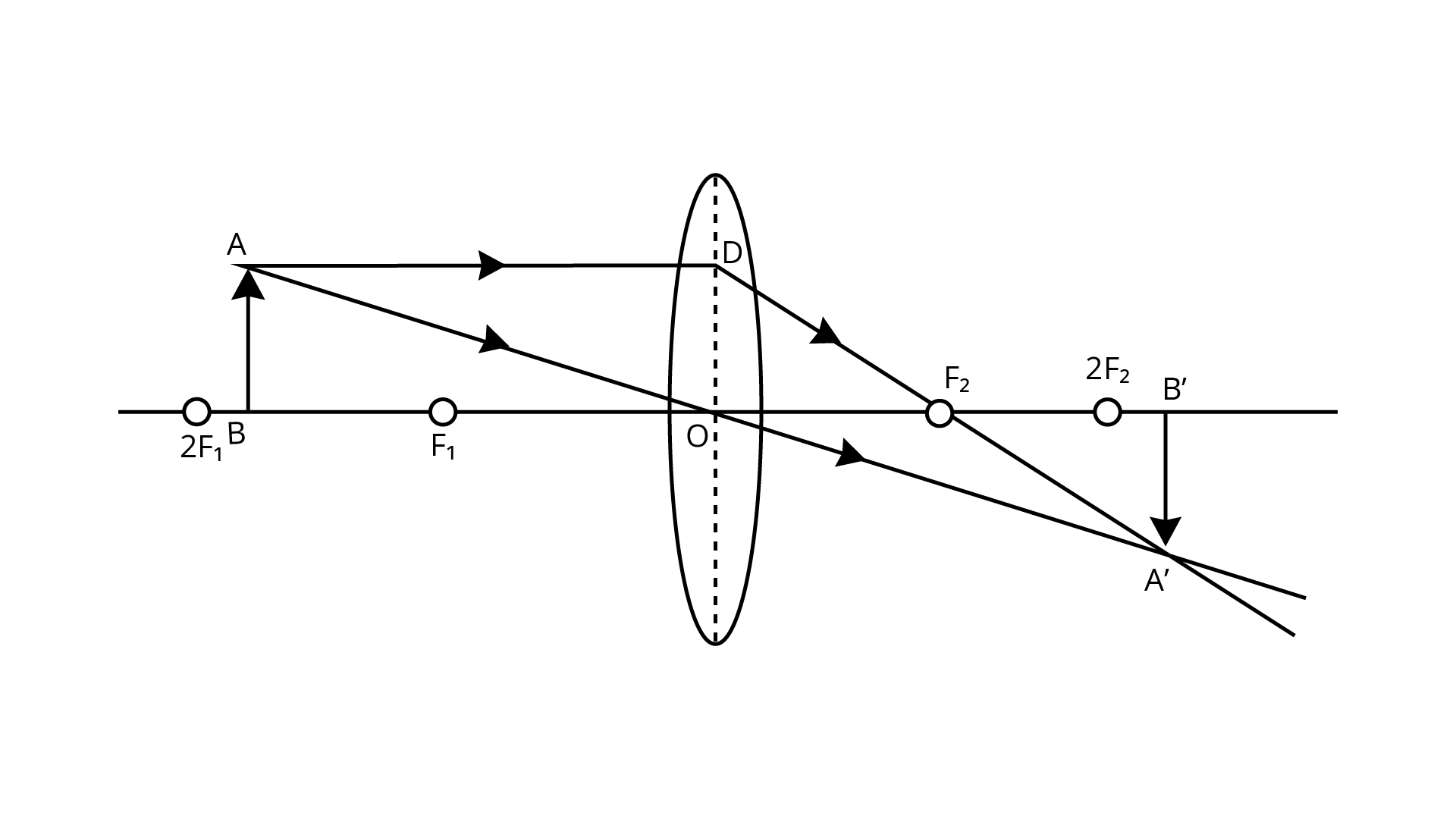
44. Show by a ray diagram that a diverging lens cannot form a real image of an object placed anywhere on its principal axis.
Ans: The diagram is given as follows:
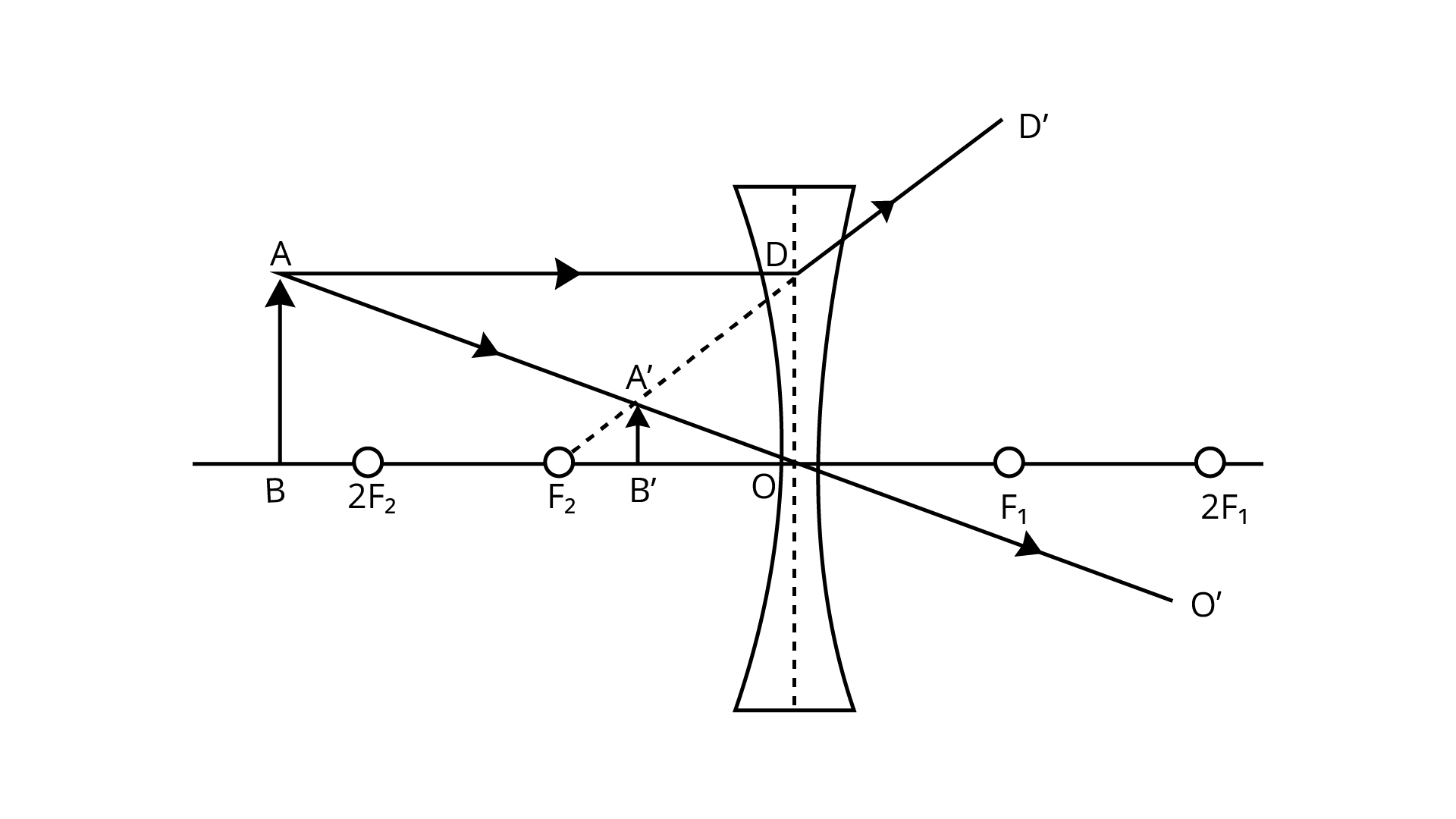
45. Draw a ray diagram to show how a converging lens can form a real and enlarged image of an object.
Ans: The below figure shows the image formed is real, enlarged and inverted.
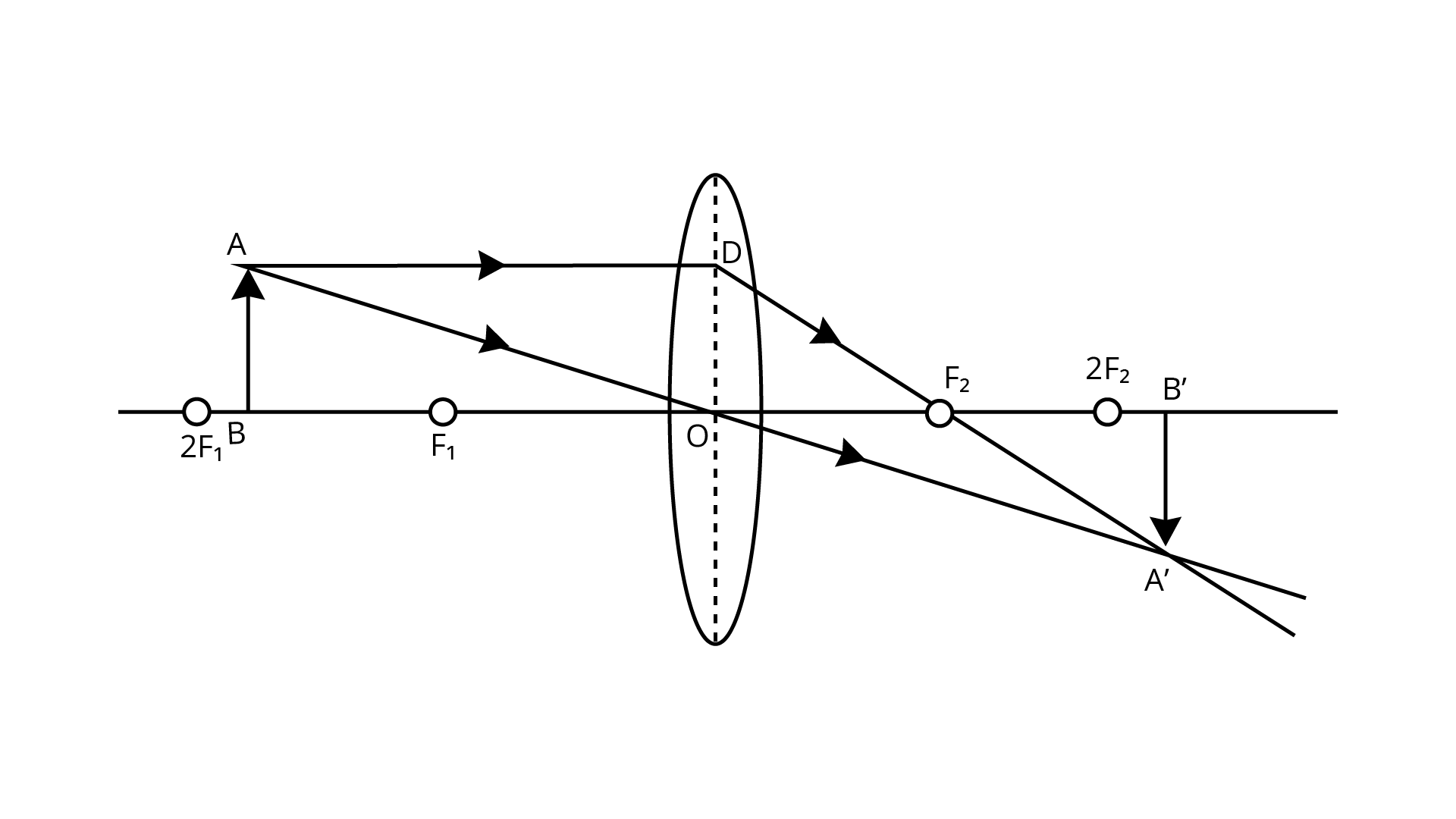
46. A lens forms an upright and diminished image of an object placed at its focal point.
Name the lens and draw a ray diagram to show the formation of the image.
Ans: The ray diagram of the image formation due to a concave lens is given below when an object is placed at the focus of the lens. We can clearly see here that a diminished but upright image is formed by the concave lens.
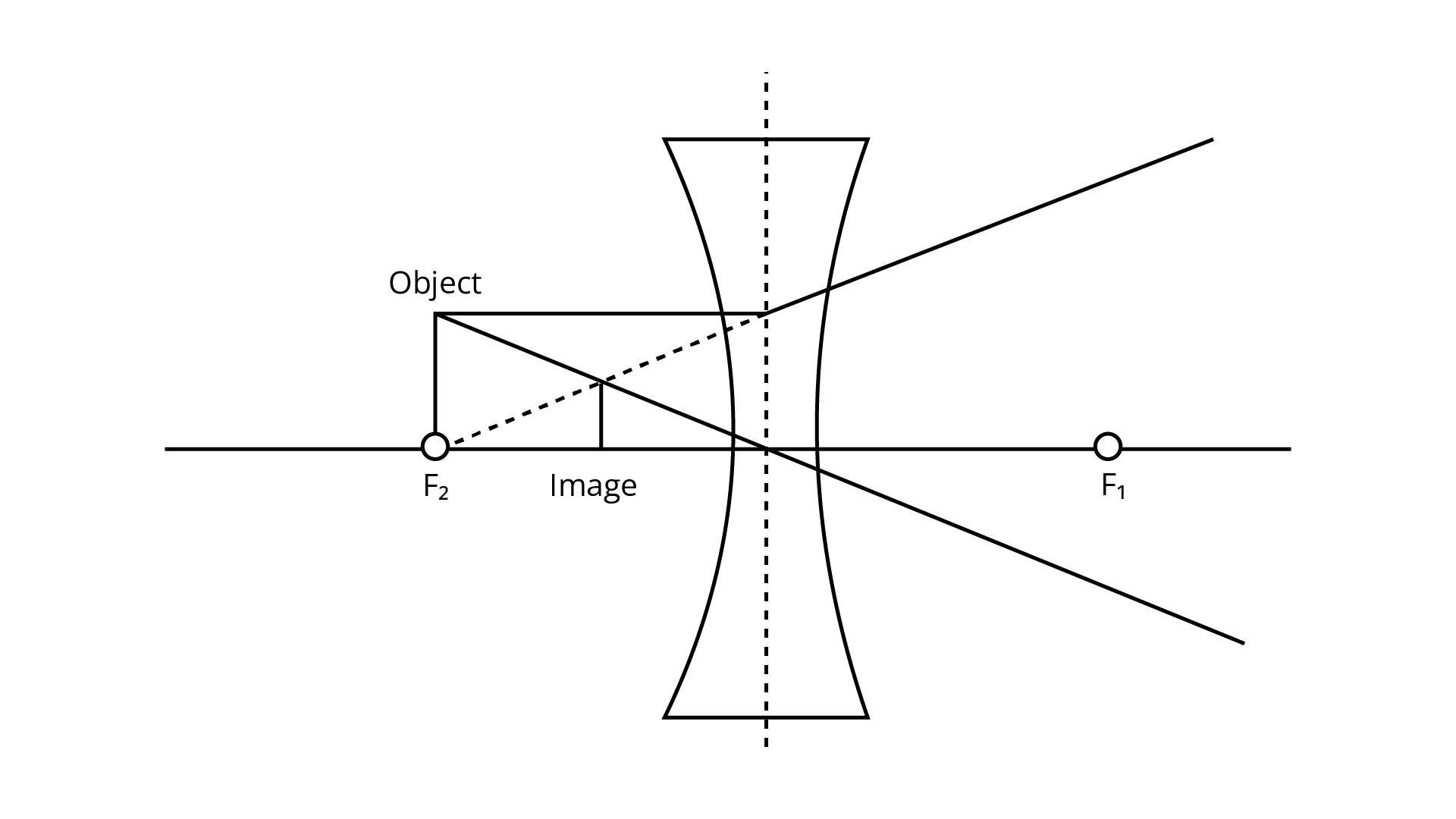
47. Draw a ray diagram to show how a converging lens is used as a magnifying glass to observe a small object. Mark on your diagram the foci of the lens and the position of the eye.
Ans: The object is placed between the focal point F and the convex lens and its image is formed at the same side of the lens which is enlarged. Therefore this lens can be used as a magnifying lens.
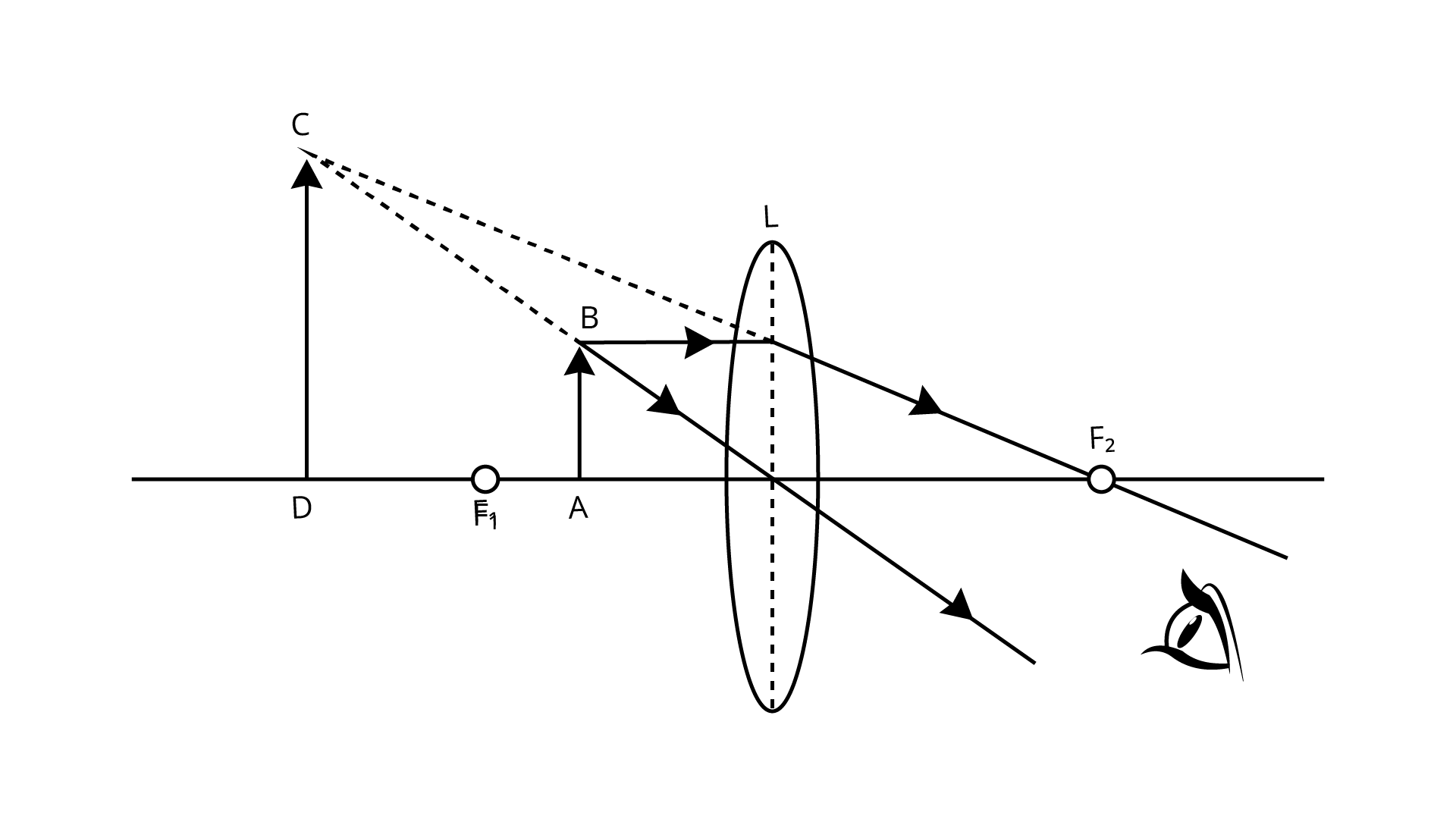
48. Draw a ray diagram to show how a converging lens can form an image of the sun.
Hence give a reason for the term 'burning glass' for a converging lens used in this manner.
Ans: The sun is at infinity so that the convex lens forms its image at the second focal point which is a real and very much diminished in size.Whereas using the convex lens as burning glass, the rays of light from the sun are brought to focus on a piece of paper kept at the second focal plane of the lens. Because of the sufficient heat of the sun rays, the paper burns. Therefore this lens is termed as the 'burning glass'.
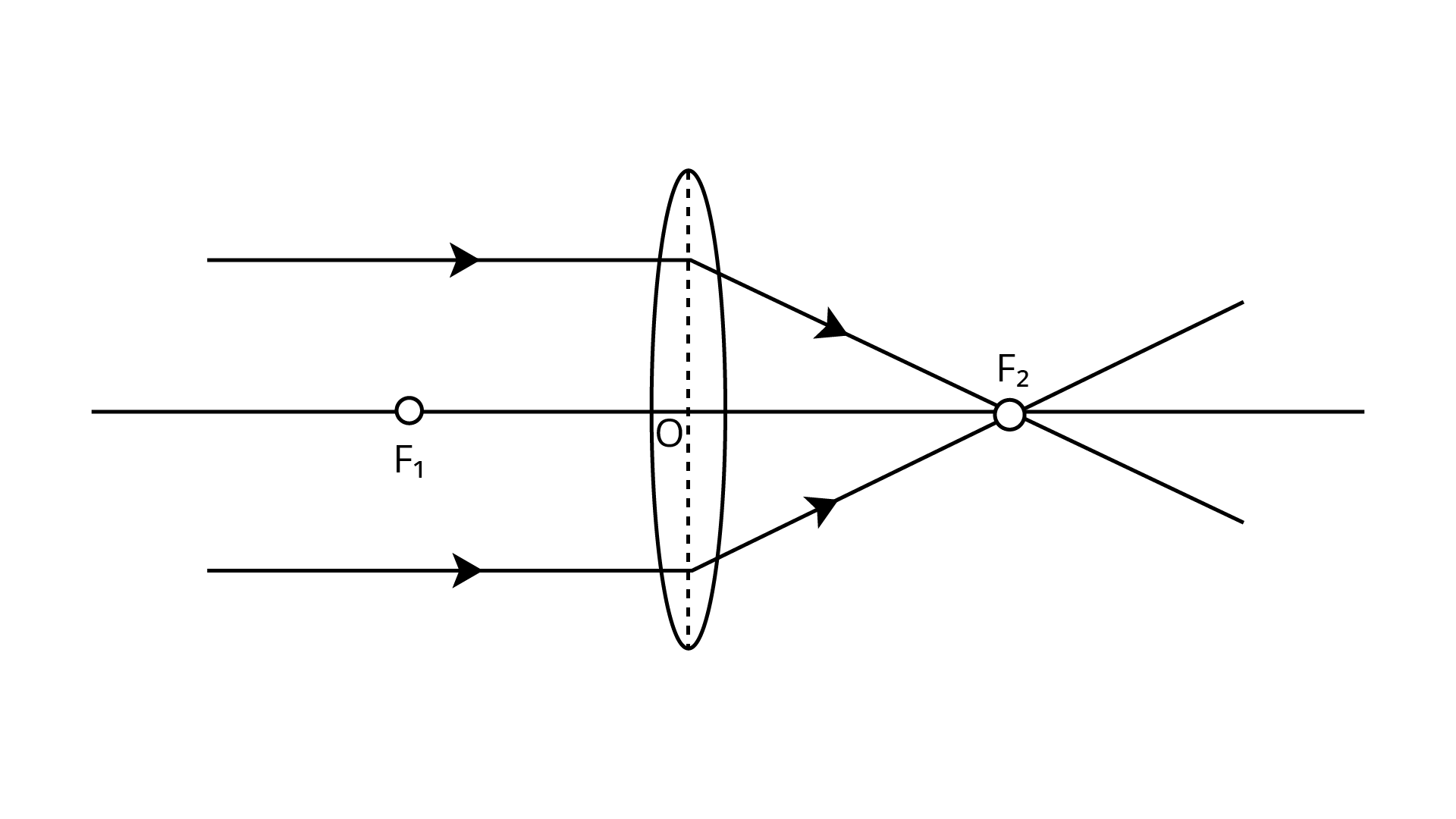
49. A lens forms an inverted image of an object.
(a) Name the kind of lens.
Ans: This lens is a convex lens.
(b) State the nature of the image whether real or virtual?
Ans: The nature of the image is real.
50. A lens forms an upright and magnified image of an object.
(a) Name the lens.
Ans: The lens used here is a convex lens
(b) Draw a labeled ray diagram to show the image formation.
Ans: The ray diagram is as follows:
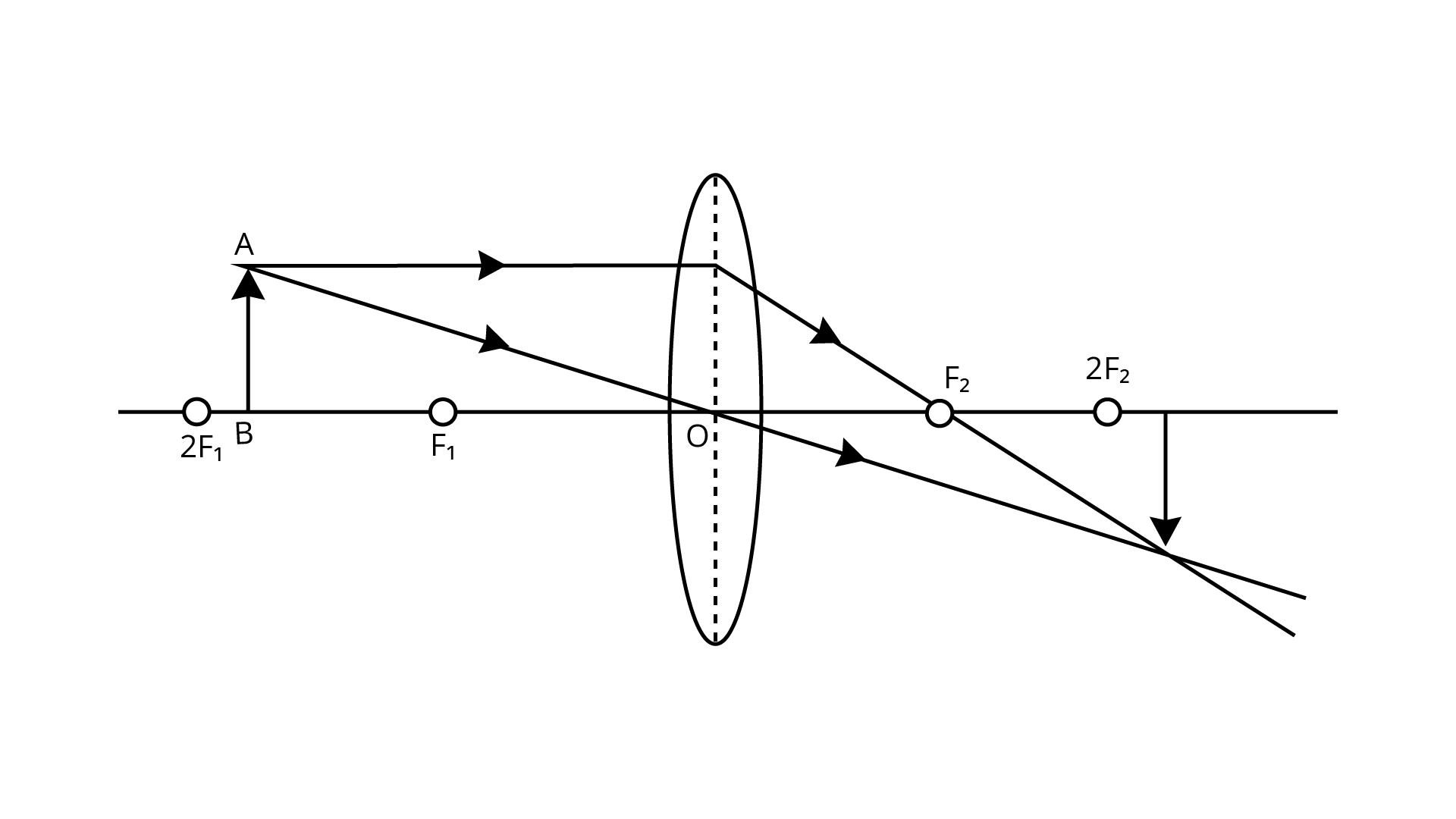
51. (a) Name the lens which always forms an erect and virtual image.
Ans: The lens used here is a concave lens.
(b)State whether the image in part (a) is magnified or diminished?
Ans: The image is diminished.
52. Can a concave lens form an image of size two times that of the object? Give a reason?
Ans: No, a concave lens cannot form an image of size two times that of the object since it diverges the rays incident on it and only produces a diminished image.
53. Give two characteristics of the image formed by a concave lens.
Ans: The image formed by a concave lens is the virtual and the diminished.
54. Give two characteristics of the virtual image formed by a convex lens.
Ans: The virtual image formed by a convex lens will be erect and magnified.
55. In each of the following cases, where must an object be placed in front of a convex lens so that the image formed is
(a) At infinity,
Ans: At focus.
(b) Of same size as the object
Ans: At 2F.
(c) Inverted and enlarged
Ans: Between F and 2F.
(d) Upright and enlarged?
Ans: Between optical center and focus.
56. Complete the following table:
Type of Oens | Position of Object | Nature of Image | Size of Image |
Convex | Between Optical Center and Focus | ||
Convex | At Focus | ||
Concave | At Infinity | ||
Concave | At Any Distance |
Ans:
Type of Lens | Position of Object | Nature of Image | Size of Image |
Convex | Between the optical center and focus | Virtual and upright | Magnified |
Convex | At focus | Real and inverted | Very much magnified |
Concave | At infinity | Virtual and upright | Highly diminished |
Concave | At any distance | Virtual and upright | Diminished |
57. State the changes in the position, size and nature of the image when the object is brought from infinity up to the convex lens. Illustrate your answer by drawing the ray diagrams.
Ans:
a) The position of the image is at F2 when the object is situated at infinity. It is very much diminished in size and it is real and inverted.
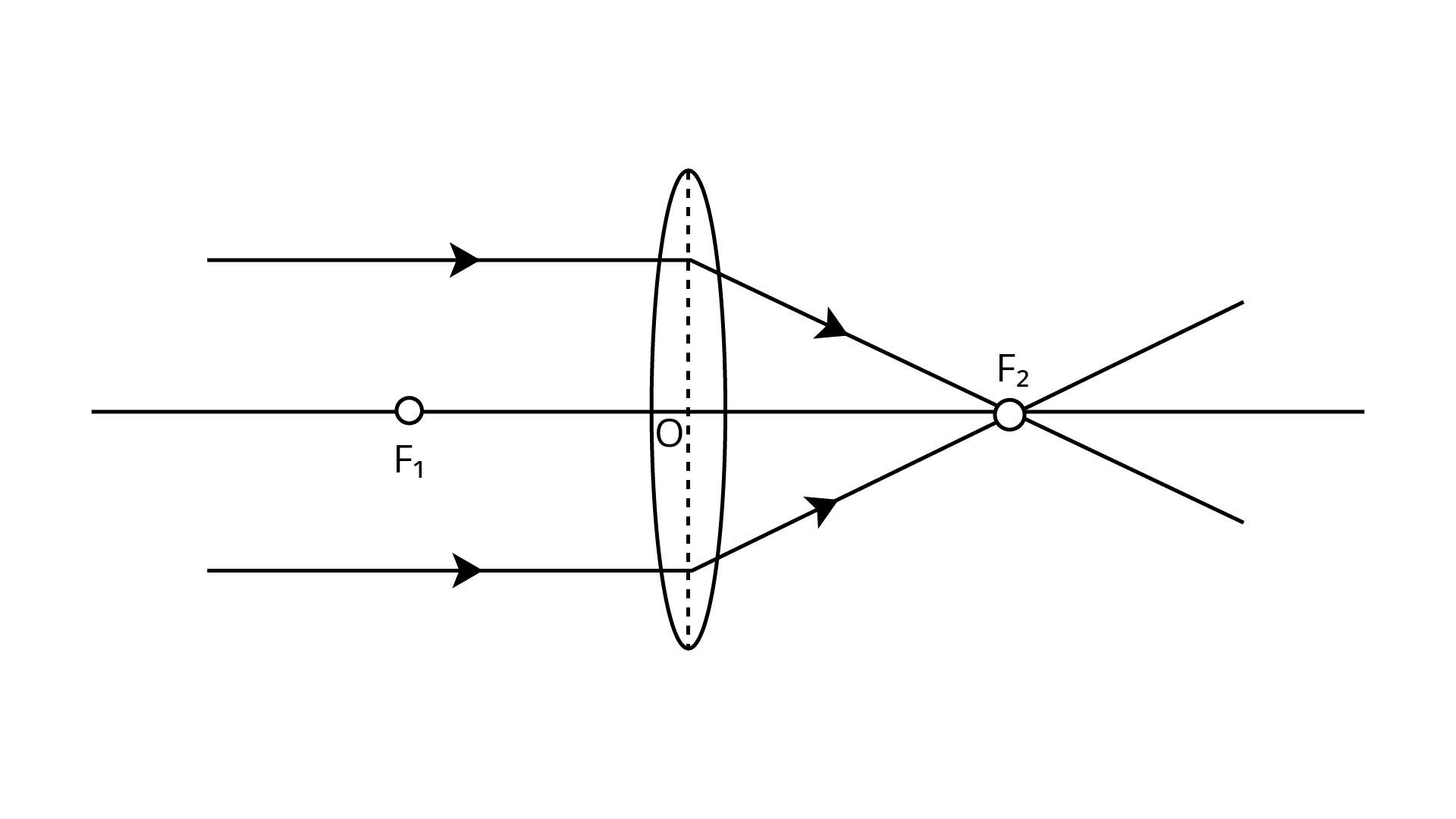
b) The position of image (A’B’) is between F2 and 2F2 when the object (AB) is situated beyond 2F1. It is diminished in size and real and inverted.
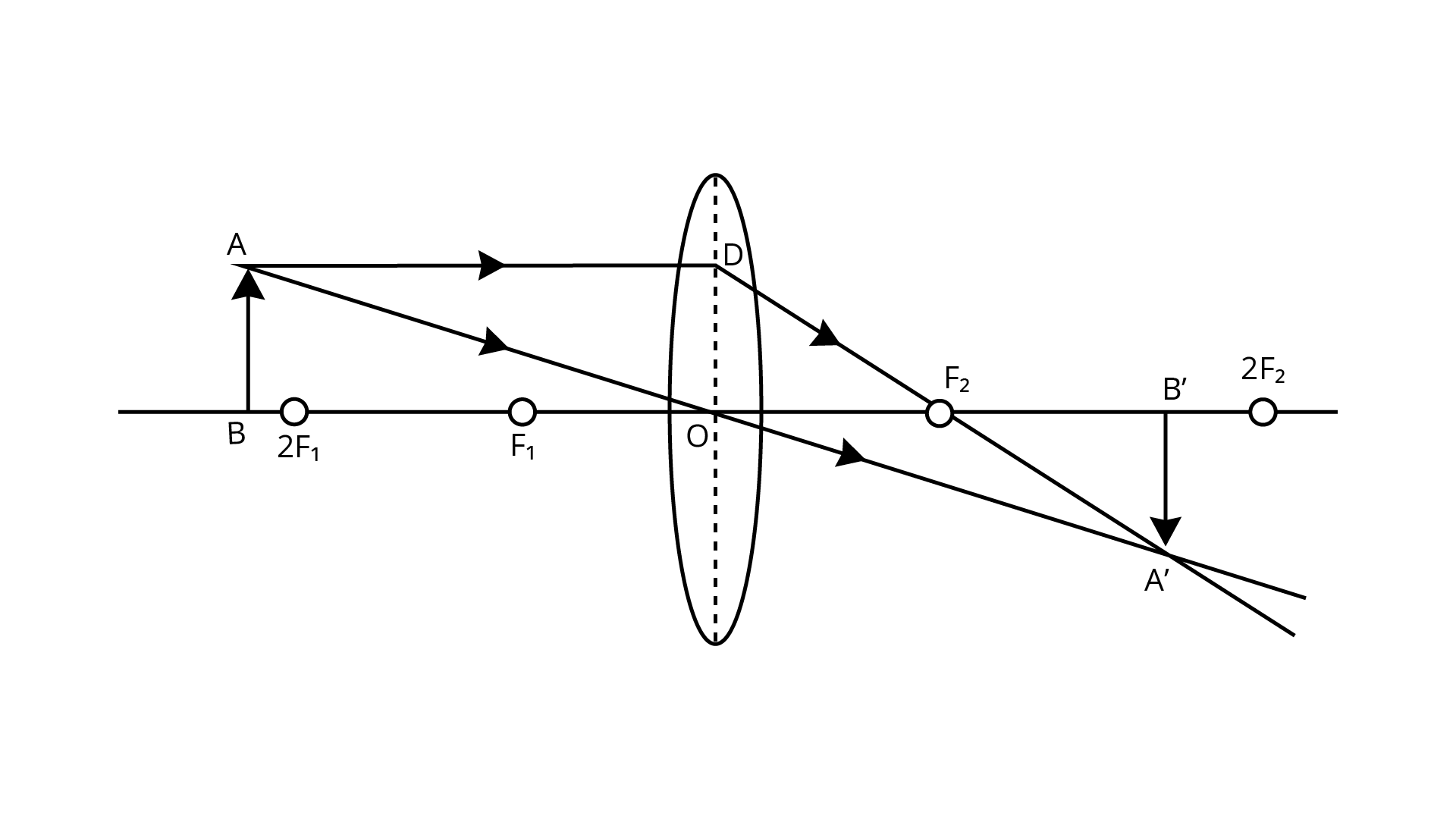
c) The position of image (A’B’) is at 2F2 when the object (AB) is situated at 2F1. It is the same size as the object and real and inverted.
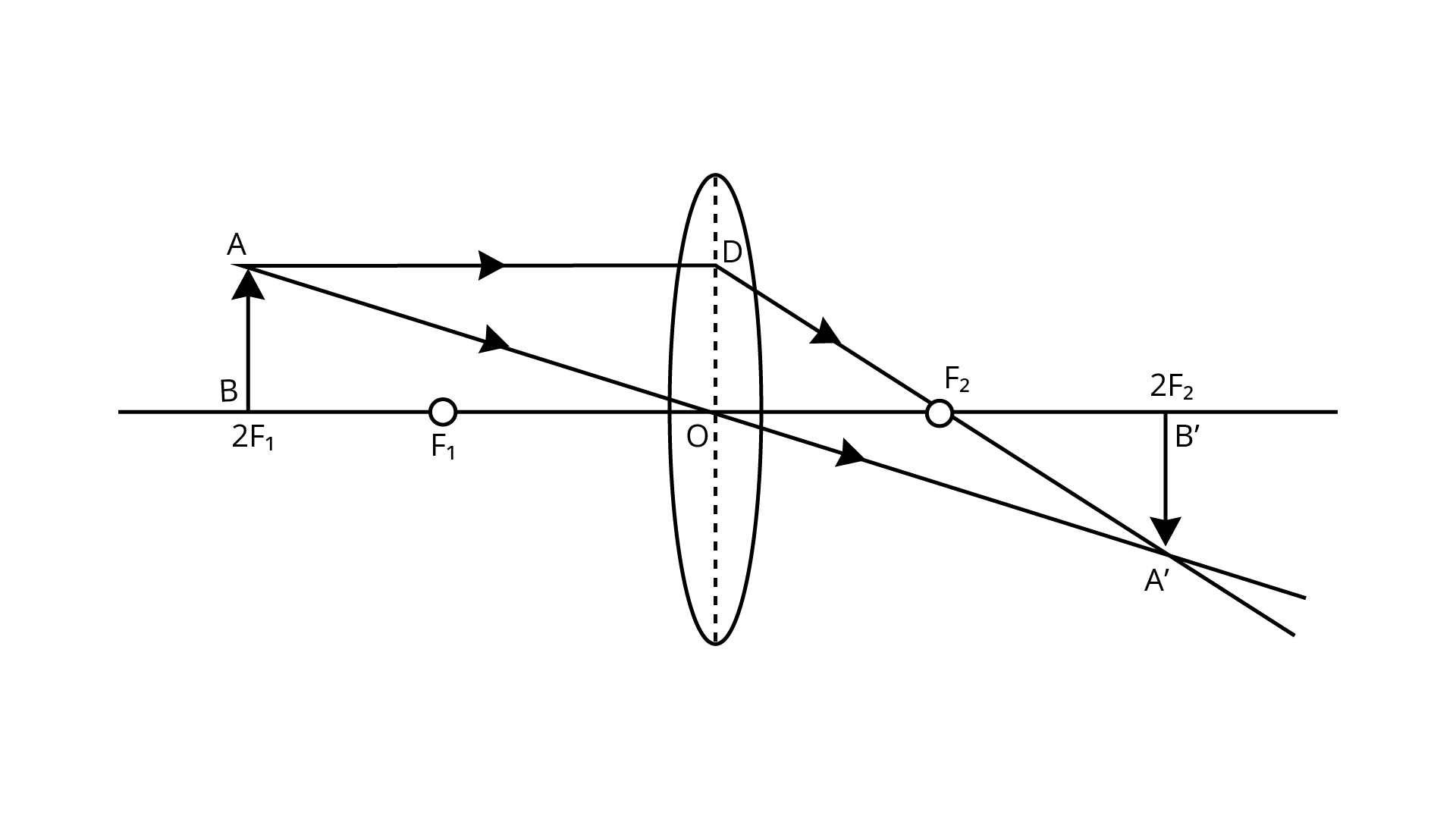
d) The position of image (A’B’) is beyond 2F2 when the object (AB) is situated between 2F1 and F1. It is magnified in size and real and inverted.
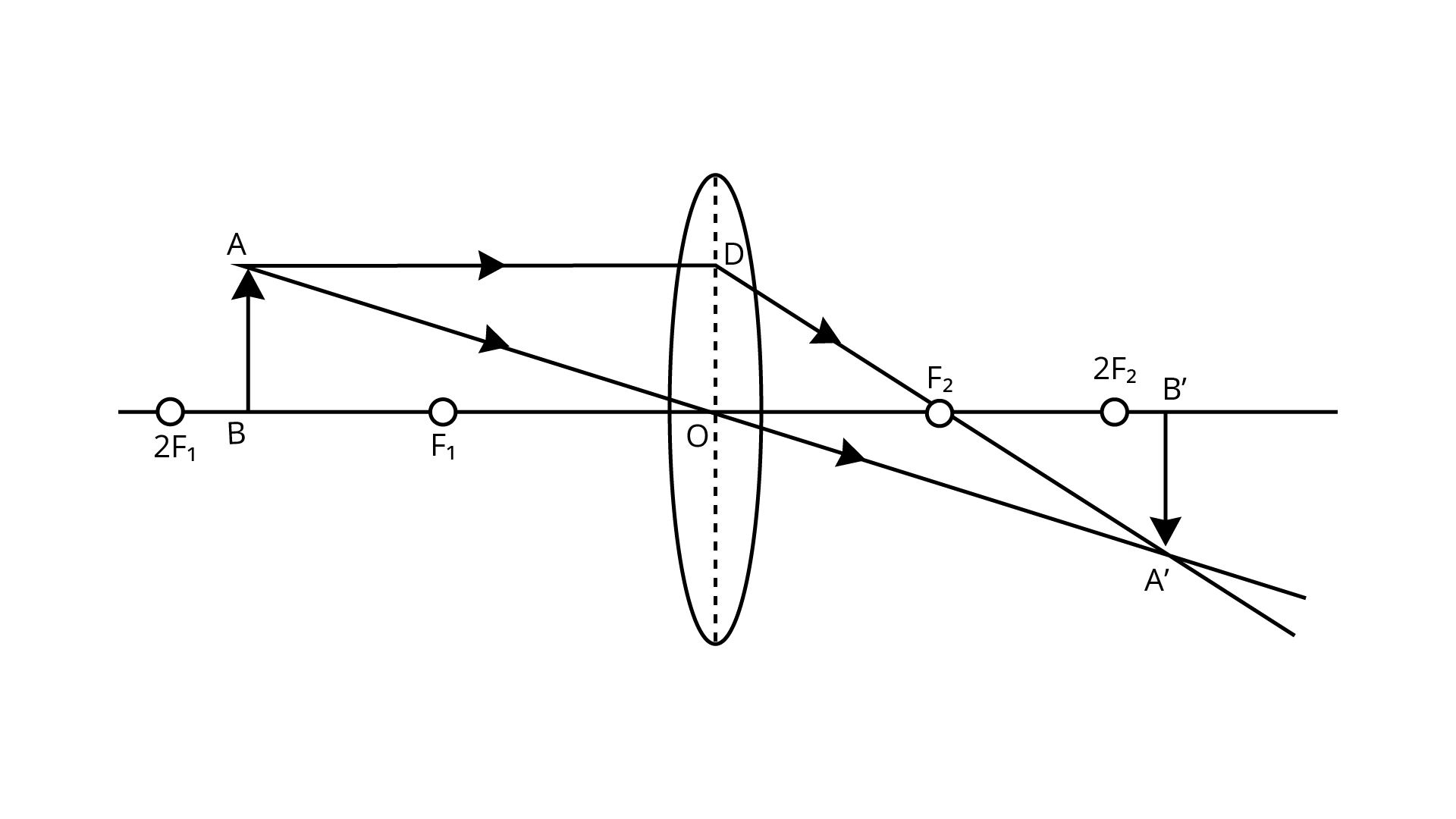
e) The position of the image is at infinity when the object (AB) is situated at F1. It is very much magnified in size and real and inverted.
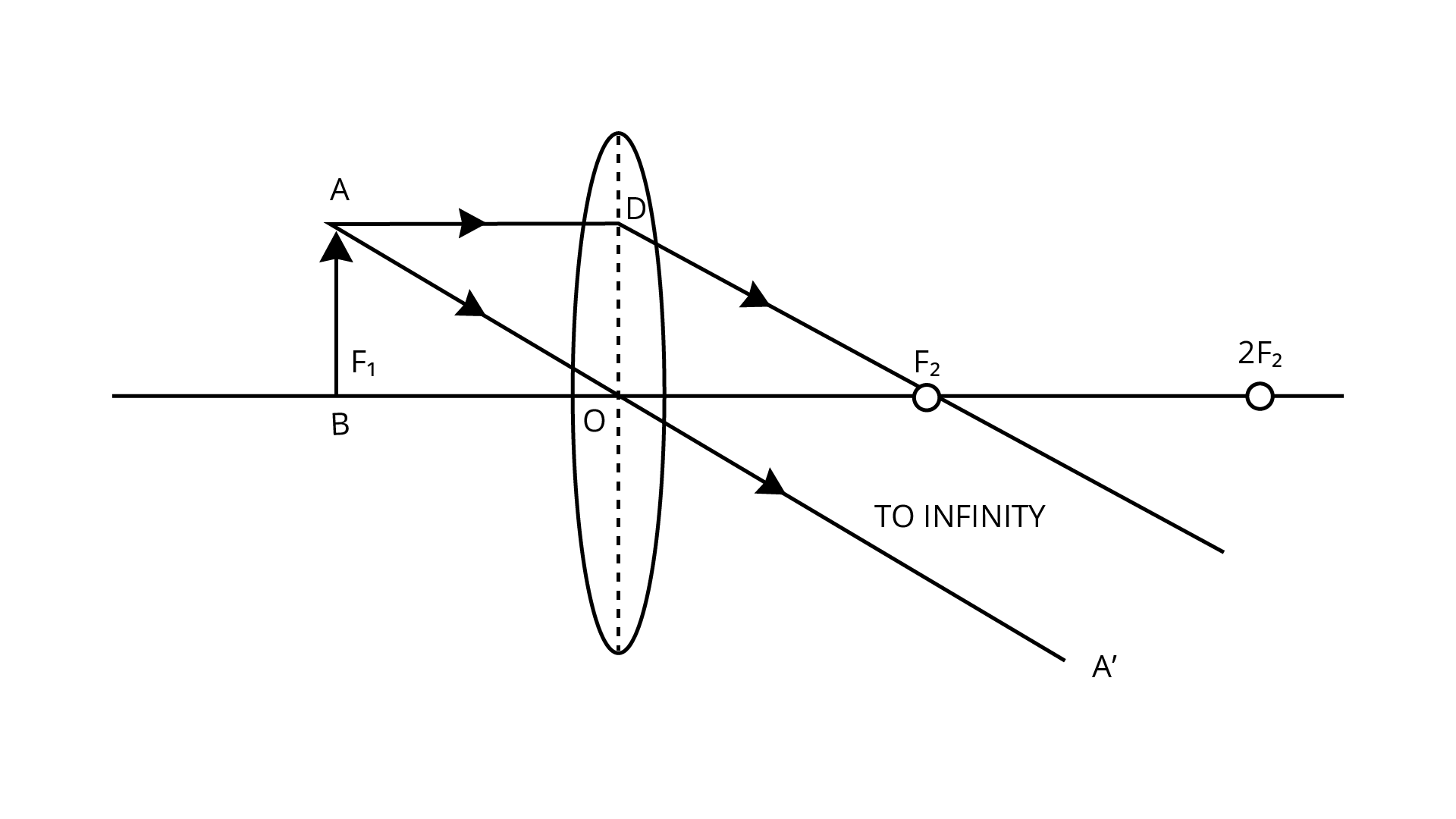
f) The position of (CD) is on the same side when the object (AB) is situated between the lens and F1. It is magnified in size and virtual and upright.
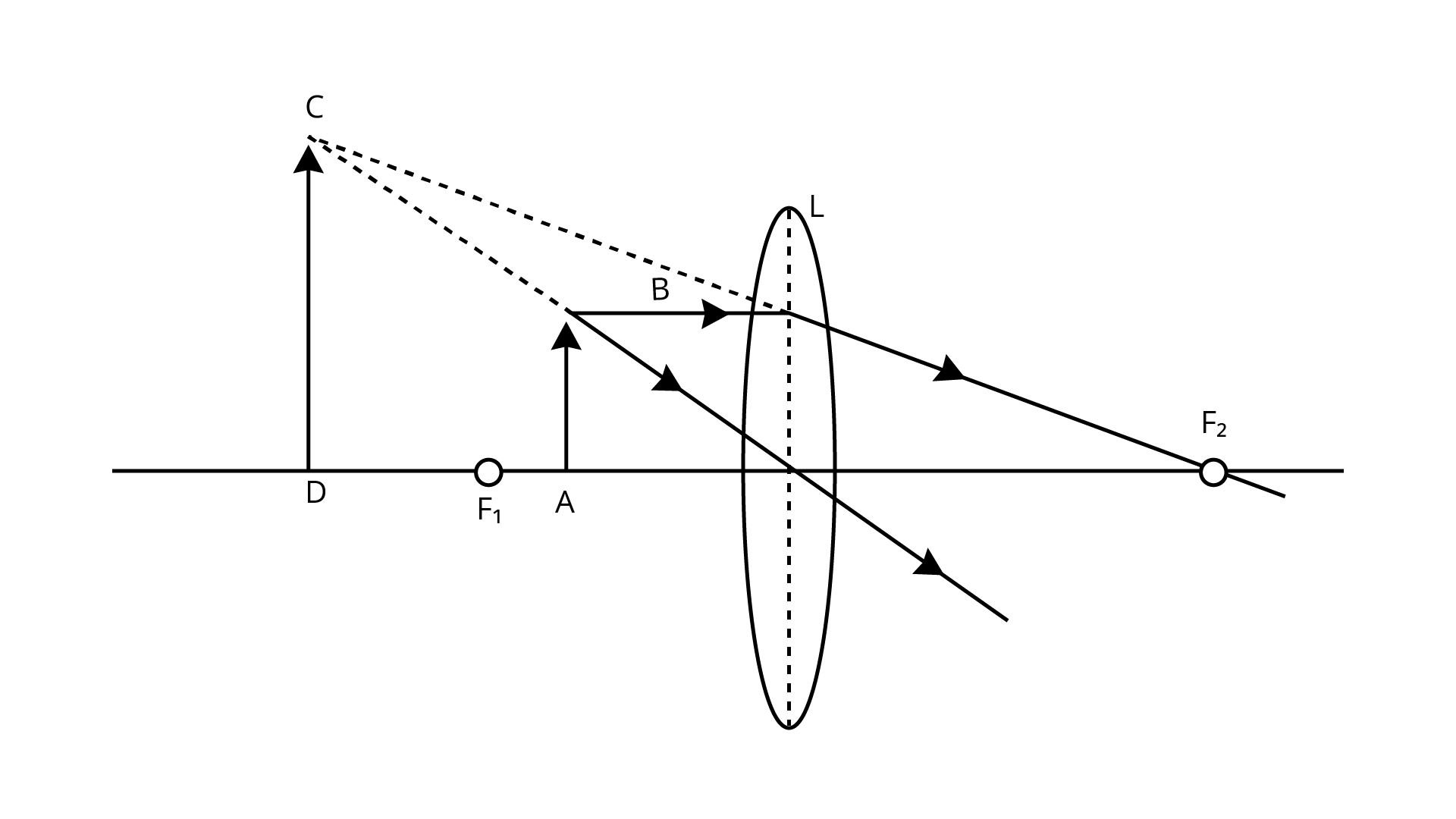
58. State the changes in the position, size and nature of the image When the object is brought from infinity up to a concave lens. Illustrate your answer by drawing diagrams.
Ans:
a) The parallel rays from the object appear to fall on the concave lens due to which the image forms at focus when the object (AB) is situated at infinity. This image is highly diminished in size and virtual and upright.
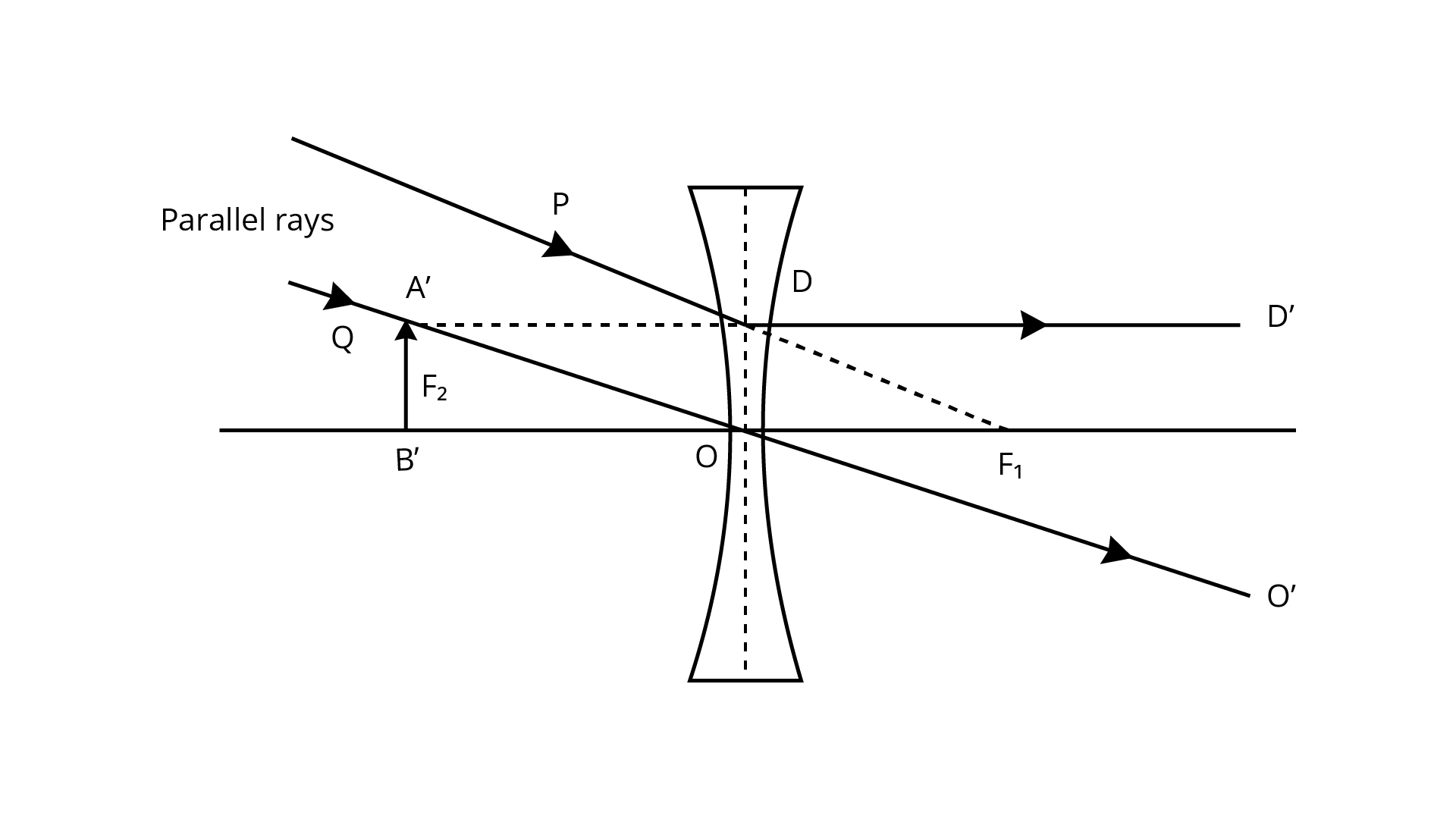
b) The image forms between focus and optical center when the object (AB) is situated at any point between infinity and the optical center of the lens. This image is diminished in size and virtual and upright.
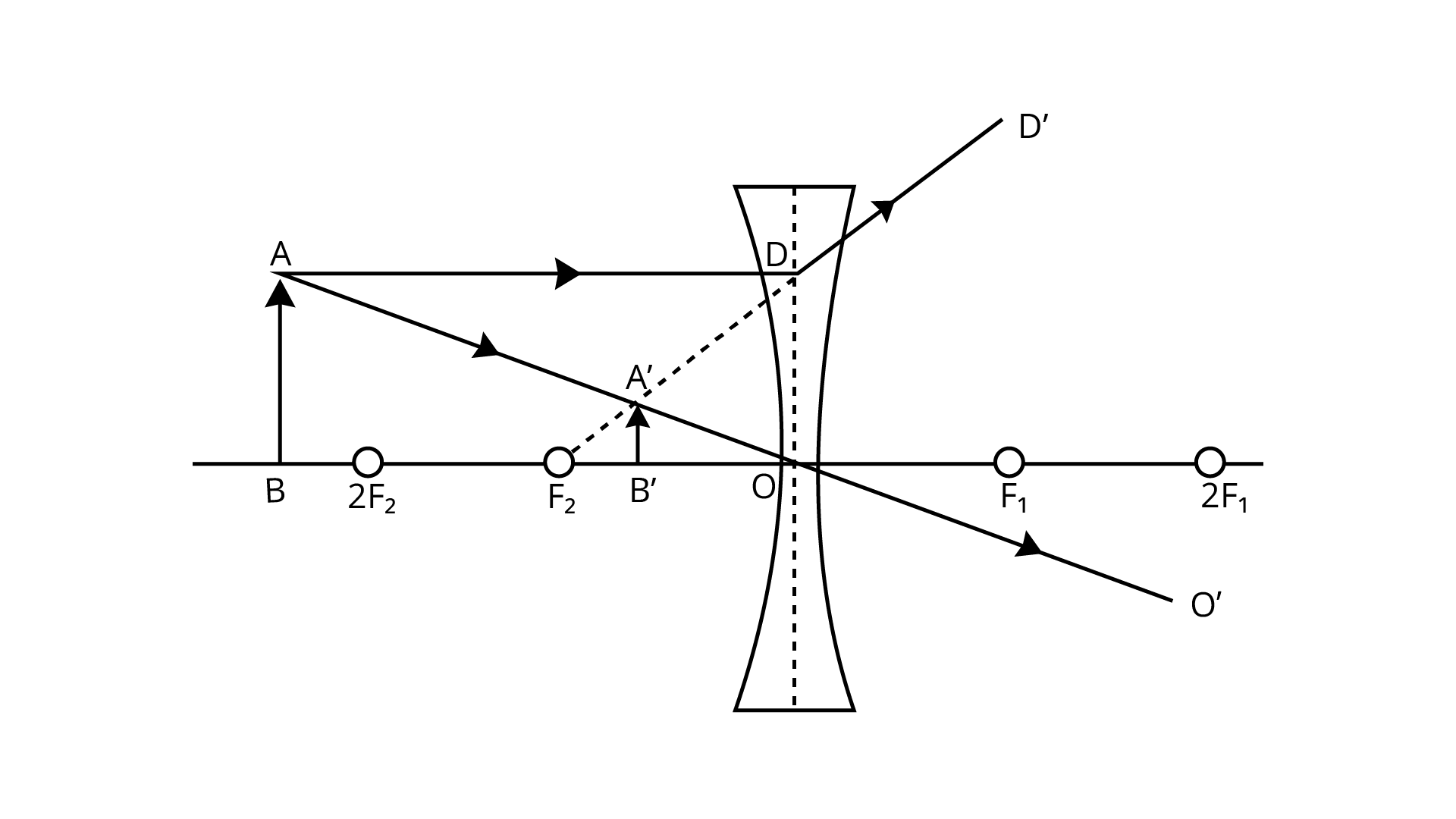
59. Complete the following sentence
(a) An object is placed at a distance of more than 40 cm from a convex lens of focal length 20 cm. The image formed is real, inverted and…………….
Ans: An object is placed at a distance of more than 40 cm from a convex lens of focal length 20 cm. The image formed is real, inverted and diminished.
(b) An object is placed at a distance 2f from a convex lens of focal length f. The image formed is…………….that of the object.
Ans: An object is placed at a distance 2f from a convex lens of focal length f. The image formed is equal to that of the object.
(c) An object is placed at a distance 5 cm from a convex lens of focal length 10 cm. The image formed is virtual, upright and…………..
Ans: An object is placed at a distance 5 cm from a convex lens of focal length 10 cm. The image formed is virtual, upright and magnified.
60. State whether the following statements are 'true' or 'false' by writing T/F against them.
(a) A convex lens has a divergent action and a concave lens has a convergent action.
Ans: False.
(b) A concave lens, if kept at a proper distance from an object, can form its real image.
Ans: False.
(c) A ray of light incident parallel to the principal axis of a lens passes undeviated after refraction.
Ans: False.
(d) A ray of light incident at the optical center of the lens passes undeviated after refraction.
Ans: True.
(e) A concave lens forms a magnified or diminished image depending on the distance of the object from it.
Ans: False.
61. For an object placed at a distance 20 cm in front of a convex lens, the image is at a distance 20 cm behind the lens. The focal length of convex lens is:
(a) 20 cm
(b) 10 cm
(c) 15 cm
(d) 40 cm
Ans: The focal length of a convex lens is 10 cm Hence the correct answer is option b.
62. For the object placed between optical center and focus of a convex lens, the image is:
(a) Real and enlarged
(b) Real and diminished
(c) Virtual and enlarged
(d) Virtual and diminished.
Ans: For the object placed between the optical center and focus of a convex lens the image is virtual and enlarged. Hence the correct answer is option c.
63. A concave lens forms the image of an object which is:
(a) Virtual, inverted and diminished
(b) Virtual, upright and diminished
(c) Virtual, inverted and enlarged
(d) Virtual, upright and enlarged
Ans: A concave lens forms the image of an object which is virtual, upright and diminished. Hence the correct answer is option b.
64. State the sign convention to measure the distances for a lens.
Ans:
The axis along which the distances are measured is known as the principal axis. These distances are measured from the optical center of the lens.
a) The distances measured in the same direction as that of incident light are taken as positive.
b) The distances measured against the direction of incident light are taken as negative
c) The distances measured upward and perpendicular to the principal axis are taken as positive.
d) The distances measured downwards and perpendicular to the principal axis are taken as negative.
e) The focal length of the convex lens is taken as positive and that of concave lens is taken as negative.
65. In each case, state the kind of lens. The focal length of a lens is,
(i) Positive
Ans: If the focal length of a lens is positive, then the lens is convex.
(ii) Negative.
Ans: If the focal length of a lens is negative, then the lens is concave lens.
66. Write the lens formula explaining the meaning of the symbols used.
Ans: The lens formula is as follows:
1 / v – 1 / u = 1 / f
Where ‘u’ is the distance of the object from the optical center of the lens.
‘v’ is the distance of the image from the optical center while ‘f’ is the focal length
i.e. the distance between the optical center and the focus of the lens.
67. What do you understand by the term magnification? Write an expression for it for a lens, explaining the meaning of the symbols used.
Ans: The ratio of the size of the image to the size of the object is called the magnification.
The expression for is: m = -v / u (where v means image distance and u means object distance).
68. What information about the nature of image,
(i) Real or virtual
Ans: The positive magnification indicates that the image formed is virtual while the negative sign indicates that the image formed is real.
(ii) Erect or inverted, do you get from the sign of magnification + or - ?
Ans: The positive magnification indicates that the image formed is erect while negative sign indicates that the image formed is inverted
69. Define the term power of a lens. In what unit is it expressed?
Ans: The power of a lens is the ability of the lens to converge the rays of light falling on it. It can also be defined as P = 1 / f [where f is the focal length]. The S.I unit of the power is Dioptre (D).
70. How is the power of a lens related to its focal length?
Ans: The power of a lens is related to its focal length as P = 1 / f or
The power of lens (in D) = 1 / focal length (in meter)
Hence it is inversely proportional to the focal length.
71. How does the power of a lens change if its focal length is doubled?
Ans: The power is inversely proportional to the focal length. Therefore if the focal length is doubled, the power is reduced by half.
72. How is the sign (+ or -) of power of a lens related to its divergent or convergent action?
Ans: The sign of the power depends on the direction in which a light ray is deviated by the lens.
The power could be positive or negative. If a lens deviates a ray towards its center the power will be positive and if it deviates the ray away from its center the power will be negative.
73. The power of a lens is negative. State whether it is convex or concave?
Ans: If the power of a lens is negative then that lens will be a concave lens.
74. Which lens has more power: a thick lens or a thin lens?
Ans: A thick lens has more power than that of a thin one because it has greater curvature or lesser focal length than a thin lens.
75. If the magnification produced by a lens is - 0.5, the correct statement is :
(a) The lens is concave
(b) The image is virtual
(c) The image is magnified
(d) The images is real and diminished formed by a convex
Ans: Since the negative sign of the magnification indicates that the image is real while o.5 indicates that the image is diminished. Hence the correct answer is option d.
76. The correct lens formula is
(a) 1 / u + 1 / v = 1 / f
(b) 1 / u – 1 / v = 1 / f
(c) 1 / v – 1 / u = 1 / f
(d) f = (u + v) / uv
Ans: The correct lens formula is 1 / v – 1 / u = 1 / f. Hence the correct answer is option c.
77. On reducing the focal length of a lens, its power:
(a) Decreases
(b) Increases
(c) Does not change
(d) First increases then decreases.
Ans: On reducing the focal length of a lens, its power increases. Hence the correct answer is option b.
78. The lens of power + 1.0 D is :
(a) convex of focal length 1.0 cm
(b) convex of focal length 1.0 m
(c) concave of focal length 1.0 cm
(d) concave of focal length 1.0 m
Ans: The power lens is + 1.0 D. Here the positive sign indicates that the focal length of the lens is positive which indicates that it is a convex lens. We know the power is P = 1 / f (in m)
Therefore,
+1.0 D = 1 / f (in m) f = 1.0 m
Therefore the lens of power +1.0 D is 1.0 m.
Hence the correct answer is option b.
79. (a) At what position can a candle of length 3 cm be placed in front of a convex lens so that its image of length 6 cm be obtained on a screen placed at a distance 30 cm behind the lens?
Ans:
Given:
Height of a candle (object) = 3 cm
Height of the image of the candle = 6 cm
Image distance = 30 cm
The formula for magnification of a lens is
m = h’ / h
m = v / u
6 / 3 = 30 / u
∴ u = 15 cm
(b) What is the focal length of the lens in part (a)?
Ans:
Given:
Height of a candle (object) = 3 cm
Height of the image of the candle = 6 cm
Image distance = 30 cm
Lens formula is
1 / v – 1 / u = 1 / f
∴ 1 / 30 – 1 / -15 = 1 / f [u is negative]
∴ 1 / f = 1 / 30 + 1 / 15
1 / f = 3 / 30
∴ f = + 10 cm
80. A concave lens forms the image of an object kept at a distance 20 cm in front of it, at a distance 10 cm on the side of the object.
(a) What is the nature of the image?
Ans: It is a virtual image because the image is formed on the same side as the object.
Also, since the lens is a concave lens the image will be erect and diminished.
(b) Find the focal length of the lens.
Ans:
Given,
Object distance, u = -20 cm
Image distance, v = - 10 cm
Lens formula is,
1 / v – 1 / u = 1 / f
∴ 1 / -10 – 1 / -20 = 1 / f
∴ 1 / f = 1 / 20 – 1 / 10
∴ 1 / f = - 1 / 20
∴ f = - 20 cm
81. The focal length of a convex lens is 25 cm. At what distance from the optical center of the lens can an object be placed to obtain a virtual image of twice the size?
Ans:
Given,
Focal length, f = +25 cm
Image is virtual and magnified, m = +2
For a lens, magnification is
m = v / u
∴ +2 = v / u
∴ v = 2u
Lens formula is,
1 / v – 1 / u = 1 / f
∴ 1 / 2u – 1 / u = 1 / 25
∴ - 1 / 2u = 1 / 25
∴ 2u = - 25
∴ u = - 12.5 cm
82. Where should an object be placed in front of a convex lens of focal length 0.12 m to obtain a real image of size three times the size of the object, on the screen?
Ans:
Given,
Focal length of a convex lens, f = + 0.12 m
m = -3 (real image)
For a lens, magnification is
m = v / u
∴ - 3 = v / u
∴ v = - 3u
Lens formula is,
1 / v – 1 / u = 1 / f
∴ 1 / - 3u – 1 / u = 1 / 0.12
∴ -4 / 3u = 1 / 0.12
∴ 3u = 0.48 m
∴ u = 0.48 / 3
∴ u = - 0.16 m
83. An illuminated object lies at a distance 1.0 m from a screen. A convex lens is used to form the image of an object on a screen placed at distance 75 cm from the lens. Find:
(i) The focal length of lens
Ans:
Given,
Image distance, v = 75 cm
Object distance, u = -25 cm
Lens formula is,
1 / v – 1 / u = 1 / f
∴ 1 / 75 – 1 / -25 = 1 / f
∴ 1 / f = 1 / 75 + 1 / 25
∴ 1 / f = 4 / 75
∴ f = 75 / 4
∴ f = 18.75 cm
(ii) The magnification.
Ans:
Given,
Image distance, v = 75 cm
Object distance, u = -25 cm
For a lens, magnification is
m = v / u
∴ m = 75 / -25
∴ m = -3
84. A lens forms the image of an object placed at a distance 15 cm from it, at a distance 60 cm in front of it. Find:
(i) The focal length
Ans:
Given,
Object distance, u = - 15 cm
Image distance, v = - 60 cm
Lens formula is,
1 / v – 1 / u = 1 / f
∴ 1 / - 60 – 1 / - 15 = 1 / f
∴ 1 / f = 1 / 15 – 1 / 60
∴ 1 / f = 3 / 60
∴ f = 60 / 3
∴ f = 20 cm
(ii) The magnification
Ans:
Given,
Object distance, u = - 15 cm
Image distance, v = - 60 cm
For a lens, magnification is
m = v / u
∴ m = - 60 / - 15
∴ m = +4
(iii) The nature of image.
Ans: The nature of the image is erect, virtual and magnified.
85. A lens forms the image of an object placed at a distance of 45 cm from it on a screen placed at a distance 90 cm on the other side of it.
(a) Name the kind of lens.
Ans: The image is real since the image is formed on the other side of the lens. Therefore the lens is a convex lens.
(b) Find:
(i) The focal length of lens
Ans:
Given,
Object distance, u = - 45 cm
Image distance, v = + 90 cm
Lens formula is,
1 / v – 1 / u = 1 / f
∴ 1 / 90 – 1 / - 45 = 1 / f
∴ 1 / f = 1 / 90 + 1 / 45
∴ 1 / f = 3 / 90
∴ f = 30 cm
Therefore the focal length of the lens is 30cm.
(ii) The magnification of image.
Ans:
Given,
Object distance, u = - 45 cm
Image distance, v = + 90 cm
For a lens, magnification is
m = v / u
∴ m = 90 / - 45
∴ m = - 2
Therefore the magnification of the image is -2.
86. An object is placed at a distance of 20 cm in front of a concave lens of focal length 20
cm. Find:
(a) The position of image
Ans:
Given,
Object distance, u = - 20 cm
Focal length, f = - 20 cm (concave lens)
Lens formula is,
1 / v – 1 / u = 1 / f
∴ 1 / v = 1 / f + 1 / u
∴ 1 / v = 1 / - 20 + 1 / - 20
∴ 1 / v = - 2 / 20
∴ v = -10 cm
Hence the image is 10 cm in front of the lens on the same side as the object.
(b) The magnification of image
Ans:
Given,
Object distance, u = - 20 cm
Focal length, f = - 20 cm (concave lens)
For a lens, magnification is
m = v / u
∴ m = -10 / - 20
∴ m = + 0.5
Therefore the magnification of the image is +0.5.
87. A convex lens forms an inverted image of size the same as that of the object which is placed at a distance of 60 cm in front of the lens. Find:
(a) The position of image
Ans: A convex lens forms an inverted, real and an image of the same size as the object when the object is placed at 2f, hence u = 2f
In such cases, the image is formed at the point which is double the focal length on the other side of the lens (2f2).
(b) The focal length of the lens
Ans: To find the focal length of this lens, we use the relationship
Object distance (u) = 2f
Object distance = 60 cm (given)
60 = 2f
f = 60 / 2
f = 30
Therefore the focal length of this lens is 30 cm.
88. A concave lens forms an erect image of 1/3rdsize of the object which is placed at a distance 30 cm in front of the lens. Find:
(a) The position of image
Given,
Distance of the object u = - 30 cm
Magnification m = h’/ h
= 1 / 3
We know that
The magnification is
m = h’ / h
m = v / u
1 / 3 = v / -30
v = -10 cm
Therefore the image is formed at 10 cm from the lens.
(b) The focal length of the lens.
Ans:
Given,
Distance of the object u = - 30 cm
Magnification m = h’/ h
= 1 / 3
Len’s formula is
1 / f = 1 / v – 1 / u
1 / f = 1 / - 15
f = -15 cm
Hence, the focal length is 15 cm and the image is formed at 10 cm from the lens.
89. The power of a lens is +2.0 D. Find its focal length and state what kind of lens it is?
Ans:
Given,
Power of the lens = +2D
Since the power is positive,
∴ the lens is convex
Let focal length be F
Power = 1 / F
2 = 1 / F
F = 1 / 2 m
F = 0.5 m
∴ the focal length is 0.5 m and the lens is convex lens
90. Express the power (with sign) of a concave lens of focal length 20 cm.
Ans:
P = 1 / F (in meter)
P = 1 / 0.2 m
P = 5D
As it is a concave lens so power is negative
Therefore P = - 5D
91. The focal length of a convex lens is 25 cm. Express its power with a sign.
Ans:
Given,
Focal length, f = +25 cm
= +0.25 m
We need to find the power
P = 1 / f
P = 1 / +0.25
P = +4.0 D
92. The power of a lens is -2.0 D. Find its focal length and its kind.
Ans:
Given,
The power of a lens = -2.0 D
Power of a lens is
P = 1 / f
-2 = 1 / f
f = 1 / -2
f = -0.5 m
f = - 50 cm
As power is negative it indicates that the lens is a concave lens
93. The magnification by a lens is -3. Name the lens and state how are u and v related?
Ans: Here the negative value of magnification indicates that the image is real and inverted. The magnitude of magnification is greater than 1, which means the image is enlarged. Therefore the lens should be a convex lens.
The relation between u and v is given by
m = v / u
-3 = v / -u
v = 3u
This shows that the image distance is 3 times that of object distance.
94. The magnification by a lens is +0.5. Name the lens and state how are u and v related?
Ans: The image formed by the concave lens is always virtual, erect and smaller than the object. Therefore, the magnification is always positive and less than 1
The relation between u and v is
m = v / u
0.5 = -v / -u
1 / 2 = v / u
u = 2v
Therefore the object distance is twice that of image distance.
95. A concave lens is a focal length 30 cm. Find the position and magnification (m) of
image for an object placed in front of it at a distance of 30 cm. State whether the image is real or virtual?
Ans:
Given,
Object distance, u = -30 cm
Focal length, f = -30 cm
Image distance, v = ?
Len’s formula is
1 / f = 1 / v – 1 / u
1 / -30 = 1 / v – 1 / -30
1 / v = -1 / 30 – 1 / 30
1 / v = -2 / 30
1 / v = - 1 / 15
v = -15
The relation between u and v is
m = v / u
m = -15 / -30
m = 0.5
∴ the image formed is virtual and erect
96. Find the position and magnification of the image of an object placed at a distance of 8.0 cm in front of a convex lens of focal length 10.0 cm. Is the image erect or inverted?
Ans:
Given,
Object distance, u = - 8 cm
Focal length, f = 10 cm
Image distance v =?
Len’s formula is
1 / f = 1 / v – 1 / u
1 / 10 = 1 / v – 1 / -8
1 / v = 1 / 10 – 1 / 8
1 / v = (4 – 5) / 40
1 / v = - 1 / 40
v = - 40 cm
The object is placed between the focus and optical center of the lens. So the image formed is virtual and erect.
97. What is magnifying glass? State its two uses.
Ans: The magnifying glass is a convex lens of short focal length. It is mounted in a lens holder for practical use. It is used to see and read the small letters and the figures as well. It is used by watchmakers to see the small parts and to screws of the watch.
98. Draw a neat labeled ray diagram to locate the image formed by a magnifying glass. State three characteristics of the image.
Ans: The image (A’B’) of the object (AB) will form on the same side of lens when the object
(AB) is situated between the focal length and optical center of a convex lens.
The image formed will be virtual, magnified and erect.
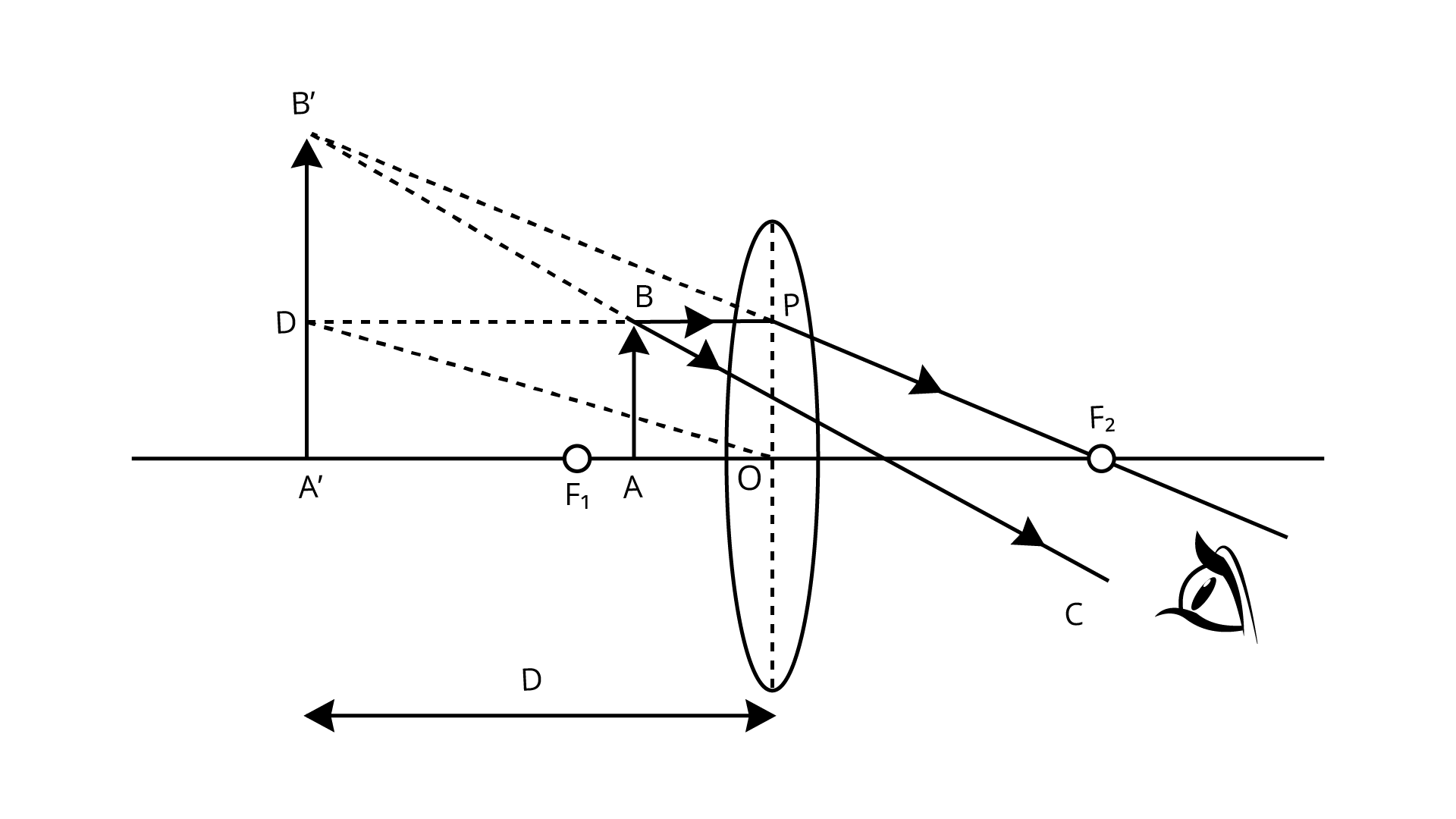
99. Where is the object placed in reference to the principal focus of a magnifying glass, so as to see its enlarged image? Where is the image obtained?
Ans: The object is placed between the lens and principal focus. The image is obtained between the lens and the principal focus.
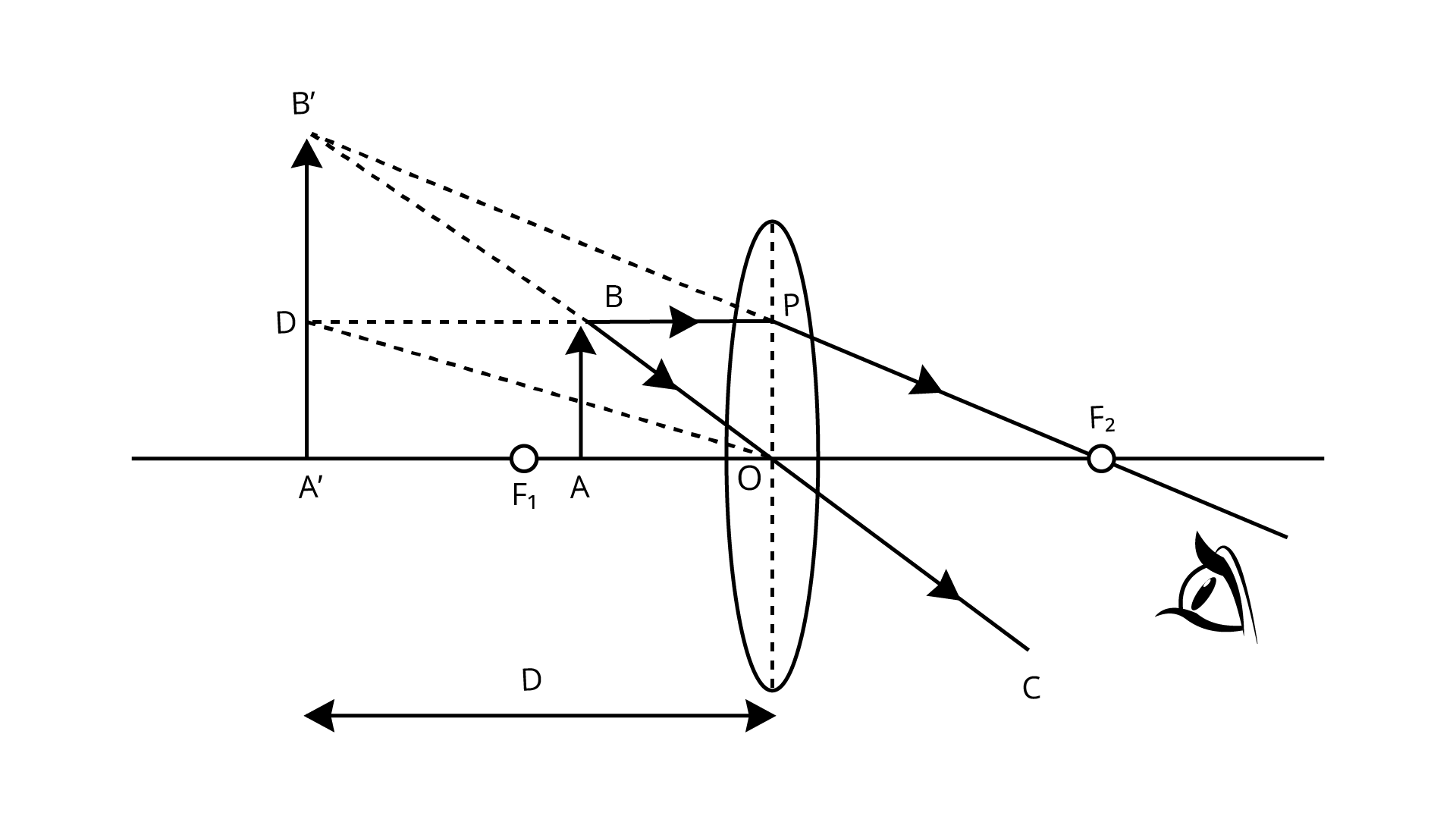
100. Write an expression for the magnifying power of a simple microscope. How can it be increased?
Ans: The magnifying power of the microscope is given as
Magnifying power M = 1 + D / f
Where f is the focal length of the lens and D is the least distance of distinct vision
The magnifying power of the microscope is increased by using the lens of short focal length i.e shorter the focal length, more is the magnifying power. But it cannot be increased indefinitely.
101. State two applications each of a convex lens and concave lens.
Ans: Applications of a convex lens are as follows:
a) The objective lens of a telescope, camera, slide projector, etc, is a convex lens which forms the real and inverted image of the object.
b) Our eye lens is also a convex lens. The eye lens forms the inverted image of the object on the retina.
Applications of concave lens are as follows:
a) A concave lens is used as the eye lens in a Galilean telescope to obtain the final erect image of the object.
b) A person suffering from short sightedness or myopia wears spectacles having concave lenses.
102. Describe in brief how you would determine the approximate focal length of a convex lens.
Ans: The approximate focal length of a convex lens can be determined by using the principle that a beam of parallel rays incident from a distant object converges in the focal plane of the lens.
In an open space, against a white wall, a 0 cm end meter scale is placed horizontally touching the wall. By moving the convex lens to and fro along the length of the meter rule, focus the object on the wall. The image formed on the wall is almost at the focus of the lens and from the image, the distance of the lens is read directly by the meter scale. This gives the approximate focal length of the lens.
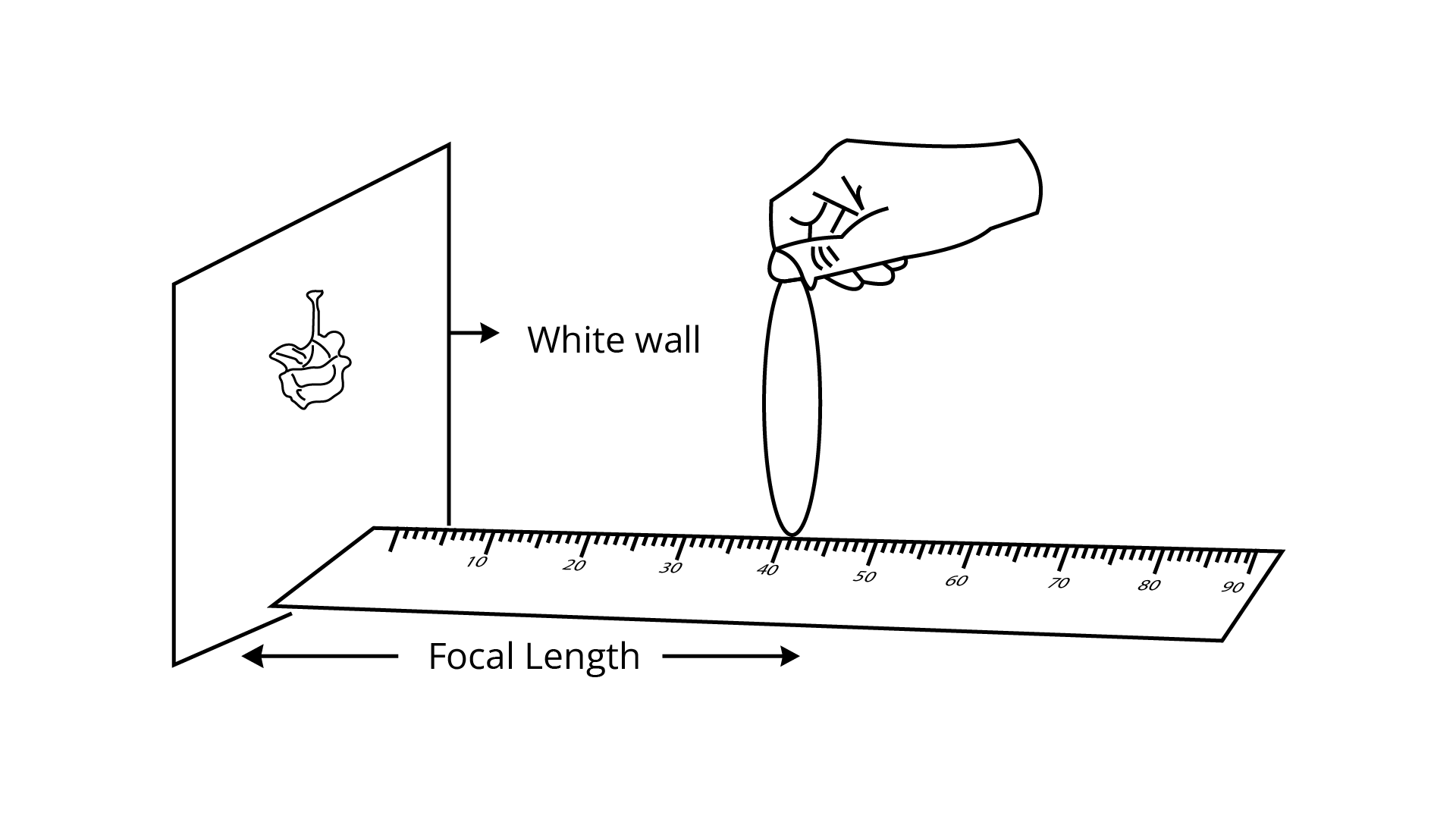
103. The diagram in Fig. shows the experimental set up for the determination of focal length of a lens using a plane mirror.
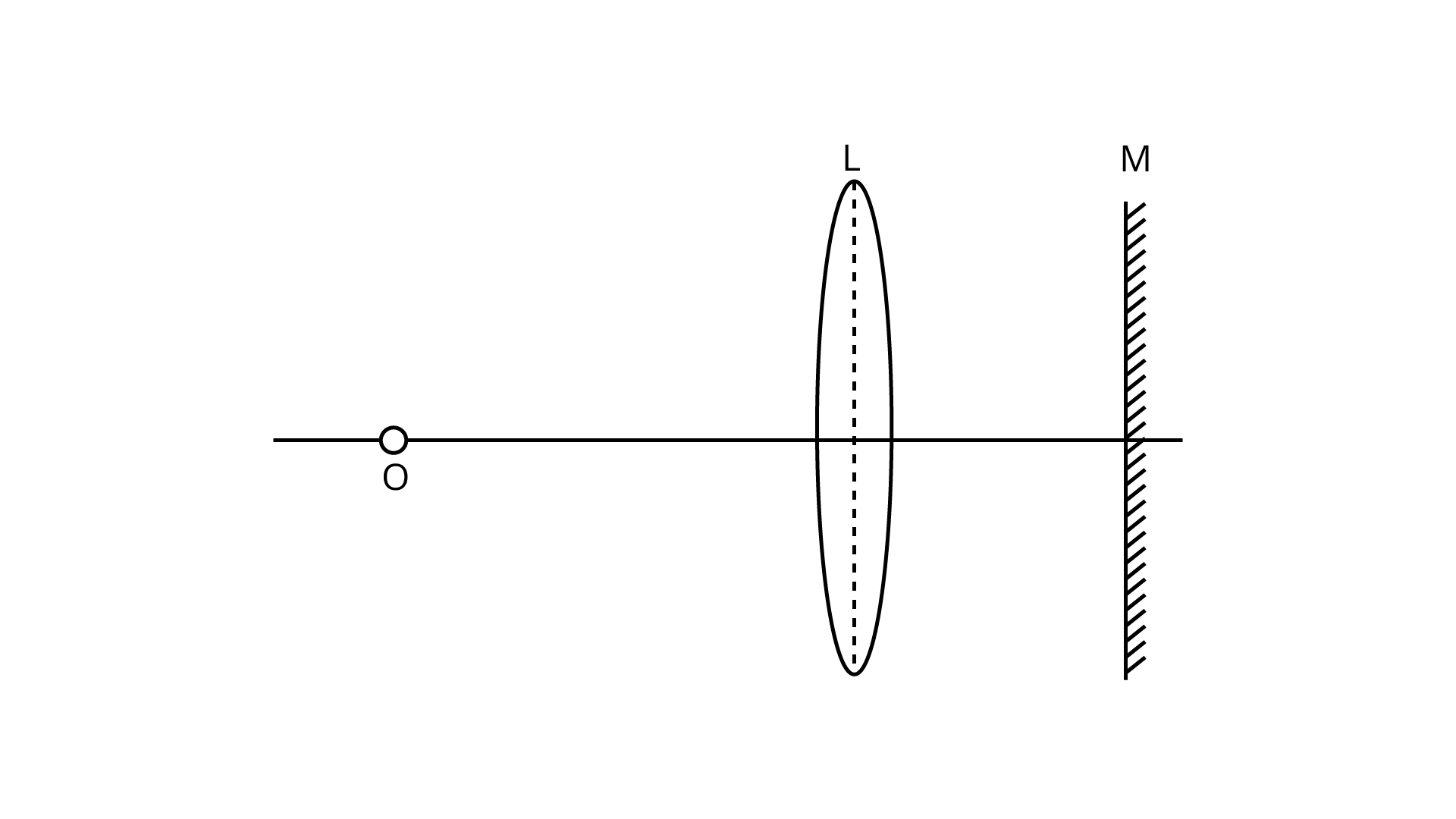
(i) Draw two rays from the point O of the object pin to show the formation of image I at O itself.
Ans:
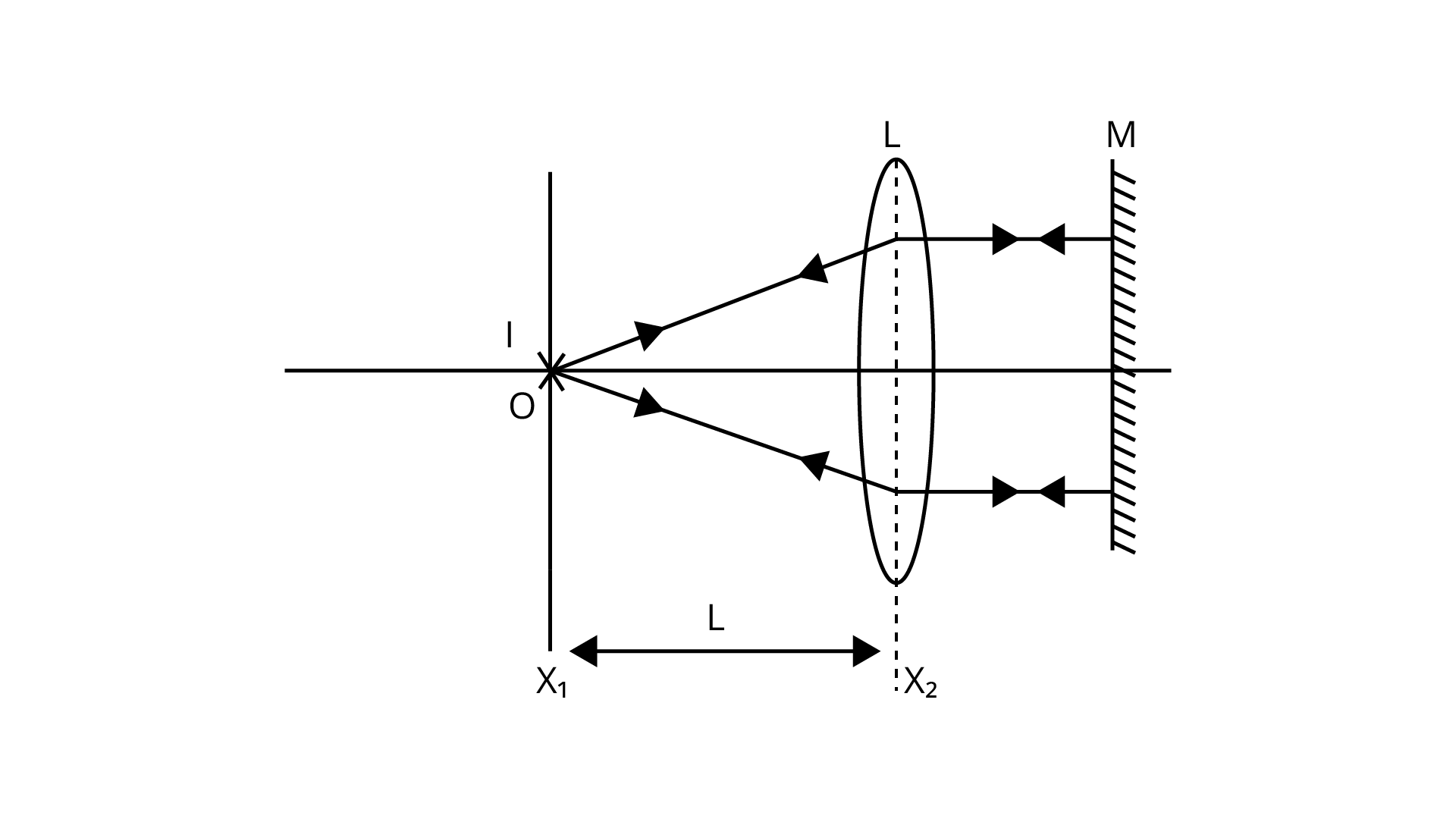
(ii) What is the size of the image I?
Ans: The size of the image will be the same as that of the object.
(iii) State two more characteristics of the image I.
Ans: The image formed will be real and inverted.
(iv) Name the distance of the object O from the optical center of the lens.
Ans: The distance of object O from the optical lens will be equal to the focal length of the lens.
(v) To what point will the rays return if the mirror is moved away from the lens by a distance equal to the focal length of the lens?
Ans: The position of the mirror from the lens does not affect the formation of the image till the rays from the lens fall normally on the plane mirror M.
104. Describe how you would determine the focal length of a converging lens, using a plane mirror and one pin. Draw a ray diagram to illustrate your answer.
Ans: We need a vertical stand, a plane mirror, a lens and a pin to determine the focal length by using a plane mirror. First place the lens L horizontally on a plane mirror MM’. After this, arrange the pin P in the clamp horizontally so that the tip of the pin is vertically above the center O of the lens. Now adjust the height of the pin so it has no parallax with its inverted image as seen from vertically above the pin.
Now we can measure the distance y of the pin from the mirrors and the distance x of the pin P from the lens with the help of a meter rule and a plumb line. Calculate the average of the two distances.
By this we will get the focal length of the lens, i.e f = (x + y) / 2
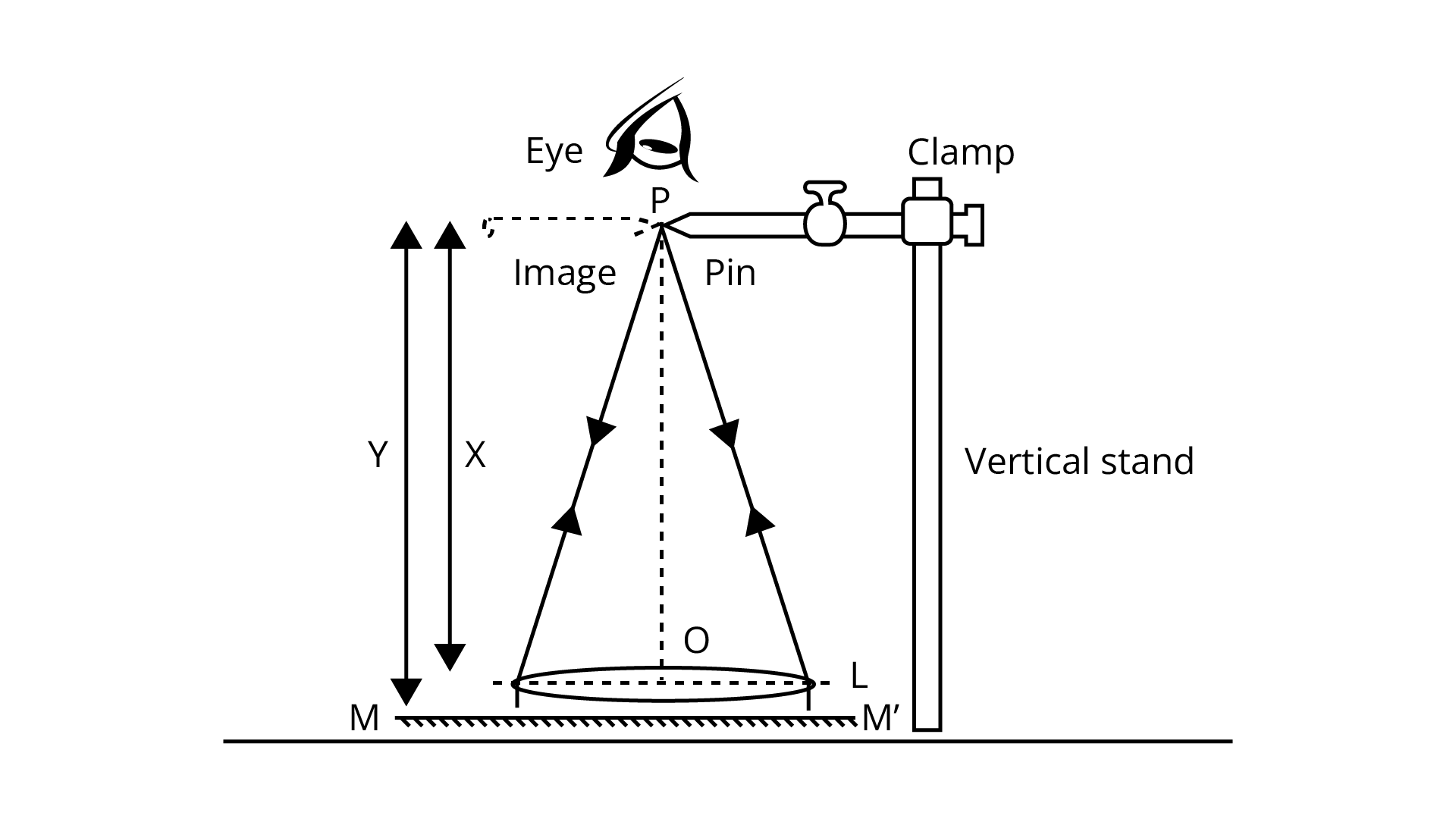
105. How will you differentiate between a convex and a concave lens by looking at,
(i) A distant object
Ans: By watching an object which is at a distance through the lens, if the inverted image is seen the lens is convex if the seen image is inverted and the lens is concave if the upright image is seen.
(ii) A printed page
Ans: If we keep the lens near to a printed page, the lens is convex if letters appear magnified and the lense is concave if the letters appear diminished.
106. A magnifying glass forms:
(a) A real and diminished image
(b) A real and magnified image
(c) A virtual and magnified image
(d) A virtual and diminished image
Ans: A magnifying glass forms a virtual as well as the magnified image. Hence the correct answer is option c.
107. The maximum magnifying power of a convex lens of focal length 5 cm can be:
(a) 25
(b) 10
(c) 1
(d) 6
Ans:
Given as the focal length of the convex lens is f = +5 cm
The magnifying power of the convex lens is m = 1 + D / f
Where D is the distance of the distinct vision
i.e. D = 25 cm
Therefore,
m = 1 + 25 / 5
m = 30 / 5
m = 6
Therefore the magnifying power of a convex lense will be 6.
Hence the correct answer is option d.
Selina Solutions Concise Physics Class 10 Chapter 5 Refraction through a Lens
Selina Solutions Concise Physics Class 10 Chapter 5 Refraction using a lens is mainly about lens research and development in the concepts. A few basic concepts discussed in this chapter are the lens, the action of the lens as a collection of prisms, the technical terms related to the lens, the light resistance of the equi-convex lens and the equi-concave lens. Students can check out Selina Solutions for a quick review before starting their studies.
Selina Physics Solutions Class 10 Chapter 5 Refraction through a Lens is designed to provide more information to students preparing for board exams. The questions are answered step by step and are easy to understand. By referring to them, students can capture the ideas behind the solutions very quickly. This will not only help students by giving them the confidence to answer all kinds of questions in the tests but also ensure that they learn the concepts over time. Selina Physics Chapter 5 Refraction through a Lens Solutions Class 10 focuses on answering the questions correctly to encourage students to get full marks on the test.
Key Features of Selina Solutions Concise Physics Class 10 Chapter 5 Refraction through the lens
Selina Solutions is a reliable resource that students can rely on to better understand the chapter
Selina Solutions available on Vedantu helps students solve difficult questions without obstacles. The refraction chapter consists of several problem sums or numericals which need prior guidance and proper attention while studying. These solid answers help students review after completing the entire syllabus. Revision of the entire chapter becomes easier.
Familiarity with Selina Solutions will improve student preparation for the exams
What are the main topics in Selina Solutions ICSE Physics Class 10 Chapter Refraction through a lens?
1. What is a lens?
2. Set of prisms under the action of a lens
3. Lens and technical terms related to it
4. Equi-convex lens and Equi-concave lens under refraction of light
5. Ray diagrams and principal rays
6. Ray diagram construction for a lens
7. Characteristics and location of images in a convex lens
8. Location of images and characteristics of a concave lens.
9. Differentiate between the image formed by a convex and concave lens.
10. Sign convention of distance measurements
11. Formula related to lens sums
12. Linear magnification
13. Power of a lens
14. Simple microscope or glass magnification
15. Lens application in real-life conditions
16. Determination of focal length of a convex lens in an experiment.
Important Terms
The center of the curvature of the lens is usually represented by the letter C. Since there are two bending centers, it may be as representative as C1 and C2.
The radius of the sphere, the upper part of the lens, is called the radius of curvature of the lens surface.
The imaginary straight line that passes through two lens-bending centers is called its main axis.
The center of the lens is its point of view. It is usually represented by the letter O. A ray of light in the center of the lens can pass without distortion.
The active width of the circular frame of the circular lens is called its aperture.
The lens has two main foci of F1 and F2. F1 is the first focus area and F2 is the second focus area.
The main focus distance from the visual center of the lens is called its focal length. The letter f is used to represent the length of the focus.
F1 initial focus length (distance O from F1).
F2 length of initial focus (distance O from F2).
FAQs on Refraction through a Lens Solutions for ICSE Board Class 10 Physics
1. What is a lens? Name the two types of lenses? Draw drawings to show it. Identify the differences between convex and concave lenses.
The lens is defined as ‘a light-coloured object enclosed by two circular or one spherical surface and the upper plane’. There are two types of lenses - Convex or flexible lens and Concave or reversible lens. The convex lens is thick in the middle and thin at the edges. However, the Concave lens is thinner in the middle and thicker at the edges. The Convex lens covers the rays of the event toward the main axis. The concave lens separates the incident rays away from the main axis. The Convex lens has a real focus. The concave lens has a clear focus.
2. Mention the sign agreement to measure lens distances.
The axis for measuring distances is called the main axis in the class 10 chapter refraction through a lens. These distances are measured from the visual center of the lens. The distances measured in the direction of the incident ray are taken positive, while the distances opposite to the direction of the incident ray are taken negatively. The distance of the object from the lens is denoted by u, the distance of the image by v and the distance of the second focus by f.
3. Distinguish between real and virtual images.
An image formed when the light rays converge at a particular point after refraction and reflection are known as a real image. An image formed when rays appear to meet a particular point after the reflection from the mirror is known as a virtual image. The real image is created due to the actual contrast of the radiation opposed by the lens. Visual imagery is made when double-lens radiation appears to coalesce when produced in retrospect. The real image can be found on the screen. A visual image cannot be found on the screen. The real image is distorted in relation to the object. The visual image stands in relation to the object.
4. Is revision of the entire syllabus of Selina Class 10 Physics Chapter Refraction using a lens important?
Revision of every topic and small detail is very important in understanding the concept better and getting good marks, and in Review, Review Notes are always considered the best. ICSE Class 10 Physics Chapter 5 Refraction to Using Lens Revision Notes is one of the most important parts of a student's learning experience, as it will help them learn better and reduce the level of stress that students experience during a busy year. The experts design the syllabus in accordance with the proficiency level of students. The students need to keep a check on everything before sitting for the board exam.
5. Write a lens formula that explains the meaning of the symbols used.
The lens formula applies to all cases with appropriate markings. This lens formula works on both concave and convex lenses. If the figure shows the distance of the negative image, then the image is an image on the same side of the lens as the object.
Lens formula = 1 / v - 1 / u = 1/f
Where the distance of the object from the center of the view is called the object distance (u). And Image distance from the center of the view is called image distance (v). The main focus distance from the center of the view is called the fixed length (f).









































